Media-Technology and Opera History
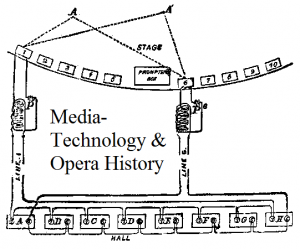 Below are most of the posts and comments that have appeared on the LinkedIn Media-Technology and Opera History group. As more are posted, they will be added here. Unless otherwise noted, all posts and comments are by me.
Below are most of the posts and comments that have appeared on the LinkedIn Media-Technology and Opera History group. As more are posted, they will be added here. Unless otherwise noted, all posts and comments are by me.
To get directly to what you want, do a browser search for a category or word of interest. The easiest way to search for the headings is to enter their number, including the period after it. In a few cases, you might be taken to a year at the end of a sentence, but a click or two more will get you where you want to go.
1. Post About Opera and Live Sound Media (2011 December 27)
2. Fandom of the Opera Lectures (2011 December 29)
3. Digital Audio, Opera, and the Met: When, How, Why, and What Was Used? (posted by Jim Lindner 2011 December 29)
4. Opera and the Oldest Photographic Motion-Picture Patent (2011 December 31)
5. Opera and the Birth of Free Matchbooks (2012 January 7)
6. How Opera Created Pay-Cable (2012 January 9)
7. Was Opera Responsible for Modern Satellites? (2012 January 11)
8. Why Opera Audiences Were Media Ready (2012 January 25)
9. How Opera Drove Videodisc Subtitling (posted by Simon Hailes 2012 February)
10. How Opera Helped Make Pelé a Sports Star (2012 February)
11. Edison, Opera, and Television (2012 March)
12. Opera and Theatrical Television (2012 March)
13. Opera and Alternative Content for Cinema — and Baseball (2012 March)
14. Opera and Lighting, Libretti, & Language (2012 April)
15. Opera, Live Television, and John Goberman (2012 April)
16. More Baseball & Opera (2012 April)
17. Opera and the First Wireless Sound Broadcast (June 2012)
18. Opera and Television – Canada Day Special (2012 July 1)
19. The Earliest Opera Recordings (2012 July)
20. More on the Baseball-Opera Hotel (2012 July)
21. Playback of Opera before the Advent of Recording (2012 July)
22. Why Is Soap Opera Called Opera? (2012 July)
23. A Little about Opera and Film Sound (2012 July)
24. Opera and the First Million-Selling Recording (2012 August 2)
25. What Was The First Opera Playback? (2012 August)
26. More on Lighting (2012 August 26)
27. Richard Tucker and the Emotion Light (2012 August 28)
28. Operas, Scores, and Movies (2012 October 9)
29. “No opera, no X-rays!” (2012 October)
30. Baseball at the Opera House and Opera in the Ball Park (2012 October)
31. The First Opera Broadcast and the 200-Ton Musical Instrument (2012 October)
32. Opera and Street Organs (2012 October)
33. Discs before Discs: the First Opera for the Masses (2012 November)
34. Opera Furniture (2012 December)
35. Opera and the Development of HDTV (2012 December)
36. The First Opera Seen Live ‘Round the World (2012 December)
37. 160 Years of Movie Technology and Opera (2012 December)
38. Opera & Media: A Very Good Year (2013 January 5)
39. “The Greatest Invention,” Said Tom Swift Operatically (2013 January 13)
40. Opera & the Media: It’ll Never Fly (2013 January 20)
41. Opera and the Invention of Broadcast Rights (2013 January 24)
42. Opera House Video Production (posted by Winston Tharp 2013 February)
43. Opera and the Invention of Lip-Synching (2013 February 3)
44. Super-soprano and the Ceno-orchestra! (2013 February 10)
45. Opera and Medical Media Technology (2013 February 16)
46. Opera and the Invention of Electronic Home Entertainment (2013 March 2)
47. Opera and U.S. Commercial Television (2013 March 9)
48. The First Opera Cinemacast (2013 March 21)
49. Movies at the Opera instead of Opera at the Movie theater? (posted by Pete Ludé 2013 March 22)
50. Opera and the Plazacast (2013 March 23)
51. Opera and the Advent of Color Television (2013 April 6)
52. The Eidoloscope and the Opera That Wasn’t (2013 April 13)
53. Opera and Stereoscopic 3D (2013 April 20)
54. Opera and Stereo Sound (2013 April 27)
55. Opera and the Invention of the Newscast (2013 May 19)
56. Public Executions, Prostitution, and the First Opera House (2013 June 4)
57. Opera and the First Snapshot (2013 June 13)
58. Opera and Neutrinos (2013 June 22)
59. Unstageable Operas (2013 June 29)
60. Opera and Eye (2013 July 10)
61. Opera and Radioactive Music (2013 July 21)
62. Opera and Outer Space (2013 August 1)
63. Opera, the Navy, and Radio (2013 August 16)
64. The Tenor, the Impresario, and the Invention of Electronic Home Entertainment (2014 March 11 – updated version of discussion 46)
65. Inside-Out (2014 April 2)
66. Opera Streamed in Beyond-HDTV Resolution (2014 May 5)
67. The First Parabolic Mic (2015 August 28)
68. Sports, Opera, and Pay-Cable (2015 October 9)
69. The First Bootleg Recording (2016 February 24)
70. Happy 54th Birthday, Rossini, Fax Pioneer (2016 February 29)
71. The Impresario Who Invented the Movie Theatre (2016 November 18)
72. The Polish Polymath Who Came Up with Opera for Television — in 1878 (2017 February 10)
73. Virtual Reality Opera (2017 June 27)
1. Post About Opera and Live Sound Media (2011 December 27)
Here is a blog post I did in January 2010 about the 100th anniversary of opera radio broadcasts. I have some more-recent info, but this is a good overview: https://staging.sportsvideo.org/blogs/?blog=schubin-cafe&news=100th-anniversary-today
2. Fandom of the Opera Lectures (2011 December 29)
I give illustrated lectures on the subject of The Fandom of the Opera: How the Audience for a Four-Century-Old Art Form Helped Create the Modern Media World. You can find many of them in the download section of SchubinCafe.com: https://staging.sportsvideo.org/blogs/?blog=download
Some are also available on YouTube. Search for schubin opera.
3. Digital Audio, Opera, and the Met: When, How, Why, and What Was Used? (posted by Jim Lindner 2011 December 29)
While working on a Met audio archive remastering project some years ago, I came upon some very early digital audio recordings that used the U-matic format to record on: the somewhat infamous PCM-1600. I had worked with them occasionally many years ago when they were being used but never saw them in routine use, nor did I ever see that many PCM-1600 recordings in any other vault of any other archive. I was particularly surprised to find them in the collection of the Met, as these devices were pretty unusual to find and were almost always in studios and more for experimentation then real day to day work. Clearly someone was experimenting and taking some risks. Was that you Mark? I would be interested to learn about the first experimentation with digital audio at the Met and other opera houses and how the PCM-1600 came to be used at the Met on such a routine basis.
Mark Schubin: Digital audio and opera actually goes back a little farther, to 1976. Two things happened that year, both related to one of only two people to have won an Academy Award, an Emmy, and a Grammy as well as awards from the Audio Engineering Society, the Institute of Electrical and Electronics Engineers, and the Society of Motion-Picture and Television Engineers: Tom Stockham (the other winner of all of those awards is Ray Dolby, who sits on the board of San Francisco Opera).
Stockham’s opera connection actually began in a non-audio area. I met him at an exhibition I put together at the Library of the Performing Arts in 1975. It was called “The Performing Arts and the Future of Television.” One of the exhibits related to the huge contrast range encountered on an opera stage, from a star in white sequins illuminated by a spotlight to a villain in black velour hidden in the shadows. Stockham suggested a way to compress the contrast using an electronic technique similar to photographic unsharp masking, and we actually built a contrast compressor that would work that way.
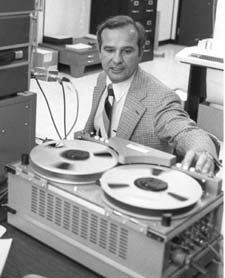 Back in sound, Stockham developed the first commercial digital-audio recording system, Soundstream, based around a one-inch-tape instrumentation recorder and a rack of equipment. He made the first commercial digital-audio recording, Santa Fe Opera’s 1976 production of “The Mother of Us All.” He also made Soundstream recordings at the Met, but I can’t remember when, so I’m not sure if they were before Santa Fe or after (they weren’t released in any case).
Back in sound, Stockham developed the first commercial digital-audio recording system, Soundstream, based around a one-inch-tape instrumentation recorder and a rack of equipment. He made the first commercial digital-audio recording, Santa Fe Opera’s 1976 production of “The Mother of Us All.” He also made Soundstream recordings at the Met, but I can’t remember when, so I’m not sure if they were before Santa Fe or after (they weren’t released in any case).
As for the PCM-1600, that was the recording system used for the first CDs. We started using it at Live from Lincoln Center in a Sony demonstration and then continued using it at the Met. I think the Met has, at one time or another, used just about every audio recording format that ever existed, from Edison cylinders to current multitrack digital recordings on different tapeless systems (so that, if a bug is discovered in one company’s software, the other recordings remain safe).
Another comment: Oops! I forgot to mention Stockham’s other 1976 digital-audio opera achievement.
The famous tenor Enrico Caruso made many recordings. He was, in fact, hired to sing at the Met on the basis of one of his recordings (the Met’s general manager heard it). It is likely that one version of his recording of the aria “Vesti la giubba” from Pagliacci was the earliest recording to sell a million copies (it has never been unavailable since it was recorded), though the first millionth-copy sale might have been a country song by Vernon Dalhart (who was an opera singer before he became a country singer).
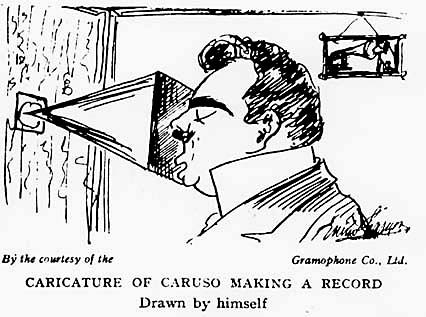 Caruso’s recordings were made in the “acoustic” recording era, when sound waves from the singer’s voice were recorded directly, with no microphones involved. To do that, the singer sang into a funnel (called a horn). Caruso even drew a picture of himself doing that.
Caruso’s recordings were made in the “acoustic” recording era, when sound waves from the singer’s voice were recorded directly, with no microphones involved. To do that, the singer sang into a funnel (called a horn). Caruso even drew a picture of himself doing that.
Stockham wanted to know what Caruso really sounded like, without the distortion introduced by the horn. So he mathematically processed the sound through a technique called blind deconvolution to restore the actual sound of Caruso’s voice. And, in 1976, he released the album Caruso: A Legendary Performer, with digitally processed acoustically recorded opera arias.
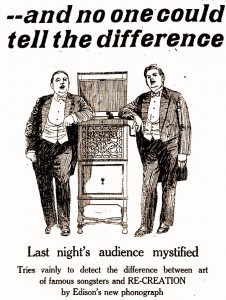 One final note: When Thomas Edison switched from cylinder to disc, he decided to use opera to promote his system in a series of “Tone Tests.” In small locations, listeners would be blindfolded and asked whether they were hearing a live singer or a recording. In large locations (such as Carnegie Hall), an opera singer might start singing, then the lights would go out, and, when the lights came back up, only Edison’s Diamond Disc Phonograph would still be on stage.
One final note: When Thomas Edison switched from cylinder to disc, he decided to use opera to promote his system in a series of “Tone Tests.” In small locations, listeners would be blindfolded and asked whether they were hearing a live singer or a recording. In large locations (such as Carnegie Hall), an opera singer might start singing, then the lights would go out, and, when the lights came back up, only Edison’s Diamond Disc Phonograph would still be on stage.
Amazingly to us, even in the acoustic-recording era, audiences said they couldn’t tell the difference! But the most-popular Tone Test singer, opera soprano Anna Case, confessed much later that she had trained herself to sound like a phonograph recording of herself.
You’ll find more about Stockham’s work (including a photo of the Soundstream recorder and Caruso’s drawing) here: https://staging.sportsvideo.org/blogs/?blog=schubin-cafe&news=the-blind-leading
4. Opera and the Oldest Photographic Motion-Picture Patent (2011 December 31)
I just posted something on SchubinCafe.com about how old stereoscopic 3D display systems are. The end of the post is about Jules Duboscq, head of special effects at the Paris Opera in the middle of the 19th century: https://staging.sportsvideo.org/blogs/?blog=schubin-cafe&news=3d-the-next-big-thing
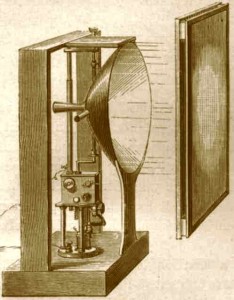 He got to be head of special effects there by creating an electric-light sunrise effect for the opera Le prophete in 1849, 30 years before Thomas Edison’s light-bulb demo. Duboscq used an electric arc, which is interesting enough, but he needed to power it, and there was no power company, so he built a power room in the opera house using Bunsen-cell batteries, which emit toxic fumes. So Duboscq developed a fume-precipitation system, later praised in Nature magazine. He later created special effects on the opera stage with an electric-light rainbow, and an electric-light fountain.
He got to be head of special effects there by creating an electric-light sunrise effect for the opera Le prophete in 1849, 30 years before Thomas Edison’s light-bulb demo. Duboscq used an electric arc, which is interesting enough, but he needed to power it, and there was no power company, so he built a power room in the opera house using Bunsen-cell batteries, which emit toxic fumes. So Duboscq developed a fume-precipitation system, later praised in Nature magazine. He later created special effects on the opera stage with an electric-light rainbow, and an electric-light fountain.
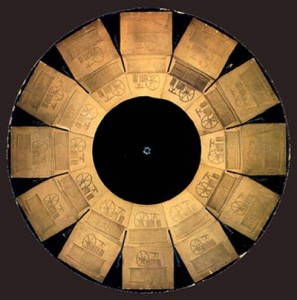 Meanwhile, he also patented a 3D viewer (a stereoscope) in 1852 and, in an addendum to the patent the same year, showed how it could be used with photographic motion pictures (a quarter century before even Muybridge). It is certainly the first 3D movie patent, but it also appears to be the first patent for photographic motion pictures of any kind.
Meanwhile, he also patented a 3D viewer (a stereoscope) in 1852 and, in an addendum to the patent the same year, showed how it could be used with photographic motion pictures (a quarter century before even Muybridge). It is certainly the first 3D movie patent, but it also appears to be the first patent for photographic motion pictures of any kind.
There’s an image of one of his surviving 3D movie discs (perhaps the only surviving one) in the post. Happy New Year!
Comments:
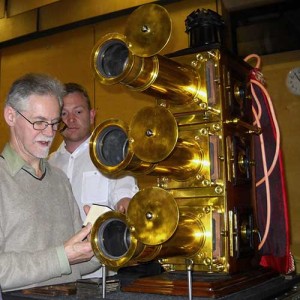 Jim Lindner: Your posting started me thinking pre-photography again (and maybe documented although pre-patent as well). Perhaps the impetus was not your article but because I saw “Hugo” a few weeks ago, but, either way, your comment about Duboscq started me thinking about projection that “appeared” to the audience to be 3D or real. So with that wider aperture one can take a much further view back, which at the moment has me going back past the stereopticon to the magic lantern which most certainly would “count” as being theatrical presentation and with the ability to show multiple images simultaneously, as shown in this lovely picture from the Magic Lantern Society: http://www.magiclantern.org.uk/
Jim Lindner: Your posting started me thinking pre-photography again (and maybe documented although pre-patent as well). Perhaps the impetus was not your article but because I saw “Hugo” a few weeks ago, but, either way, your comment about Duboscq started me thinking about projection that “appeared” to the audience to be 3D or real. So with that wider aperture one can take a much further view back, which at the moment has me going back past the stereopticon to the magic lantern which most certainly would “count” as being theatrical presentation and with the ability to show multiple images simultaneously, as shown in this lovely picture from the Magic Lantern Society: http://www.magiclantern.org.uk/
Most certainly, as you can see, these projectors are designed to all focus on the same screen area and almost certainly just the smallest offset as to provide a device that certainly was technically capable of stereoscopic display, even if by accident. So one then starts going back (visual of calendar pages flipping) way back past the Phantasmagoria (which certainly would meet this broader criterion) past Walgensten (who was in the public ghost summoning business), and there certainly were others doing it at that time to the 1650’s or so – where I am currently learning about Kircher who shows an illustration of a lensless projector which would seem to be capable of producing 3D apparitions for an audience in a very very dark room. I am trying to get a copy or reprint of his book to see it for myself, although this picture from the Princeton Library is pretty convincing: http://library.princeton.edu/libraries/cotsen/exhibitions/MagicLantern/Images/Regular/ML4.jpg
The Magic Lantern Society goes (I think) a bit too far with Giovanni de Fontana as the inventor of the Magic Lantern for our slightly tighter definition: that being a device that is both documented and capable of convincing audiences at that time of the 3D reality of the image cast ….. his is, at best, poorly defined and it would be hard to believe that the apparition cast would be believable as “real”. So I think that audiences have been thrilled with “real” 3D images for a very, very, long time.
Mark Schubin: Thanks, Jim!
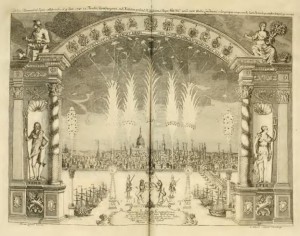 I’ll probably do another post some day on the use of projection in opera. It is well documented back to 1726 in Hamburg using magic lanterns with moving-image slides (in one 1727 Hamburg production, there were motion fireworks). I cannot (yet) confirm the motion apparatus used there then, but it was common in the 19th century to have elaborate geared slides that could depict flowing fountains and the like.
I’ll probably do another post some day on the use of projection in opera. It is well documented back to 1726 in Hamburg using magic lanterns with moving-image slides (in one 1727 Hamburg production, there were motion fireworks). I cannot (yet) confirm the motion apparatus used there then, but it was common in the 19th century to have elaborate geared slides that could depict flowing fountains and the like.
The projector used in Hamburg in 1726 was made by Pieter van Musschenbroek in Leiden in 1720. It can be seen (along with several motion-image slides) at the Boerhaave Museum in Leiden (it’s an easy trip from the Rai conference center where the International Broadcasting Convention takes place).
The “lensless” projector in Kircher’s book is generally considered to be either an error on his part or an intentional misdirection.
By the way, in 1986, The Magic Lantern Society published a magnificent book by Franz Paul Liesegang, Dates and Sources (translated and edited by Hermann Hecht) with not only magic-lantern history (“stereopticon” is a synonymous term; “stereoscope” is the term for a 3D viewer) but also cinematography’s history.
More recently (as in this opera season), digital projection has been used extensively in opera. At the Met, the Ring cycle, Damnation of Faust, Faust, Dr. Atomic, and the new Enchanted Island all rely heavily on digital projection.
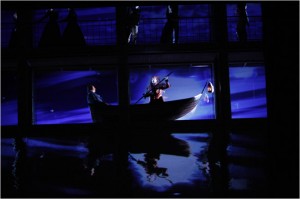 In Damnation of Faust, there’s a scene in which a gondola is being poled across the stage, the vessel and its occupants reflected in the rippling water — except there’s no water. Cameras pick up the action on the stage and feed it into computer-graphics engines, which, in turn, feed warp engines to adjust for the projection surfaces, which feed multiple overlapped projectors.
In Damnation of Faust, there’s a scene in which a gondola is being poled across the stage, the vessel and its occupants reflected in the rippling water — except there’s no water. Cameras pick up the action on the stage and feed it into computer-graphics engines, which, in turn, feed warp engines to adjust for the projection surfaces, which feed multiple overlapped projectors.
In Das Rheingold, the projection surface is “The Machine,” a sort of rotisserie spit carrying 24 long planks, each of which can rotate around the x-axis. Six projectors project from the front and three from the top, and, no matter what The Machine or any of the planks does, the projection looks painted on. The interactivity, in this case, not only allows gravel to fall down the riverbed as the Rhinemaidens swish their mermaid tails but also puts the greatest “flow of bubbles” above the mouth of the one singing loudest.
Siegfried does all that and adds depth planes appropriate to wherever any portion of any plank happens to be. Early in the opera, there appears to be a gigantic rotating root structure that audience members can see through. The whole thing is “just” selective depth-plane projections on the rotating planks. People from the computer-graphics realm all over the world have been calling the Met daily asking, “What did you do today?” And it’s all live on stage, following a different opera being rehearsed that morning and afternoon.
You can hear me discuss some of the old and new in this NPR interview: http://www.npr.org/2011/11/06/142018443/how-opera-helped-create-the-modern-media-world
5. Opera and the Birth of Free Matchbooks (2012 January 7)
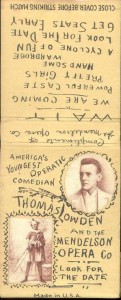 Tomorrow’s New York Times Magazine has a story about matchbooks, including how the Mendelson [sic] Opera Company created the first matchbook advertising (hand written, but with tiny photos attached). That story puts the date at 1889, though some phillumenists put the date at 1895 or 1896. The opera company gave out the matchbooks promotionally (100 or 200 of them, depending on research source).
Tomorrow’s New York Times Magazine has a story about matchbooks, including how the Mendelson [sic] Opera Company created the first matchbook advertising (hand written, but with tiny photos attached). That story puts the date at 1889, though some phillumenists put the date at 1895 or 1896. The opera company gave out the matchbooks promotionally (100 or 200 of them, depending on research source).
According to the story, a salesperson for the matchbook company thought it was a good idea and pitched it to the Pabst Brewing company, which ordered 10 million. Duke Tobacco took 30 million, and Wrigley Gum a billion. The advertising paid for the matchbooks, so they were given away free.
The Times story is here: http://www.nytimes.com/2012/01/08/magazine/who-made-that-matchbook.html
This link has a photo of what’s supposed to be the original: http://matchpro.org/Matchbookhistory.html
Comment: I’ve done a bit more research. Page 18 of the December 8, 1894 issue of The New York Dramatic Mirror seems to indicate that Thomas Lowden had already left what was really known as the Mendelssohn Opera Company (the matchbook shown in the link above was misspelled). That suggests that the 1889 date is correct.
Joshua Pusey filed his patent for the matchbook in 1889, so it’s conceivable the promotion was that year. It couldn’t have been too much later, as Lowden died in 1898.
Another comment: The plot thickens!
I’m happy to correct The New York Times when they make a mistake in an area in which I have some expertise, such as the development of headphones (the first consumer versions appear to have been created for opera; you’ll find more here: https://staging.sportsvideo.org/blogs/?blog=schubin-cafe&news=headphones-history-hysteria).
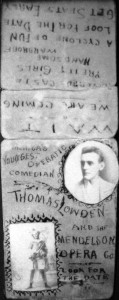 I am definitely not an expert on matchbooks. But the clean, recent-looking printing of the “CLOSE COVER BEFORE STRIKING MATCH” on the opera-promoting matchbook cover bothered me, so I’ve been looking around some more, and I came across this: http://www.docstoc.com/docs/17059430/Diamond-Match-Company-Manumarks-_Diamond-Quality_
I am definitely not an expert on matchbooks. But the clean, recent-looking printing of the “CLOSE COVER BEFORE STRIKING MATCH” on the opera-promoting matchbook cover bothered me, so I’ve been looking around some more, and I came across this: http://www.docstoc.com/docs/17059430/Diamond-Match-Company-Manumarks-_Diamond-Quality_
Note that it begins with a disclaimer about disagreements, so this might not be definitive, but, according to this piece, “CLOSE COVER BEFORE STRIKING MATCH” did not appear on Diamond Matchbooks until 1912.
Hmm.
Another comment: This site suggests that neither the “CLOSE COVER BEFORE STRIKING MATCH” nor the Diamond Match attribution is correct. There’s a different matchbook (right). That means the opera matchbook could be older, but the author of the linked post doesn’t think it was the first: http://www.titanicitems.com/matchbooks.htm
6. How Opera Created Pay-Cable (2012 January 9)
Here is another SchubinCafe post, this one on the 125th anniversary of pay cable: https://staging.sportsvideo.org/blogs/?blog=schubin-cafe&news=125th-anniversary-of-pay-cable
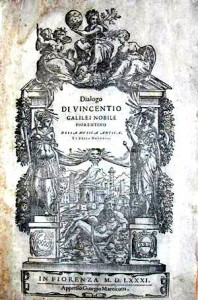 7. Was Opera Responsible for Modern Satellites? (2012 January 11)
7. Was Opera Responsible for Modern Satellites? (2012 January 11)
This one’s quite a stretch, but the origin of the geostationary satellite orbit (used by almost all satellites that carry television signals) can be traced back to a book (left) published in 1581. And, according to many scholars, the same book laid out the principles of opera.
If you’re interested, try the link. You will learn why Galileo is called Galileo: https://staging.sportsvideo.org/blogs/?blog=schubin-cafe&news=satellites-are-really-old
8. Why Opera Audiences Were Media Ready (2012 January 25)
The first electronic medium able to carry sound was the telephone. In the opera world, it took off like wildfire:
– 1876 – New York Times article saying it could be used to carry opera to homes
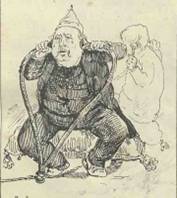 – 1878 – First opera transmission
– 1878 – First opera transmission
– 1880 – First electronic home entertainment (opera)
– 1881 – First stereo-sound transmission (opera)
– 1882 – First payment for opera by phone
– 1885 – First pay-cable subscription (for opera)
– 1887 – First international media event (opera)
– 1888 – Consumer headphones for opera (might have been earlier)
– 1889 – First coin-operated entertainment (opera)
– 1893 – First newscast (created for opera-by-phone service)
I think one can’t help but wonder why this adoption occurred so fast. There’s a clue in that 1876 New York Times article.
It was published on March 22 of that year, before Alexander Graham Bell’s announcement. It said, “No man who can sit in his study with his telephone by his side, and thus listen to the performance of an opera at the Academy, will care to go to Fourteenth Street and to spend the evening in a hot and crowded building.”.
 Today, you can attend operas at a theater near Stockholm called the Drottningholms Slottsteater (Drottningholm Court Theater). It was built in 1766 and, for various reasons, fell into disuse. Rediscovered in the 20th century, it needed only new rope for 18th-century stage machinery. With nothing but human power, it can effect a complete scene change in as little as four seconds. It has elevators, machinery for flying singers around, thunder and ocean effects, and more. You can watch a video of it in operation here: http://dtm.se/visningar/bakom_kulisserna.asp
Today, you can attend operas at a theater near Stockholm called the Drottningholms Slottsteater (Drottningholm Court Theater). It was built in 1766 and, for various reasons, fell into disuse. Rediscovered in the 20th century, it needed only new rope for 18th-century stage machinery. With nothing but human power, it can effect a complete scene change in as little as four seconds. It has elevators, machinery for flying singers around, thunder and ocean effects, and more. You can watch a video of it in operation here: http://dtm.se/visningar/bakom_kulisserna.asp
I found the opera house “hot and crowded” when I was there in mid-summer, but that was nothing compared to what the original patrons must have felt. As a concession to modern fire codes, an elaborate fiber optic system delivers the light of one candle to each former candle location used for stage lighting. Imagine when it was lit by candles.
In addition to heat, a candle would typically consume as much oxygen as two large people. Prior to the middle of the 19th-century, candles were also stinky, smoky, & sometimes toxic, and the wicks didn’t get consumed, so performers periodically had to snip them. Patrons sometimes complained that they couldn’t see performers through the smoke.
The audience section of the opera house never got completely dark. Wax would sometimes drip on the audience from chandeliers, and the light level has been described as equivalent to about one 75-watt bulb lighting the entire auditorium of the Drury Lane opera house.
Oil and gas eliminated the dripping-wax problem, and gas could even be dimmed, but open flames still generated heat. Ventilating and Heating by John Shaw Billings, a book published by The Engineering Record in 1893, includes a study of Manchester’s opera houses. At the Theatre Royal, on a day and at a time when the temperature on Peter Street outside the opera house was 36 degrees Fahrenheit, the temperature in the gallery (a balcony seating area) was 121. At the same time, the carbon dioxide concentration on the street was 530 parts per million; in the gallery it was 1,690. There were also three times as many microorganisms in the gallery as on the street.
That was actually one of the better theaters. Its patrons tended not to die. But, in addition to sweating, they sometimes came close to freezing.
One reason they didn’t die is that the hot, low-oxygen, high-carbon-dioxide air was vented out the top of the building. But nature abhors a vacuum, so fresh air came in at the bottom; if it was freezing outside, it was almost as cold at some points inside.
Media? Hooray!
9. How Opera Drove Videodisc Subtitling (posted by Simon Hailes 2012 February)
I’ve worked for Screen Subtitling Systems since 1992. When I joined, I was surprised to find out about some of the more unusual uses for subtitles. At the time, videodiscs (12″) were on the wane for films, having had their day as a high quality but cumbersome medium, replaced by the much more commercial VHS. However, VHS did not have the bandwidth to carry much in the way of subtitles. The best they could do was a form of US Closed Captions, intended for own-language captions for the deaf. Videodisc, however, provided close to full PAL bandwidth, and so teletext data could be coded directly as part of the video, and had the capacity to carry multiple languages of subtitles.
We had one customer who basically had the market cornered for subtitling opera videodiscs, using the full multi-lingual capability of our systems to put as many as 16 languages of translation in a single VBI [vertical blanking interval]. It also highlighted differences in subtitling styles according to requirements, since, in general, people who purchased videodiscs of opera generally appreciated quality, their TV sets were generally large, and so single-height subtitles could be used, minimizing the area of the video covered when subtitles were on screen. This is still the only case where I’ve found single-height teletext used for subtitling regularly.
Comments:
Mark Schubin: When opera first appeared on LaserDisc, VHS was hugely outselling it in ordinary home-video releases. But the Met Opera’s LaserDisc sales were comparable to their VHS sales; buyers wanted the extra quality.
By the way, there’s quite a long history of (sub)titles for opera. Some opera historians think it began in 1983 with Canadian National Opera’s Surtitles. But, in 1976, the PBS telecast of Barber of Seville from New York City Opera in the Live from Lincoln Center series had live subtitles — thought to be the world’s first live television subtitles.
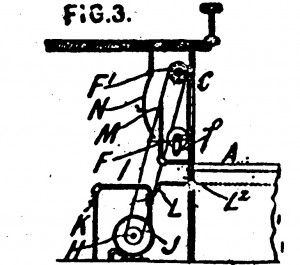 Then there was the British patent issued to Thomas Lloyd Jones and William Robert Lake. It “relates to apparatus for exhibiting the libretto of a performance simultaneously with its delivery.” It is patent 4267, issued October 1, 1881. It placed illuminated titles on a rolling, flexible medium on either side of a stage proscenium. The illumination came from gas jets!
Then there was the British patent issued to Thomas Lloyd Jones and William Robert Lake. It “relates to apparatus for exhibiting the libretto of a performance simultaneously with its delivery.” It is patent 4267, issued October 1, 1881. It placed illuminated titles on a rolling, flexible medium on either side of a stage proscenium. The illumination came from gas jets!
Patrick von Sychowski: I’d be interested to know if the VD/LD subtitles were re-used surtitles used on-stage of the live performance of the opera, and if so, what trans-coding was required. For home releases of feature films, I’ve been told that the same subtitles (whether foreign>English or English>foreign) could not be used from the cinema release as there was less character space on LDs/VHSs, so the text had to be shorter. Of course, this was most likely a feature of the smaller CRT sets of that time, as I’m sure longer text could be coded even for the sub-PAL low-res LD/VHS resolution.
Mark Schubin: I can report that the early Metropolitan Opera and New York City Opera television subtitles were created from scratch by subtitlist Sonya Friedman (neither opera company had any in-house titles at the time). The Met broadcast titles were used on their home-video releases. TV opera subtitles are about eight years older than in-house surtitles.
10. How Opera Helped Make Pelé a Sports Star (2012 February)
The year was 1958. The International Federation of Association Football (FIFA, based on its name in French) had scheduled its quadrennial World Cup for Sweden. Naturally, the national television broadcaster, Sveriges Radio Television (SVT), wanted to cover the matches live for the European Broadcasting Union’s Eurovision network. But there seemed to be a problem.
Although Eurovision, itself, wasn’t created until 1954, the first test transmissions of television in Sweden didn’t occur until after Eurovision’s first network transmission. Actual broadcasting (from what was then called Radiotjänst Television) didn’t begin until 1956, daily broadcasts didn’t begin until 1957, and regular news broadcasts not until September 2 of 1958, months after the FIFA World Cup was over. So Eurovision was appropriately concerned about the ability of SVT properly to cover the athletic contest, which would occur in different locations around the country. They needed a demonstration of SVT’s live remote capability. SVT provided one.
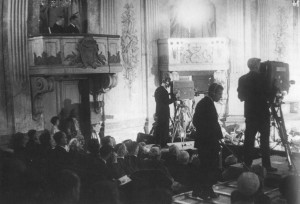 They broadcast live on Eurovision Gluck’s opera Orfeo ed Euridice from the tiny Drottningholms Slottsteater outside of Stockholm. The 18th-century opera house had no broadcast facilities, no television lighting, no air conditioning, and could go up in flames if treated improperly.
They broadcast live on Eurovision Gluck’s opera Orfeo ed Euridice from the tiny Drottningholms Slottsteater outside of Stockholm. The 18th-century opera house had no broadcast facilities, no television lighting, no air conditioning, and could go up in flames if treated improperly.
The opera remote broadcast was a success, so Eurovision gave the okay for SVT to cover the FIFA World Cup for them. In the final game, a 17-year-old player called Pelé scored two goals, winning the match for Brazil and leading even his opponent, Swedish player Sigge Parling, to say, “When Pelé scored the fifth goal in that final, I have to be honest and say I felt like applauding.” Then, overcome with emotion, Pelé fainted. All of it was captured live on television, thanks to opera.
Pelé’s real first name, by the way, is Edson. He is named after the American inventor Thomas Edison, whose work on the invention of motion pictures was intended specifically for opera and who predicted in 1891 that he would be able to show opera on color television at the 1893 Chicago World’s Fair. But that’s another story.
11. Edison, Opera, and Television (2012 March)
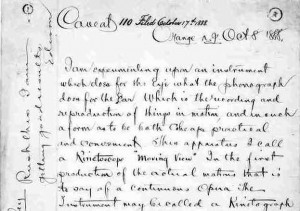 There’s a pretty famous quote about Thomas Edison bringing opera to homes in a new invention. The prediction, made on May 12, 1891, is generally thought to have been about motion pictures. There’s no question Edison invented motion pictures for opera; his 1888 patent caveat mentions nothing else as their purpose. But I’ve been analyzing his 1891 quote, and I believe he was predicting televised opera then, not movies (he wouldn’t be the first; there were televised-opera predictions in 1882 and 1877, too). For more on this, check out my blog post: https://staging.sportsvideo.org/blogs/?blog=schubin-cafe&news=what-it-was-was-television
There’s a pretty famous quote about Thomas Edison bringing opera to homes in a new invention. The prediction, made on May 12, 1891, is generally thought to have been about motion pictures. There’s no question Edison invented motion pictures for opera; his 1888 patent caveat mentions nothing else as their purpose. But I’ve been analyzing his 1891 quote, and I believe he was predicting televised opera then, not movies (he wouldn’t be the first; there were televised-opera predictions in 1882 and 1877, too). For more on this, check out my blog post: https://staging.sportsvideo.org/blogs/?blog=schubin-cafe&news=what-it-was-was-television
Comments:
Jim Lindner: But there is a real question as to whether Edison actually invented motion pictures – or perhaps better said – invented it first. This has been argued by historians for quite some time. I think it is fair to say that the consensus of opinion is that Charles Francis Jenkins is the inventor of what we came to know as Motion Pictures with his invention (along with Armat to some extent) of the Phantascope – the direct predecessor to the Edison Vitascope.
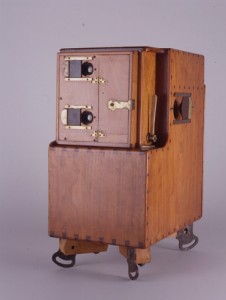 General consensus is that the inventor of the motion picture camera is Louis Le Prince although there were many other camera inventors working at the same time (Lumiere for example), and Le Prince’s camera was a bit dodgy. The one that first really worked was made by William Dickson who worked for Edison (and had access to the Phantascope information). As was the way at the Labs, Edison himself took credit for what was the work of Dickson and others – which was typical of many inventions ascribed to Edison.
General consensus is that the inventor of the motion picture camera is Louis Le Prince although there were many other camera inventors working at the same time (Lumiere for example), and Le Prince’s camera was a bit dodgy. The one that first really worked was made by William Dickson who worked for Edison (and had access to the Phantascope information). As was the way at the Labs, Edison himself took credit for what was the work of Dickson and others – which was typical of many inventions ascribed to Edison.
Don’t get me wrong – I am a big Edison fan, but the reality is that one of his largest contributions was not so much the individual inventions as much as his development of the lab system to invent – if you will he invented the way to invent in the modern way. Today, Dickson is generally given credit for the actual invention of the Vitascope camera.
Mark Schubin: You’re right, Jim. I should have used different language. What I meant to say was that whatever Edison did do in the creation of motion pictures, he did for opera. His initial patent caveat in 1888 specifies nothing but opera as the purpose of motion pictures.
As you point out, there’s no question that Edison was not the first person to come up with the concept of photographic motion pictures. But it might well be the case that whoever did did so for opera. You mentioned Jenkins and Le Prince. Here’s an excerpt from Jenkins’s 1925 book Vision by Radio, about his television work:
“The casing enclosing the mechanism is not very large, and contains, besides the radio vision mechanism, the radio receiving set, and a loudspeaker, so that an entire opera in both action and music may be received.”
Here is the famous quote about Le Prince’s work from the Secretary of the Paris Opera in 1890:
“I, the undersigned, Ferdinand Mobisson, Secretary of the National Opera, Paris, residing at 38 Rue de Mauberge, certify by this present to have been charged with the study (or examination) by means of the apparatus brought before me, of the system of projection of animated pictures, for which Mons. Le Prince, Louis Aime Augustin, of New York, United States, has taken out in France patent rights, dated the 11th of January, 1888, having the number 188,089, for ‘Method and Apparatus for the projection of Animated Pictures, in view of the adaptation to Operatic Scenes,” and to have made a complete study of the system, in faith of which I have delivered the present certificate to serve whom it may concern.”
The Lumiere brothers made opera movies and chose as the location of their first public showing the Grand Cafe near the Paris Opera. As for William Dickson, in the first (known) sync-sound movie, shot in 1894, he plays music from the opera Les cloches de Corneville on screen on his violin.
As you point out, what we consider “modern” movies came from these inventors, but all of them were preceded by others, such as Eadweard Muybridge. And Muybridge was preceded by Louis Jules Duboscq.
Who was Duboscq? In 1852, he was issued the world’s first patent for a photographic motion-picture projection system. It was also stereoscopic.
He happened also to be the head of special effects at the Paris Opera, where, three years earlier, he used electric light for a sunrise effect in the Meyerbeer opera, Le prophete, 30 years before Edison’s first light-bulb demonstration.
More interesting to me than the electric lighting was the power for it. Duboscq created a battery room in the basement of the opera. Unfortunately, the batteries of the day (Bunsen cells) emitted toxic fumes, so Duboscq had to create a system (praised by Nature magazine) to scrub the toxic chemicals from the air — all in the service of opera!
Jim Lindner: While the inventor’s intention at least for the patent application likely was opera, the practical reality of what happened was decidedly plebeian. Early cinema was almost entirely seen by the public in side show type entertainment, portrayed fairly accurately in Hugo.
The “plots” of the early Kinetoscope films were things like people kissing, dancing, and uh – boxing cats (no I did not make that up) and a wide variety of subjects definitely not operatic – at least not intentionally.
A list of extent early Edison films organized by date is available from the Library of Congress here as part of the now defunct “American Memory” project, and it is fun to look at some. There is quite a bit on YouTube as well: http://memory.loc.gov/ammem/edhtml/edmvchrn.html
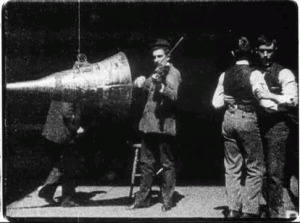 I believe this is the film you refer to. A very early 1895 (according to LOC not 1894) Dickson experiment with sound can be viewed here. As is obvious films were envisioned to be “sound” from the very beginning. Could he have been playing opera on the violin – perhaps! The horn’s size appears to not be that atypical from ones used in the day to record opera. Still – this film from 1894/5 was 4 years later than the first experiments by Dickson that were definitely MOS [without sound]: http://hdl.loc.gov/loc.mbrsmi/edmp.4034
I believe this is the film you refer to. A very early 1895 (according to LOC not 1894) Dickson experiment with sound can be viewed here. As is obvious films were envisioned to be “sound” from the very beginning. Could he have been playing opera on the violin – perhaps! The horn’s size appears to not be that atypical from ones used in the day to record opera. Still – this film from 1894/5 was 4 years later than the first experiments by Dickson that were definitely MOS [without sound]: http://hdl.loc.gov/loc.mbrsmi/edmp.4034
It took quite some time for cinematic language as we know it to evolve. Opera by contrast in 1891 already had a very long and deep tradition. Early film did not wade into those established waters for quite some time.
Mark Schubin: Although it’s certainly true that Edison did not achieve his goal of opera movies for some time, there were plenty of opera-movie conjunctions prior to the 20th century. Some think that Edison’s 1894 Carmencita was intended to be heard with music of Carmen. As for the 1894/5 Dickson experimental sound movie, you can listen to it with the opera music coming from his violin here (extract the Dickson file from the zip): https://staging.sportsvideo.org/wp-content/uploads-schubin/2011/11/LOC_Fandom_Files.zip
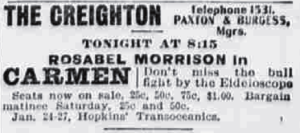 In 1896, Le Prince’s goal of adapting movies to operatic purposes was realized when the Rosabel Morrison Opera Company performed Carmen in a touring company with the movie Bullfight used as a backdrop in the last act; that touring opera was many Americans’ first experience of projected motion pictures (many of the shorts you describe were pre-projection). There were operetta movies shown in Europe the same year.
In 1896, Le Prince’s goal of adapting movies to operatic purposes was realized when the Rosabel Morrison Opera Company performed Carmen in a touring company with the movie Bullfight used as a backdrop in the last act; that touring opera was many Americans’ first experience of projected motion pictures (many of the shorts you describe were pre-projection). There were operetta movies shown in Europe the same year.
In 1897, just two years after their first public showing of movies, the Lumiere brothers released Georges Hatot’s Faust, based on Gounod’s opera. In 1898, a two-minute version of the opera La fille du regiment was released.
The same year, Flotow’s opera Martha was shot; it was shown the following year at the Eden Musee in New York, with singers behind the screen lip-synching to the performers being projected. Georges Mellies’s Cendrillon, based on the Massenet opera of the same name, was also released in 1899.
You can find many more examples of 19th-century opera movies in Ken Wlaschin’s Encyclopedia of Opera on Screen. And, in 1900, the last year of the 19th century, at the Paris World’s Fair, the Phono-Cinéma-Théâtre provided many sync-sound movies of opera arias.
Jim Lindner: And it was at that same 1900 Paris World’s Fair where Valdemar Poulsen exhibited the Telegraphone, the first working device to record on magnetic media. So, other than recording the voice of Emperor Franz Joseph, did Poulsen have any operatic aspirations for his invention? It would seem logical given the time period that opera was envisioned being recorded on this device as well.
Mark Schubin: That’s not an area I’ve researched yet (but, given that Poulsen was a telephone engineer, he might have been working on the answering machine). I look forward to learning more!
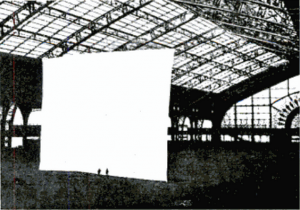 By the way, that Paris 1900 World’s Fair was one heck of a place for the introduction of media technology. Besides what we’ve discussed here (sync-sound movies and magnetic recording), it had large-format large-screen movies (precursor to IMAX) and motion-platform simulators (including one with a motion-parallax 3D effect), and it is where the word “television” was first publicly used.
By the way, that Paris 1900 World’s Fair was one heck of a place for the introduction of media technology. Besides what we’ve discussed here (sync-sound movies and magnetic recording), it had large-format large-screen movies (precursor to IMAX) and motion-platform simulators (including one with a motion-parallax 3D effect), and it is where the word “television” was first publicly used.
And, in the world of opera and media technology, it is where the first wireless opera broadcasts took place! Horace Short (an aviation pioneer who built the first aircraft factory and later designed the folding-wing planes used on aircraft carriers) came up with the idea of compressed-air amplification. During the Fair, he took one of his “auxeto-gramophones” to Gustave Eiffel’s office at the top of the Eiffel Tower and played opera recordings. The needle controlled a valve that controlled the compressed air so that the music could be heard over a large area on the ground.
Here’s a recent post I did on the 1900 Paris World’s Fair: https://staging.sportsvideo.org/blogs/?blog=schubin-cafe&news=smellyvision-and-associates
Another comment: Well, I haven’t yet found anything connecting Poulsen to opera, but Marvin Camras, who was issued more than 500 patents in the field of magnetic recording, built his first magnetic audio recorder to help a cousin who wanted to be an opera singer.
And another comment: I just (2013 March 19) discovered that, despite its being called an opera in many references, Rosabel Morrison’s Carmen was a play based on the Mérimée story, not an opera. Sorry!
12. Opera and Theatrical Television (2012 March)
I just posted a history of theatrical-television technology on SchubinCafe.com. It starts (in 1877!) and ends, of course, with opera: https://staging.sportsvideo.org/blogs/?blog=schubin-cafe&news=getting-the-big-picture
13. Opera and Alternative Content for Cinema — and Baseball (2012 March)
Here’s a link to the post of part II of the alternative-content-for-cinema story, with lots more about opera — and baseball. There has been a long relationship between baseball and opera, two of the things for which Cooperstown, New York is famous (the Baseball Museum and Hall of Fame and the Glimmerglass Festival operas).
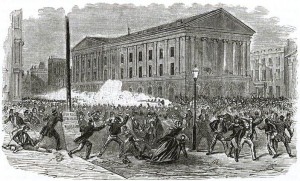 Consider, for example, the Astor Place Riot of May 10, 1849, New York City’s deadliest riot when it occurred. At first glance, it might seem to have had nothing to do with either baseball or opera, being, instead, a dispute between fans of the American actor Edwin Forrest and those of the British actor William Macready over who could better perform Macbeth. Macready was performing his version at the Astor Place Theatre, where the riot began. But the building had only recently been renamed; it was previously the Astor Opera House.
Consider, for example, the Astor Place Riot of May 10, 1849, New York City’s deadliest riot when it occurred. At first glance, it might seem to have had nothing to do with either baseball or opera, being, instead, a dispute between fans of the American actor Edwin Forrest and those of the British actor William Macready over who could better perform Macbeth. Macready was performing his version at the Astor Place Theatre, where the riot began. But the building had only recently been renamed; it was previously the Astor Opera House.
Nigel Cliff’s book The Shakespeare Riots (Random House, 2007) begins with the Forrest camp recruiting thugs from among the baseball players at the Elysian Fields in Hoboken, New Jersey, where “Three years earlier the first organized baseball match had been held….” And, according to his obituary in The New York Times, the person who rescued Macready from the murderous mob was the former opera-house impresario Edward P. Fry (who later became the inventor of electronic home entertainment when he arranged to listen to operas at home by telephone).
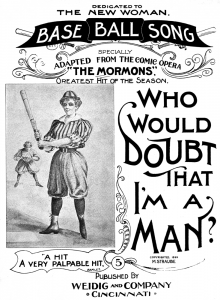 Then there is the famous baseball poem written by Ernest Thayer in 1888, “Casey at the Bat.” Its first recitation from the stage was by the comic-opera star DeWolf Hopper as part of the opera Prinz Methusalem that year. Hopper became the most famous performer of “Casey,” by some accounts having done it more than 40,000 times (he claimed only 10,000). The DeWolf Hopper Opera Company, by the way, performed an opera called Mr. Pickwick in 1903; in 1936, a different Pickwick became the first opera premiered on television. And, in 1953, William Schuman, who later became the first president of Lincoln Center for the Performing Arts, turned the poem into the opera The Mighty Casey (which was, of course, performed at Glimmerglass in Cooperstown).
Then there is the famous baseball poem written by Ernest Thayer in 1888, “Casey at the Bat.” Its first recitation from the stage was by the comic-opera star DeWolf Hopper as part of the opera Prinz Methusalem that year. Hopper became the most famous performer of “Casey,” by some accounts having done it more than 40,000 times (he claimed only 10,000). The DeWolf Hopper Opera Company, by the way, performed an opera called Mr. Pickwick in 1903; in 1936, a different Pickwick became the first opera premiered on television. And, in 1953, William Schuman, who later became the first president of Lincoln Center for the Performing Arts, turned the poem into the opera The Mighty Casey (which was, of course, performed at Glimmerglass in Cooperstown).
You’ll find some of the rest in the post. On August 23, 1914, a Coleman Life-Like Scoreboard was installed in the Providence Opera House so spectators could “watch” away baseball games (according to the Providence Evening News the next day, “Even arguments between players and arbitrators are shown”). Starting in 2007, San Francisco Opera began simulcasting Opera in the Ballpark to AT&T Park, home of the Giants, where not only the stands but also the outfield fills with tens of thousands of opera fans; the following year Washington National Opera sent its version, Opera in the Outfield, to Nationals Park.
Enjoy the post: https://staging.sportsvideo.org/blogs/?blog=schubin-cafe&news=the-alternatives
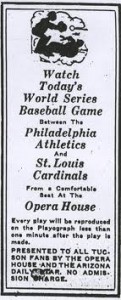 Comments: One more tidbit: The great operatic tenor, Enrico Caruso (who made the earliest recording to sell a million copies), was once asked what he thought of Babe Ruth. He said he couldn’t say because he’d never heard her sing.
Comments: One more tidbit: The great operatic tenor, Enrico Caruso (who made the earliest recording to sell a million copies), was once asked what he thought of Babe Ruth. He said he couldn’t say because he’d never heard her sing.
And another: The Tucson Opera House installed a Playograph scoreboard. According to a notice in The Arizona Daily Star, there was no admission charge to come and watch the 1931 World Series between the Philadelphia Athletics and the St. Louis Cardinals. It was “presented to all Tucson fans by the Opera House and” the newspaper.
Here’s a link to a baseball-opera chronology: https://staging.sportsvideo.org/wp-content/uploads/2013/10/Opera-and-Baseball-Chronology.pdf
14. Opera and Lighting, Libretti, & Language (2012 April)
I attended a ballet at the 3800-seat Metropolitan Opera House this weekend. As usual, just before the performance began, the auditorium’s chandeliers rose to the ceiling.
The Met is New York City’s largest opera house. One of its tiniest used to be the Amato. There, too, two tiny hanging audience lights rose to the ceiling just before the performances.
Both theaters were offering a historical echo of what must have happened in opera’s early days, when lighting — both on stage and in the auditorium — came from candles and oil lamps. Those had to be lit, so, before each performance, chandeliers would have had to have their candles lit in the ceiling, be lowered to light the auditorium, and then be raised for the performance.
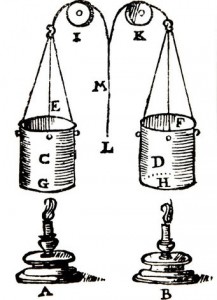 Lighting could be pretty elaborate even back in the old days. The second edition of Nicola Sabbattini’s handbook of stagecraft, published in 1638, includes instructions for and a diagram of a light-dimming system, as well as information on house lighting, lightning-bolt effects, and color filters. Michael Callahan’s 2006 “Automated Lighting: The Backstory” notes that “in the days when audiences were still wearing powdered wigs,” the “French changed the color of candlelight using long cords to swap panels of dyed silk.”
Lighting could be pretty elaborate even back in the old days. The second edition of Nicola Sabbattini’s handbook of stagecraft, published in 1638, includes instructions for and a diagram of a light-dimming system, as well as information on house lighting, lightning-bolt effects, and color filters. Michael Callahan’s 2006 “Automated Lighting: The Backstory” notes that “in the days when audiences were still wearing powdered wigs,” the “French changed the color of candlelight using long cords to swap panels of dyed silk.”
It might be worth noting that “candlelight” was very different before the mid-19th-century from what it is today. Michael Faraday’s lectures on “The Chemical History of a Candle” were given in 1860, by which time candles were not too different from today’s. Before that, however, they would typically have been dim, smoky (there are reports of so much haze as to prevent the performers from being seen), stinky, and sometimes toxic. Those in chandeliers could easily (because they were softer than today’s) drip hot wax on the audience below. They could be expensive, so few would be used. And their wicks didn’t get consumed, so they would grow to the point of danger, requiring actors and singers to trim them as they moved about the stage.
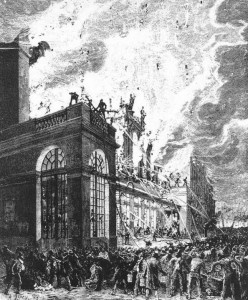 Aside from toxicity, lighting sources through the end of the 19th century (candles, oil lamps, and various forms of gas lighting) produced significant heat and often caused fires. A study of an opera house in Manchester, England, published in 1893, showed that, at a time when the temperature on the street was 36 degrees Fahrenheit, it was 121 in the upper seating. The carbon-dioxide level in the coal-fired, Industrial-Age street was 530 parts per million; in the house it was 1690. Bacteria, mold, and other organic hazards were also considerably higher inside than out. And drafts caused by venting the heat caused some audience members to complain of cold.
Aside from toxicity, lighting sources through the end of the 19th century (candles, oil lamps, and various forms of gas lighting) produced significant heat and often caused fires. A study of an opera house in Manchester, England, published in 1893, showed that, at a time when the temperature on the street was 36 degrees Fahrenheit, it was 121 in the upper seating. The carbon-dioxide level in the coal-fired, Industrial-Age street was 530 parts per million; in the house it was 1690. Bacteria, mold, and other organic hazards were also considerably higher inside than out. And drafts caused by venting the heat caused some audience members to complain of cold.
What does all of this have to do with opera and media-technology? The opera part is that many lighting advances came from opera, from 16th-century color filters to 17th-century dimmers to 18th-century projection to 19th-century gas and then electric lighting to 20th-century automated lighting (Callahan attributes “the first automated lighting system” to Fritz von Ballmoos, a Swiss low-temperature physicist with “an interest in opera and no prior connection to entertainment lighting”). As for the media, there are both media-philosopher Marshall McLuhan’s description of light as a medium and, more significant here, the fact that lighting enabled the use of another operatic medium: print.
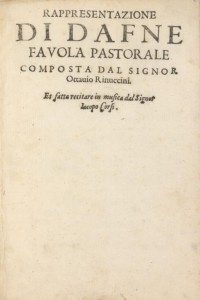 Many say the first opera was Dafne, performed in Florence in what we’d today call 1598 (The New York Times recently reported — in its “Home” section — that the theater space still exists). The opera’s host printed little books (“libretti” in Italian) to give away as souvenirs to those in attendance (you can touch one at the New York Public Library’s Performing Arts Library). By 1600, the same libretto was reprinted as something to be bought, and that was well before the first opera ticket was sold, in 1637.
Many say the first opera was Dafne, performed in Florence in what we’d today call 1598 (The New York Times recently reported — in its “Home” section — that the theater space still exists). The opera’s host printed little books (“libretti” in Italian) to give away as souvenirs to those in attendance (you can touch one at the New York Public Library’s Performing Arts Library). By 1600, the same libretto was reprinted as something to be bought, and that was well before the first opera ticket was sold, in 1637.
There seem to be differences of opinion about whether people actually read libretti during early opera performances. For one thing, with only a few candles, the interiors of the opera houses were pretty dim.
I went to an opera at the 18th-century Drottningholms Slottsteater near Stockholm, and, although they’ve switched to electric lighting, they’ve tried to make it similar to what would have existed in the days of candles. The house lights stay on all the time, because the candles would have remained lit. Despite that, it was almost impossible to read anything, and, to comply with safety regulations, light-equipped ushers had to stay near the exit doors, which might otherwise be invisible. One lighting historian estimates that the total light output in London’s Drury Lane opera house would have been roughly equivalent to that of a single 75-watt incandescent bulb.
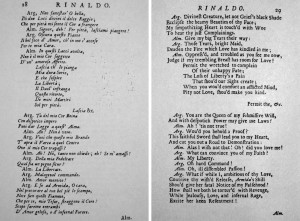 Things changed in 18th-century London, however, when composer George Frideric Handel introduced the opera Rinaldo in 1711. It was in Italian but intended for (and premiered in) an Anglophone city. So it had a bilingual libretto, with the Italian words printed on one side and their English translation facing them. That almost required the purchase of a libretto.
Things changed in 18th-century London, however, when composer George Frideric Handel introduced the opera Rinaldo in 1711. It was in Italian but intended for (and premiered in) an Anglophone city. So it had a bilingual libretto, with the Italian words printed on one side and their English translation facing them. That almost required the purchase of a libretto.
As for reading it in a dim theater, Mark Stahura’s “Handel’s Haymarket Theater,” in the 1998 Amadeus Press book Opera in Context, finds a reference in Henry Fielding’s 1751 novel Amelia. Stahura writes, “the heroine sits in the first row of the first gallery” where “she meets an amiable gentleman, who procures and holds a candle to facilitate her heading of the libretto.” Other reports indicate that those in the cheap seats (who, presumably, couldn’t afford either libretto or reading candle) would spit on the candles below, which they found a distraction from the action on stage.
In the previous post on subtitling, you’ll find info on alternatives to libretti, including an 1881 patent on a gas-jet illuminated text-display system. Of course, that, too, might be considered distracting.
15. Opera, Live Television, and John Goberman (2012 April)
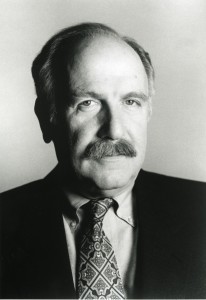 Lincoln Center announced on Friday that John Goberman, who created the Live from Lincoln Center series and produced it for its 37 seasons to date, will be leaving at the end of the month. Even before Live from Lincoln Center began, Goberman (formerly a cellist in the Metropolitan Opera orchestra) racked up a string of successes in media-technology and opera history:
Lincoln Center announced on Friday that John Goberman, who created the Live from Lincoln Center series and produced it for its 37 seasons to date, will be leaving at the end of the month. Even before Live from Lincoln Center began, Goberman (formerly a cellist in the Metropolitan Opera orchestra) racked up a string of successes in media-technology and opera history:
– 1970: plans for a subscription-television service offering opera
– 1971: first transmission of opera exclusively on cable TV; first use of low-light-level cameras for opera
– 1972: first proposed delivery of opera with stereo sound; first set-top box intended for opera
– 1973: first experiments in invisible television pickup of opera
– 1974: experiments in anamorphic and camera-stitched widescreen opera; viewer testing of the importance of stereo sound for opera
– 1975: exhibition of solid-state cameras, video disks, portable (and laser) video projection, and small-aperture satellite earth stations in the service of opera; commencement of work on a “contrast compression” circuit for live video to enable operatic spotlights and shadows to coexist
– 1976: Lincoln Center’s first (and, thus far, only) patent, for a secure-television system offering stereo sound
After Live from Lincoln Center began, the media-technology-and-opera hits continued, with the first nationwide live television transmission with stereo sound (and the first FCC tariffs for satellite transmission of stereo sound) and what I believe to be the world’s first live subtitles, both in 1976. Goberman also produced the first Live from the Met opera transmissions and taught delegations from all over the world about how to shoot live opera.
He was by no means the first to put opera on television. In 1934, the BBC telecast a highly condensed version of Carmen. In 1936, they carried portions of the opera Pickwick before it opened on stage, and, the following year, they telecast the first complete, uncut opera, La serva padrona. The BBC telecast an opera they commissioned, Cinderella, in 1938, but it had been commissioned for radio and adapted for television. The first opera commissioned specifically for television was Amahl and the Night Visitors, first aired by NBC in 1951.
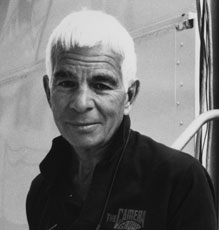 That opera was directed by Kirk Browning, who worked for NBC Opera Theater, an opera company maintained by that television network for 16 years (they even went on tour starting in 1956). John Goberman hired Kirk Browning to direct Live from Lincoln Center, which Browning did until his death in 2008 at age 86.
That opera was directed by Kirk Browning, who worked for NBC Opera Theater, an opera company maintained by that television network for 16 years (they even went on tour starting in 1956). John Goberman hired Kirk Browning to direct Live from Lincoln Center, which Browning did until his death in 2008 at age 86.
NBC Opera Theater commissioned many new operas (not counting operas NBC commissioned for radio); so did CBS Television and ABC Television. Even two commercial U.S. TV stations (not networks), WAVE-TV and WBAL-TV, commissioned operas. And, besides the commissioned operas, all four U.S.commercial networks of the time (including DuMont) carried other opera programming.
Almost all of the above, however, was studio-shot programming. When the NBC Opera Theater team went to public television, they still produced studio-shot opera.
There had been some televised opera transmitted live from the stage. The first was by the BBC in 1947, the second by ABC in the U.S. in 1948. As recently as the late 1960s, however, when opera was shot from the stage, it almost might as well have been in a studio. Light levels soared. Cameras were mounted on platforms in the middle of the seating. Staging was adjusted for television needs. It was definitely not a typical live-opera experience.
That’s where Goberman came in. His mantra for the television team was “We are transmitting an opera, not producing it.” He wanted his cameras and microphones to be invisible, and there was to be no interference with the performers, the staging, or the audience. That’s why broadcasters from around the world came to Goberman to learn how to transmit opera performances on television, not how to shoot television operas.
How did it all work out? Aside from multiple Emmy and Peabody awards and other honors and some of the highest ratings on PBS, “Live from Lincoln Center” is in its 37th season.
Thanks, John!
For a bit more, here’s something I wrote on Friday on my blog: https://staging.sportsvideo.org/blogs/?blog=schubin-cafe&news=goberman-leaving-lincoln-center
16. More Baseball & Opera (2012 April)
I just did a little story for the Cooperstown Freeman’s Journal (more than 203-years old and still going strong). Here’s a link: http://issuu.com/allotsego/docs/allotsego-4-13-12?mode=window&viewMode=singlePage
Not a lot of it is about media, but I have now traced telegraph-dispatch baseball games “performed” in opera houses back to 1885 in Augusta, Georgia and Nashville, Tennessee, spreading to many cities the following year. In the Detroit system, when there was a fly ball, a picture of a fly was projected.
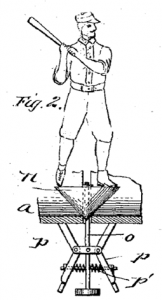 Here’s a patent issued in 1895 for a system already in use in many opera houses that year: http://www.google.com/patents/US543851
Here’s a patent issued in 1895 for a system already in use in many opera houses that year: http://www.google.com/patents/US543851
There must have also been a more elaborate version, because a contemporary newspaper account refers to “the coachers” clapping and dancing when there was a hit.
And here’s a bit more on Caruso and Babe Ruth: They both lived in the same New York City “hotel,” along with many other opera singers (among them Feodor Chaliapin, Geraldine Farrar, Lauritz Melchior, Ezio Pinza, Lily Pons, Eleanor Steber, and Teresa Stratas). Gambler Arnold Rothstein also lived there (the Ansonia), and that location, too, had a telegraphic baseball scoreboard, associated the 1919 World Series (the Ansonia is where the “Black Sox” scandal originated).
Comments: I’m doing a piece on watching baseball games remotely before television. It will appear in the Fall issue of Sports Tech Journal <http://www.hpaonline.com/assets/2013presentations/2013_tr_pres_mschubin_sportstechjournal.pdf> I don’t want to give too much away, but opera plays a significant role. One of the first places where people could watch baseball games remotely before television was at Nashville’s Grand Opera House in 1885. It quickly spread to opera houses across the country.
Of course, turnabout is fair play. Starting in 2007,San Francisco opera began simulcasting its operas to the giant LED scoreboard screen at the AT&T Park ball field, followed by the Washington National Opera at Nationals Park. On September 24, 2010, 32,000 people watched “Aida” live at AT&T Park.
Frank Zamacona: Hi Mark, I directed that Aida for the 31 feet high by 103 feet wide screen at AT&T Ball park. Just got back from Seattle directing their first Live HD Simulcast of Madama Buttterfly at the Key Arena where the screen was 50 feet wide by 80 feet high. It was bigger than their proscenium.
17. Opera and the First Wireless Sound Broadcast (June 2012)
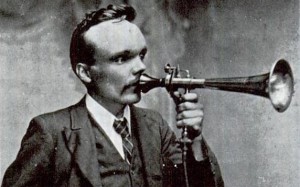 If you study aviation history, you will almost certainly come across the name Horace Short, who, with his brothers, made Shorts aircraft and built the world’s first aircraft factory. Naval historians might know that he came up with the folding-wing design used to increase storage on aircraft carriers (though it was originally intended to allow sea planes to get close to docks).
If you study aviation history, you will almost certainly come across the name Horace Short, who, with his brothers, made Shorts aircraft and built the world’s first aircraft factory. Naval historians might know that he came up with the folding-wing design used to increase storage on aircraft carriers (though it was originally intended to allow sea planes to get close to docks).
I will say no more about those aspects of his life, nor will I discuss how he became king of a South Pacific tribe of cannibals or kept bandits from his Mexican silver mine by conveying the impression that he had super powers. No, here I will present only one tiny aspect of his life, the world’s first wireless broadcast of sound, which was opera.
In 1898, Short applied for a patent on a sound-amplification device — effectively a powered megaphone. What’s particularly interesting about it is that 1898 was years before the first electronic amplification device. Short’s system didn’t need to use electricity at all; it used compressed air, the sound pressure of the voice moving a valve.
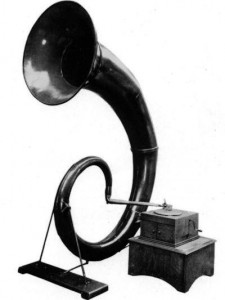 A second patent suggested that the amplification system could be used not merely as a megaphone but also for amplifying records, the valve controlled by a needle (Figure 6 of British patent 677,476, applied for April 29, 1899, issued July 2, 1901). To demonstrate it (possibly to gather publicity for the sale of his patents to turbine pioneer Charles Parsons), Short chose the Paris World’s Fair of 1900. And what more iconic spot there than Gustave Eiffel’s own room at the top of his tower (built for the previous Paris World’s Fair)?
A second patent suggested that the amplification system could be used not merely as a megaphone but also for amplifying records, the valve controlled by a needle (Figure 6 of British patent 677,476, applied for April 29, 1899, issued July 2, 1901). To demonstrate it (possibly to gather publicity for the sale of his patents to turbine pioneer Charles Parsons), Short chose the Paris World’s Fair of 1900. And what more iconic spot there than Gustave Eiffel’s own room at the top of his tower (built for the previous Paris World’s Fair)?
What records to play? That World’s Fair also featured synchronized-sound movies at the Phono-Cinéma-Théâtre of opera stars singing arias, so that’s what Short played, too. He later repeated the performance at Britain’s Blackpool Tower.
The compressed-air amplification was sufficient for the sound to be heard on the ground at a radius of at least a quarter mile from the tower. No, it wasn’t radio (though 20 years later the first off-air radio recording would be made at the Eiffel Tower, and it, too, would be of opera), but it was a wireless sound broadcast.
Comments:
Niels Windfeld Lund: Interesting, do you have a list of what arias he played ?
Mark Schubin: Not yet, but at the Phono-Cinéma-Théâtre at the same 1900 Paris World’s Fair Victor Maurel sang arias from Falstaff and Don Giovanni, Emile Cossira sang an aria from Romeo et Juliette, and a singer from La Scala by the name of Polin sang an aria from La fille du regiment.
I’m still searching for Short’s content.
18. Opera and Television – Canada Day Special (2012 July 1)
To celebrate Canada Day, consider naturalized-Canadian soprano Sarah Fischer, who performed the role of Carmen in the first televised opera, broadcast by the BBC on 1934 July 6 (using 30-line mechanical scanning).
19. The Earliest Opera Recordings (2012 July)
Good arguments can be made that opera played a major role in the development of (in rough chronological order), electronic home entertainment, stereo sound transmission, pay cable, movies, headphones, newscasts, sound movies, and even broadcasting — but not recording. When Thomas Edison described the uses of his phonograph shortly after its introduction in 1877, number one was letter writing.
It makes sense. Sound recordings couldn’t handle opera’s duration, and the large stage and moving singers were problems, too. And fidelity was far from high.
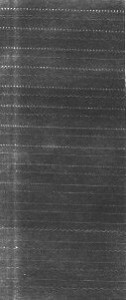 So, when was the first sound recording of opera music? Would you believe 1860 — 17 years before Edison’s first phonograph?
So, when was the first sound recording of opera music? Would you believe 1860 — 17 years before Edison’s first phonograph?
For this extraordinary discovery, I rely entirely on the experts at FirstSounds.org (and they are definitely experts). The recordings (and note the plural) were Édouard-Léon Scott de Martinville’s phonautograms and were probably never intended to be played back. “Virtual stylus” technology developed at Lawrence-Berkeley National Laboratory allowed the first phonoautogram playback in 2008, and they’ve been improved since. The recording of “Au clair de la lune” is very clearly recognizable. Unfortunately, I can’t say the same for the opera recordings, which you’ll find on this page of the First Sounds site: http://www.firstsounds.org/sounds/scott.php/
They say it’s “La Chanson de l’Abeille” from the comic opera La Reine Topaze by Victor Massé, first performed in 1856. I’ll take their word for it. I’ve listened to both versions, and about the best I can come up with from personal listening is that it does sound like a human voice.
Those are the earliest known opera recordings. But there was much earlier opera playback! Yesterday, I got to hear one from around 1830! I’ll describe that in another post.
20. More on the Baseball-Opera Hotel (2012 July)
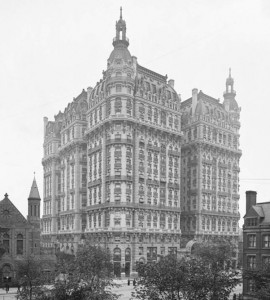 I’ve written a bit here about the baseball-opera residential hotel, the Ansonia, which had a telegraphic game-display system used to view the 1919 World Series. A party there Saturday inspired me to offer a little more.
I’ve written a bit here about the baseball-opera residential hotel, the Ansonia, which had a telegraphic game-display system used to view the 1919 World Series. A party there Saturday inspired me to offer a little more.
On the baseball side, the Ansonia’s most-famous resident was Babe Ruth, who reportedly entertained in his rooms every night and would sometimes play the saxophone (which he took up after moving in). That was not a problem inside his apartment (some of the walls were three feet thick); it was more noticeable when he played in the hallways. He’d also wear his red silk bathrobe to the basement barber for his morning shave.
There’s an exhibit of Babe Ruth artifacts in the current lobby. I recommend entering from the West 73rd Street entrance, just west of Broadway, which has a little of the old carriageway left. The exhibit is opposite the reception desk.
Besides Babe Ruth, other baseball players who lived at the Ansonia included “Sleepy Bill” Burns, Jean Dubuc, Bob Meusel, Lefty O’Doul, and Wally Schang. Visiting players (including Ty Cobb) also often lodged there, where the 1919 “Black Sox” scandal originated. Ray Chapman was staying at the Ansonia the day he was fatally hit by a pitch, the only player in Major League Baseball history to have been killed that way. Baseball’s first agent, Christy Walsh, started there.
On the opera side, the Ansonia’s most-famous resident was reportedly Enrico Caruso (some dispute his living there, but it’s certainly possible that he spent at least one night). Others included Karin Branzell, Bruna Castagna, George Cehanovsky, Fyodor Chaliapin, Fausto Cleva, Alessio De Paolis, Geraldine Farrar, Giulio Gatti-Casazza, Gustav Mahler, Lauritz Melchior, Ezio Pinza, Lily Pons, Sergei Rachmaninoff, Elisabeth Rethberg, Bidu Sayao, Tito Schipa, Eleanor Steber, Teresa Stratas, Arturo Toscanini, and Thelma Votipka (who sang more performances at the Metropolitan Opera than any other woman). Like Babe Ruth, Melchior could sometimes be found in the long, wide hallways, in his case practicing archery on animal-trophy targets.
The thick walls offer one reason why musicians lived (and still live) there. Their thickness was due to what they contained: pipes for circulating freezing brine (to keep the rooms at 70 degrees Fahrenheit in the summer and provide ice-water taps), pneumatic tubes to carry messages to residents, etc. A rooftop farm (with 500 chickens) supplied tenants with fresh eggs and dairy products until it was forced to close. The dining rooms could accommodate 1300, and service kitchens on each floor could also deliver meals directly to apartments. When the building opened (unofficially in 1903), it generated its own electricity.
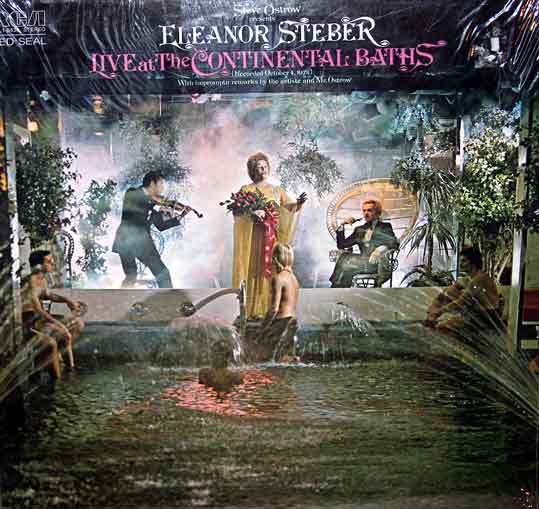 The Ansonia’s art curator collected 600 paintings to be displayed in suites and common spaces. The housekeeping staff changed linens, towels, soap, napkins, and stationery thrice daily. In the basement, the world’s largest (at the time) indoor pool had an associated Turkish bath; those later formed the core of the Continental Baths, where Bette Midler’s career took off and Barry Manilow performed wearing only a towel. Opera singer Steber not only sang but even recorded an album there, the audience in black towels for the “formal” occasion.
The Ansonia’s art curator collected 600 paintings to be displayed in suites and common spaces. The housekeeping staff changed linens, towels, soap, napkins, and stationery thrice daily. In the basement, the world’s largest (at the time) indoor pool had an associated Turkish bath; those later formed the core of the Continental Baths, where Bette Midler’s career took off and Barry Manilow performed wearing only a towel. Opera singer Steber not only sang but even recorded an album there, the audience in black towels for the “formal” occasion.
Some of the glory is past, with not only the live bear but also the copper stripped from the roof, the trout-filled and/or seal-cavorting (depending on historical source) fountain gone from the lobby, the miniature-golf course (the first indoors) and basement market arcade lost. But, underneath the tarred-over skylight dome, the marble-and-mahogany stairwell is still breathtaking, and the long-&-wide hallways, thick walls, grand-piano-accommodating double doors, strangely shaped rooms, and musical residents remain.
For more info on the building, here’s a link to an article that appeared in New York magazine: http://nymag.com/nymetro/realestate/features/1871/
21. Playback of Opera before the Advent of Recording (2012 July)
A couple of posts ago, I wrote about opera recordings from 1860 — 17 years before Edison’s first phonograph — which were never intended to be played back. Now I’d like to go even further back and talk about opera playback that was never recorded!
About a month ago, The New York Times ran a story about a music box that inspired melodies in Puccini’s operas Madama Butterfly and Turandot. Here’s a link to that story: http://www.nytimes.com/2012/06/17/arts/music/puccini-opera-echoes-a-music-box-at-the-morris-museum.html
That music box is located in the Murtogh D. Guinness Collection of mechanical musical instruments and automata at the Morris Museum in Morristown, New Jersey. I highly recommend a visit if you’re in theNew York area. Go when they do demonstrations. Here’s a link to the collection description: http://www.morrismuseum.org/collections/guinness/guinness.html
If you click on links on that page you can see and hear some of the devices in the collection. There are not only still pictures but also videos.
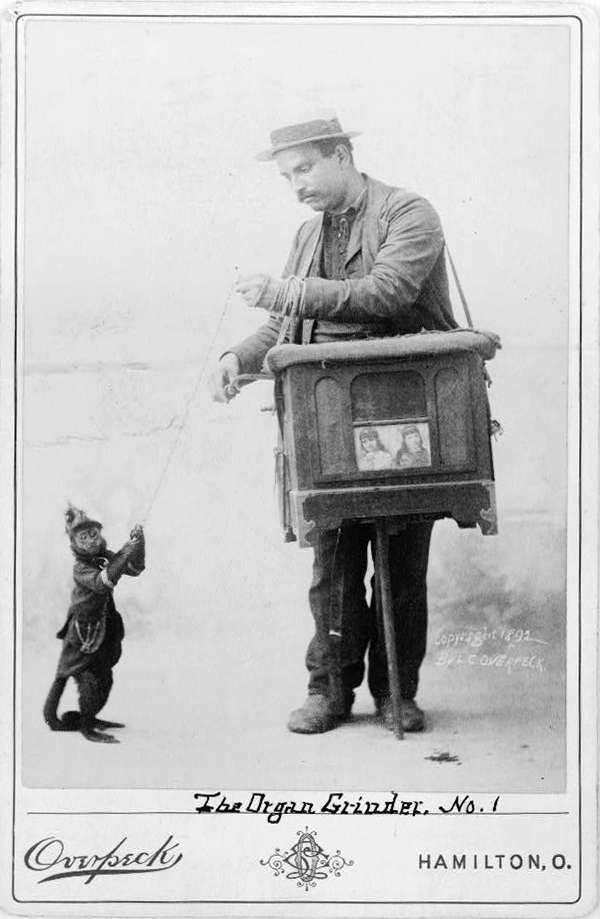 Among the tidbits of information that may be found there is a report from The New York Times in 1857 describing the organ grinder’s hand organ as “The Opera of the Street.” And what did the organ grinders play? Opera!
Among the tidbits of information that may be found there is a report from The New York Times in 1857 describing the organ grinder’s hand organ as “The Opera of the Street.” And what did the organ grinders play? Opera!
A report in Dwight’s Journal of Music on February 14, 1857 described the repertoire. “Often, at night, when the streets are still and quiet, on returning from the opera your ear will catch the distant tones of some air you have just heard….” “There is one air, however, without which a street organ would no more be a street organ than a man without a head would be a man. After Verdi and Donizetti, the street organs fall back on the inevitable ‘Mira Norma,’ of Bellini, as if it were their normal condition….”
Katherine K. Preston’s book Opera on the Road: Traveling Opera Troupes in the United States, 1825-60 (University of Illinois Press, 1993) notes that it didn’t take long for opera tunes to make their way from opera house to hand organ. The New York Mirror reported on April 29, 1845 that tunes from the opera The Bohemian Girl, which premiered that year, were already “established favorites… ground by every hand organ.”
The hand organs used cylinders that had pins and staples in them to control their valves. Experts created paper patterns for the pins and staples, and then workers made the cylinders. At the museum, you can hear a music box from about 1830 playing the familiar tune “Home, Sweet Home.” It’s familiar to us because it was used in music boxes and the like and distributed as sheet music. You might be surprised to learn that it’s from Henry Bishop’s 1823 opera Clari, or the Maid of Milan.
You’re almost certainly familiar with the Lone Ranger theme and “Summertime” and perhaps “Alabama Song.” They’re from the operas William Tell, Porgy and Bess, and Rise and Fall of the City of Mahagonny, respectively. There’s a long history of opera music becoming popular music, and it was accelerated by playback in mechanical-music devices.
Other music boxes in the Guinness collection play other popular opera music, and so do automata. There’s a small figure of Mephistopheles who strums a tune from the opera Faust on a mandolin and a full-size flute player who performs the “Mandolinata” from the opera Le passant.
So not only was opera recorded on a system never intended to be played back, but it was also frequently played back on systems that never used recordings.
Comments:
Alexander Magoun: The history of music machines has been long neglected, aside from a 1970s Smithsonian exhibition catalog and the documentation of collectors via the Vestal (NY) Press. Their existence helps explain why Eldridge Johnson and his partners renamed their company the Victor Talking Machine Company. Everyone who could afford one knew about machines that played music at all price ranges, but a talking machine? Edison’s phonographs and Columbia’s graphophones aside, that was novel.
Mark Schubin: Excellent point! I’ve previously explained the “Victor” part but not the “Talking Machine” part. Similarly, whenever anyone asks why “soap operas” are called “soap operas,” the “soap” part gets explained (they were sponsored by companies that made soap) but not the “opera” part. No one sings in a soap opera. But there is a very clear line of reasoning for the “opera” part, dating back to the first opera house in 1637 and the old Italian word for opera.
This is peripheral to the opera connection, but in my research I’ve come across quite a few talking machines way before the phonograph. You can find many of them listed here: http://www.stanford.edu/dept/HPST/representations1.pdf. Search for the word “talking” to get to that section.
The first proposal appears to have been in 1648. The first to be achieved might have been in 1771 (Erasmus Darwin). Many others followed, including one exhibited by P. T. Barnum, who also has an opera-media connection (planning to send the sound of the Paris Opéra to New York via telephone lines).
22. Why Is Soap Opera Called Opera? (2012 July)
In his comment on the discussion “Playback of Opera Before the Advent of Recording,” Dr. Alexander Magoun pointed out that the Victor Talking Machine Company was so named because there were already music machines (music boxes, barrel organs, and the like), but they couldn’t talk. That explains the “Talking Machine” part, and the “Victor” part was because the company had just won a number of lawsuits.
When people ask why soap operas are called soap operas, the common answer is that they were sponsored by soap makers. That explains the “soap” part, but what about the “opera” part? No one sings in a soap opera; it’s not even a theatrical entertainment. Why should it be called opera? And why are westerns sometimes called horse operas and science-fiction stories sometimes called space operas?
These days, most sources say the first opera was Dafne, performed in Florence in 1597/8. That’s not an ambiguous date. The notation indicates that while the year was 1597 in Florence it was simultaneously 1598 in places that started their year numbering on January 1. You can find a whole chapter (“Opera and the Calendar”) about odd dating of operas in the book The Rise of Opera by Robert Donington (Charles Scribner’s Sons, 1981).
When I say that “most sources” “these days” say that Dafne was the first opera, of course that means that some sources these days and other sources in the past disagree about what the first opera is. Some put it later; others put it earlier. And even among the sources calling Dafne the first there’s some doubt.
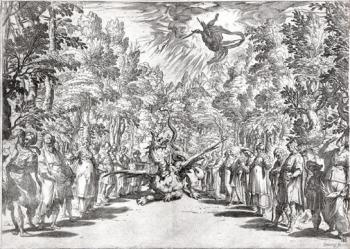 Consider, for example, the excellent Opera: A History in Documents” by Piero Weiss (Oxford University Press, 2002). It says, in no uncertain terms, “La Dafne, a ‘fable’ by Ottavio Rinuccini set to music by Jacopo Peri and Jacopo Corsi, was the first opera.” But Dafne appears in chapter 2 (and that sentence about it appears in chapter 3). Chapter 1 is devoted to the Medici wedding festivities of 1589, nine years earlier, which included entertainment that seems to have had all the elements of opera. And some date the first opera well before even that, perhaps in the 15th or even 12th centuries.
Consider, for example, the excellent Opera: A History in Documents” by Piero Weiss (Oxford University Press, 2002). It says, in no uncertain terms, “La Dafne, a ‘fable’ by Ottavio Rinuccini set to music by Jacopo Peri and Jacopo Corsi, was the first opera.” But Dafne appears in chapter 2 (and that sentence about it appears in chapter 3). Chapter 1 is devoted to the Medici wedding festivities of 1589, nine years earlier, which included entertainment that seems to have had all the elements of opera. And some date the first opera well before even that, perhaps in the 15th or even 12th centuries.
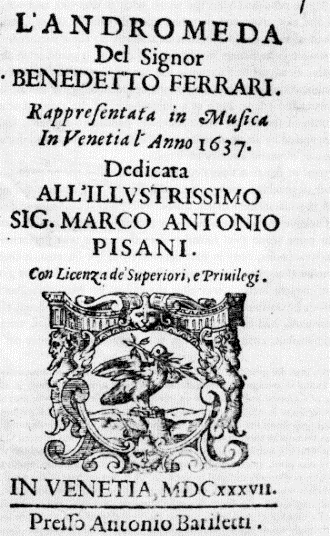 Not being a music historian, I’m unlikely to be able to resolve the conflict over the first opera. But I can tell you about the first commercial opera. All historians (at any recent time) seem to agree that it was Andromeda performed at Teatro di San Cassiano in Venice in 1637. And here’s why it is significant.
Not being a music historian, I’m unlikely to be able to resolve the conflict over the first opera. But I can tell you about the first commercial opera. All historians (at any recent time) seem to agree that it was Andromeda performed at Teatro di San Cassiano in Venice in 1637. And here’s why it is significant.
Back when opera was an entertainment for the rich, its cost wasn’t that important; someone provided an opera as an entertainment at an event to which people were invited. When opera became a commercial venture, however, its cost most certainly did matter. So the Tron family, which owned Teatro di San Cassiano, came up with a business plan that required two major modifications to the theater to turn it into an opera house.
First, they introduced audience boxes where the rich and famous could be seen. The sale and rental of the boxes covered much of the cost of the opera production (even back then about ten times more expensive than producing a play). When the Metropolitan Opera was created in 1883, it was as a real-estate company to deal with the boxes. In the beginning, the real-estate company hired opera companies to put on performances (and changed those opera companies when they weren’t satisfied).
The second Tron-family innovation was increasing the size of the theater so more ticket buyers could be accommodated. The large theater meant that the performers needed to use grand gestures to convey them to the farthest reaches of the auditorium.
Now we get to the word “opera.” English-language dictionaries say it is from the Italian. But opera wasn’t originally called opera even in Italian.
The 1597/8 Dafne was called “favola pastorale… fatta recitare in musica,” effectively “a pastoral fable… recited musically.” Andromeda in 1637 was similarly labeled. By 1641, for the opera La finta pazza, not only the music and story but also the scenery and stage machinery were mentioned, which is where the word “opera” really comes from; it is the plural of the Latin word “opus,” which means work. Opera is a combination of many works: music, storytelling, acting, scenery, choreography, stagecraft, etc.
The first regular term used to describe opera in Italian was “dramma per musica,” eventually replaced by a single Italian word, “melodramma.” It means musical theater. The “melo-” comes from the same root as “melody.”
Remember those grand, over-the-top gestures from the large opera houses? They were what people saw when they attended “melodramma,” so those gestures became known as melodramatic. And the adjective “melodramatic” also began to apply to over-the-top plots, reactions, etc.
Horse operas, soap operas, and space operas are all called opera, therefore, not because of anything having to do with music but because they’re all what we today, in English, call melodramas. Now you know.
23. A Little about Opera and Film Sound (2012 July)
I just posted the following to the Opera-L discussion group. It was based on someone else posting something about opera composer Pietro Mascagni:
Thanks for another great reminder!
Mascagni’s Rapsodia Satanica has been called the first “film opera.” I’ve often wondered why, and I think I have an idea about it now.
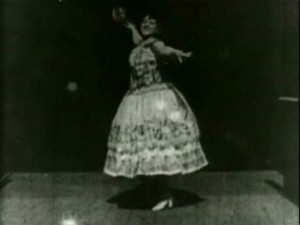 Ken Wlaschin’s Encyclopedia of Opera on Screen lists Thomas Edison’s 1894 Carmencita as the “First film with possible opera content.” We see it today as a silent sequence of dancing. But it’s known that Edison intended to make opera movies with sound. His first motion-picture patent caveat in 1888 specified opera as the only purpose of movies, and a press conference he held in Chicago in 1891 indicated that he wanted to deliver operas live — with sound and in color — directly to homes. The “Dickson Experimental Sound Film,” made at about the same time as Carmencita in the same studio, is a synchronized-sound movie and features what appears to be Edison employee William Dickson playing music from Robert Planquette’s opera Les cloches de Corneville on a violin. So it’s possible that Carmencita is dancing to an intended sync-sound opera tune, but the associated cylinder has not yet been found or identified.
Ken Wlaschin’s Encyclopedia of Opera on Screen lists Thomas Edison’s 1894 Carmencita as the “First film with possible opera content.” We see it today as a silent sequence of dancing. But it’s known that Edison intended to make opera movies with sound. His first motion-picture patent caveat in 1888 specified opera as the only purpose of movies, and a press conference he held in Chicago in 1891 indicated that he wanted to deliver operas live — with sound and in color — directly to homes. The “Dickson Experimental Sound Film,” made at about the same time as Carmencita in the same studio, is a synchronized-sound movie and features what appears to be Edison employee William Dickson playing music from Robert Planquette’s opera Les cloches de Corneville on a violin. So it’s possible that Carmencita is dancing to an intended sync-sound opera tune, but the associated cylinder has not yet been found or identified.
Even before Edison’s caveat, Louis Aimé Augustin Le Prince shot some movie sequences. The Secretary of the Paris Opera certified the achievement as “Method and Apparatus for the projection of Animated Pictures in view of the adaptation to Operatic Scenes.”
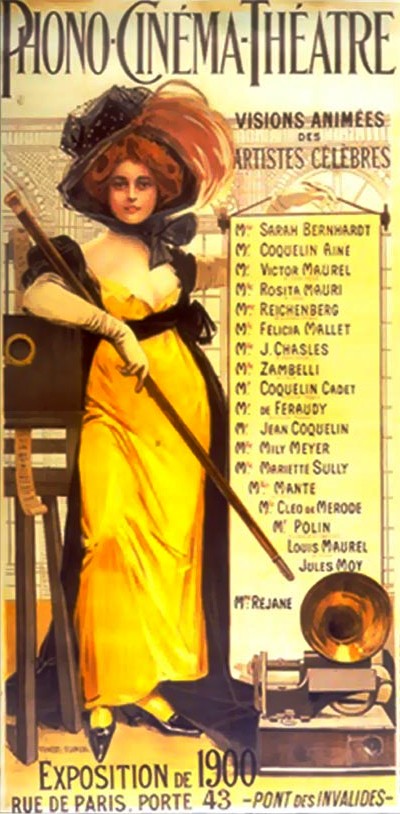 A touring production of Carmen by the Rosabel Morrison Company beginning in 1896 featured a brief movie of a bullfight. It was many Americans’ first experience of motion pictures.
A touring production of Carmen by the Rosabel Morrison Company beginning in 1896 featured a brief movie of a bullfight. It was many Americans’ first experience of motion pictures.
There were many other opera-related movies prior to 1898, when sound again (literally) entered the picture. A 15-minute version of Flotow’s Martha was shot that year. It was shown the following year at the Eden Musée in New York with the singers lip-synching to themselves behind the screen.
One year later, at the 1900 Paris World’s Fair, visitors to the Phono-Cinéma-Théâtre were able to watch and listen to synchronized-sound arias (though the synchronization depended on the lip-synching skills of the singer when the film was shot and the projectionist when it was screened). In 1902, the Electro Talking Bioscope offered a synchronized-sound aria from Carmen.
Wlaschin refers to “the first epic opera films” being made in 1904 and the “First complete opera to be filmed” (a sound version of Gounod’s Faust) in 1907. The following year La mort du duc de Guise was released; although it was a “silent” movie, it featured the first original film score, written by opera composer Camille Saint-Saëns. A sound version of Pagliacci was made in the U.S. in 1913.
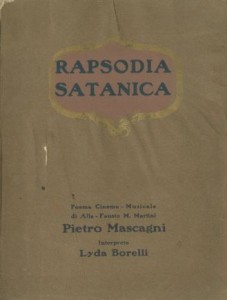 So what should make Mascagni’s Rapsodia Satanica the first film opera? It was shot after all of the above, and Mascagni began composing its score in 1914 (carefully matching it to the movie).
So what should make Mascagni’s Rapsodia Satanica the first film opera? It was shot after all of the above, and Mascagni began composing its score in 1914 (carefully matching it to the movie).
I believe it is because it has a libretto (it’s the only silent movie I know of that has one). The libretto was written by Fausto Maria Martini (separately from the screenplay) and was published with several still images from the movie. You can find it here: http://www.mascagni.org/book-reader/image/504842/1/0
Comment: I just (2013 March 19) discovered that, despite its being called an opera in many references, Rosabel Morrison’s Carmen was a play based on the Mérimée story, not an opera. Sorry!
Comment: I also recently discovered, at an exhibition at the Library of the Performing Arts in New York City, that Carmencita was the stage name of Carmen Dauset, “the Pearl of Seville,” a flamenco dancer born in Almería, Spain, in 1868: http://www.nypl.org/events/exhibitions/flamenco-100-years-flamenco-new-york
She is the subject of the short Edison film: http://www.metmuseum.org/toah/works-of-art/06.969
24. Opera and the First Million-Selling Recording (2012 August 2)
Today is the anniversary of Enrico Caruso’s death. His 1907 recording of the aria “Vesti la giubba” appears to be the earliest recording to eventually sell a million copies. It has never been unavailable. But it wasn’t the first record to sell a million copies.
That was probably Vernon Dalhart’s 1924 “The Wreck of the Old 97.” Born Marion Try Slaughter, Dalhart studied voice at the Dallas Conservatory of Music and was, before becoming a country star, an opera singer.
Comments:
Maria Nockin: Did you folks know that Andy Griffith studied opera in school?
Steve Lampen: I thought it was “O sole mio.” (off-topic: When did one-sided 78s become two-sided?)
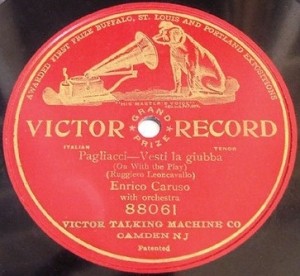 Mark Schubin: Nope! Because of limited record keeping and release, it is difficult to say which was the first to sell a million copies, but it’s pretty well established that Caruso’s “Vesti la giubba” was the earliest recording to do so (he also recorded the aria twice before the 1907 version). Of course, if a million of us choose to buy an even earlier one, we can easily change history.
Mark Schubin: Nope! Because of limited record keeping and release, it is difficult to say which was the first to sell a million copies, but it’s pretty well established that Caruso’s “Vesti la giubba” was the earliest recording to do so (he also recorded the aria twice before the 1907 version). Of course, if a million of us choose to buy an even earlier one, we can easily change history.
As for the dual sides, I’m out of town, so I can’t check my usual references, but this site puts it no later than 1900 and possibly as early as 1894: http://www.audiohistory.com/files/documents/Allen-BothSidesNowA.pdf
By the way, the “B” side of Vernon Dalhart’s “The Wreck of the Old 97” was “The Prisoner’s Song.” The official Vernon Dalhart web site <http://www.vernondalhart.com/> says “The Prisoner’s Song” was the runaway hit, even though it was the B side.
25. What Was The First Opera Playback? (2012 August)
In the discussion “Playback of Opera Before the Advent of Recording” I reported on a music box from about 1830 that played a tune from an 1823 opera. I’d love to know when the first opera was played back. Although I don’t (yet) know what that is, I now know it could be contemporaneous to almost any one of them.
Here is a link to an item in the collection of the Metropolitan Museum of Art in New York: http://bit.ly/RqhIIA. They call it a musical clock, but it’s a 16-note barrel organ and a 16-note spinet that could be played independently. The link also shows the music composed for the device. The original pinned barrel (which controlled the sound) is in it. The Met Museum dates it to about 1625. It was made in Augsburg, Germany.
This thesis about Augsburg automatic musical instruments around 1600 <http://bit.ly/S2W8HO> indicates that the craft of pinning barrels (the pins controlled the links that created the sound) was probably imported to Augsburg from Italy in 1576, earlier than the date of what is commonly considered (these days) the first opera.
Incidentally, such opera composers as Handel and Mozart wrote pieces specifically for pinned-barrel playback devices.
I’m still looking for earlier dates (I have an appointment at a research library on Monday), but I have now traced opera playback at least back to 1783, roughly a century before Edison’s first phonograph. The instrument was a column clock made by Roentgen & Kinzing, and it played (and can probably still play) the dance of the blessed spirits from Gluck’s opera Orfeo ed Euridice, first performed in 1762.
Comment: Better make that 1738!
No, it wasn’t a typo; I’ve found an earlier opera playback. The 1783 machine belonged to Catherine the Great. The following year, the same makers provided a hammered-dulcimer-playing automaton to Marie-Antoinette. It played an aria from Gluck’s Armide.
You can see and hear it in this brief video: http://www.youtube.com/watch?v=75CXFwgslsY
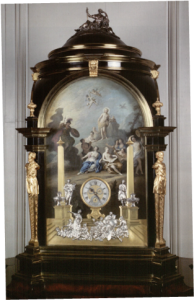 Ignore the music at the beginning (it’s not from that system) and the incorrect date. At the end, you’ll see “her” actually hammering a tune.
Ignore the music at the beginning (it’s not from that system) and the incorrect date. At the end, you’ll see “her” actually hammering a tune.
In 1738, however, Charles Clay provided a musical clock to the British royal family. It played ten tunes, all by Handel, two of them from operas: a minuet from Arianna (1734) and an aria from Berenice (1737).
The same source, Royal Music Machines by Jan Jaap Haspels, had a program, written in Handel’s hand, for another automated-music-machine cylinder, and it was dated 1732, but I have no indication that it was ever used prior to the 1738 machine.
Tantalizingly, Haspels found great commonality between music in Monteverdi’s 1607 opera L’Orfeo and that of some automated playback cylinders. Unfortunately, the cylinders pre-date the opera.
In fact, for those of you who have studied computer history and have read about the 1801 Jacquard loom, it was far from the first programmable device. Haspels has a 1714 musical clock with interchangeable cylinders, another from 1596 with a programmable cylinder, and one even before that, from around 1480, with a simple but programmable music-control cylinder.
By the way, the photos in Haspels’s book are gorgeous!
Another comment: I’ve now confirmed opera playback at least five years before the Clay clock. It was in the Microcosm of Henry Bridges, first shown publicly in 1733. It played pieces from two Handel operas. Unfortunately, only a portion of the clock mechanism is known to exist today, but it was well documented when it existed.
26. More on Lighting (2012 August 26)
I’ve written here about lighting in opera houses, including how it sometimes meant you were putting your life at risk to see the opera. But I didn’t provide pictures.
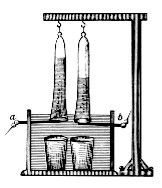 I’ve just done a post on my regular blog on the history of television lighting, and you’ll find some opera-lighting-related pictures there, including a 1638 dimming system for candles and an 1800 electrolysis system used to generate hydrogen and oxygen, later used in limelight. In fact, it might be amusing to note that the first three uses of electricity for opera-house lighting had nothing to do with incandescent light bulbs: in addition to the electrolysis for limelight, there was arc lighting (used for special effects) and electric re-ignition of gas lights after a stage blackout.
I’ve just done a post on my regular blog on the history of television lighting, and you’ll find some opera-lighting-related pictures there, including a 1638 dimming system for candles and an 1800 electrolysis system used to generate hydrogen and oxygen, later used in limelight. In fact, it might be amusing to note that the first three uses of electricity for opera-house lighting had nothing to do with incandescent light bulbs: in addition to the electrolysis for limelight, there was arc lighting (used for special effects) and electric re-ignition of gas lights after a stage blackout.
When incandescent lighting was finally introduced commercially, the first customers were opera houses. And, because the opera houses had to have their own generating plants (there were no electric-power companies yet), the opera houses were sometimes the first to use their excess capacity to light their surrounding neighborhoods.
Here’s the link: https://staging.sportsvideo.org/blogs/?blog=schubin-cafe&news=the-light-fantastic
Enjoy!
BTW, this Siemens timeline indicates that the very first land-based diesel-electric generator was installed at Rio de Janeiro’s opera house in 1909: http://www.siemens.com.br/templates/v2/Contents/timeline-en/timeline.swf
(There was an earlier diesel-electric plant installed on the Russian river tanker Vandal in 1903 as a means of getting the power to the propellers; the following year the same shipbuilder came up with a way to couple the diesel engine directly to the propellers, already used in a small French canal barge, Petit Pierre, and dropped the electric part.)
27. Richard Tucker and the Emotion Light (2012 August 28)
Today would have been tenor Richard Tucker’s 99th birthday. I had the privilege of working on capturing one of his performances on video in 1974.
There had been plenty of opera on television by that point. The first was in 1934!
Like that 1934 BBC Carmen, most of the others were all television productions. The person I was working for, John Goberman, wanted us to try to “transmit” the opera that was on stage rather than “produce” a television show. So our mandate called for invisible cameras and microphones, no affecting the audience, no affecting the performers, and no changing the staging, including the lighting.
Tucker was performing Canio in Pagliacci. Our cameras were adjusted for the incandescent stage lighting. The opera’s most famous aria, “Vesti la giubba” (Caruso’s million seller), was about to begin. 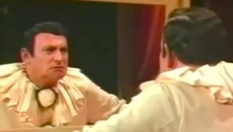 Tucker was in his play-within-the-opera dressing room on stage, in full view of the audience. His character had just been told his wife is unfaithful, and he had to put on his costume and be the clown without letting on.
Tucker was in his play-within-the-opera dressing room on stage, in full view of the audience. His character had just been told his wife is unfaithful, and he had to put on his costume and be the clown without letting on.
As the music rose to the line “Ridi, Pagliaccio, sul tuo amore infranto” (“Laugh, clown, at your broken love”), Tucker stood, leaving the incandescent glow of the dressing-room mirror, and was hit with a spotlight… that was not color corrected! He turned blue! Argghh!
On the other hand, he was singing about how blue he was feeling. It was perfect!
Maybe someday I’ll tell you how our screwing up the lighting in a different opera led to one of the greatest performances I’ve ever seen of Otello.
Comments:
Lan Xiao: With regards to taping performances at the Met using “invisible cameras”, I believe you mentioned on another forum about using similar method to tape Hoffmann with Domingo and Sutherland in 1973. From the clips that were leaked out, I thought the end result looked quite fine. I wonder if there have been many such tapings that you worked on or you are aware of. Maybe this is a bit sensitive, but just want to know if the Met actually do have a much larger video collection of its in-house performances than what have been telecast/released. It would be great if they do, as even if for various reasons those videos won’t be released in near future, it’d be a comfort to know some historically important moments have been preserved.
Mark Schubin: The operas that were shot as experiments were, when last I checked, in possession of the media department of Lincoln Center for the Performing Arts or the Met. I am not personally aware of any leaks. They were for research purposes only. These are all the operas there were:
1973 December 3 – Metropolitan Opera – Les contes d’ Hoffmann
1974 March 12 – New York City Opera – Ariadne auf Naxos
1974 November 5 – Metropolitan Opera – Cavalleria rusticana and Pagliacci
The experimental program also included chamber music and symphonic concerts, ballet, and theater. The last was a New York Philharmonic concert (with Isaac Stern) on 1975 May 17.
In addition to the operas listed above (and later ones that were part of Lincoln Center and Met broadcasts), Goberman (without my involvement) also transmitted Le coq d’or from New York City Opera on Manhattan’s two cable-TV systems on 1971 November 9. The event was covered by The New York Times.
I wasn’t there, but based on what I was told and have read it used cameras with USAF-developed secondary-electron-conduction tubes for ultra-high sensitivity, so it’s likely there was no lighting adjustment made. I began working with Goberman the following year.
So, I guess there might have been four “captured” operas before the “Pagliacci.”
Winston Tharp: There’s a short cut from the 1971 Le Coq D’Or online at http://www.beverlysillsonline.com/videoroom/hymntothesun.htm. It’s in B&W and mono. I wonder if a recording in color and stereo exists.
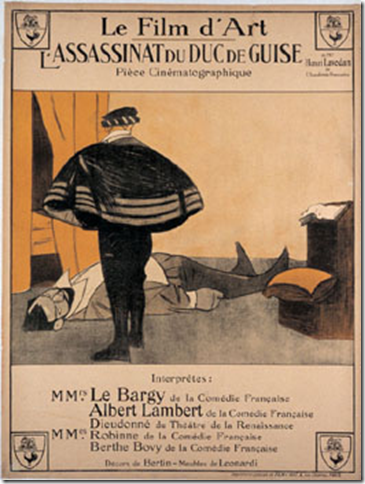 28. Operas, Scores, and Movies (2012 October 9)
28. Operas, Scores, and Movies (2012 October 9)
Today, October 9, is the birthday of opera composer Camille Saint-Saëns. He also composed what is considered to be the first film score, for the 1908 French movie originally called La Mort du duc de Guise (English title: The Assassination of the Duke de Guise).
Previously, pre-existing opera music was often used in movies. Edison’s 1894 short Carmencita seems to work well with the “Habanera” from the opera Carmen in the background. The oldest existing synchronized-sound movie (1894-95) features Edison employee William Dickson playing the “chanson du mousse” from the opera Les cloches de Corneville on a violin.
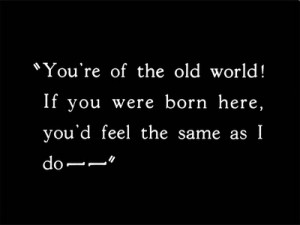 Between that movie and The Jazz Singer, which supposedly introduced the age of sound (but was itself largely without spoken dialogue and used plot-advancing textual “intertitles”), there were many synchronized-sound opera movies, including a “full-length” (22-reel) Faust in 1907. There were also many synchronization mechanisms, from singers standing behind the screen watching their projected characters (Martha in 1899) to the projectionist adjusting cranking speed to match phonograph playback (at the Phono-Cinéma-Théâtre at the Paris World’s Fair in 1900).
Between that movie and The Jazz Singer, which supposedly introduced the age of sound (but was itself largely without spoken dialogue and used plot-advancing textual “intertitles”), there were many synchronized-sound opera movies, including a “full-length” (22-reel) Faust in 1907. There were also many synchronization mechanisms, from singers standing behind the screen watching their projected characters (Martha in 1899) to the projectionist adjusting cranking speed to match phonograph playback (at the Phono-Cinéma-Théâtre at the Paris World’s Fair in 1900).
When there were live musicians in the cinema auditorium, there were many cueing mechanisms. They included a pattern of lights built into the set that was being shot, a small image of a conductor placed at the bottom of the screen, and, most complex, a scrolling image of the score at the bottom (backwards, so it could be seen properly by performers behind the screen), with an arrow pointing to the current note.
You might wonder why, if sync sound had been available since 1894, the “sound” movie era took so long to arrive. But there were no amplifiers in 1894, and, even if there were, to which would you rather listen: canned sound or live musicians?
Opera composer Pietro Mascagni also wrote a film score, for the 1915 movie Rapsodia Satanica. That movie has been called the first “film opera.” I’m not sure why, except that it’s the only “silent” movie I know of that has a libretto. It’s not just that there’s a book of the poem the movie is based on; the libretto includes stills from the movie.
In 1927, Kurt Weill’s opera Royal Palace included a film interlude in the score (Alban Berg’s more famous 1937 Lulu has the same). In 1928, Weill literally added a phonograph recording to the score of Der Zar lässt sich photographieren (The Tsar Gets Photographed); intended to be played during the opera, the record was distributed in a sleeve in the score.
 And the award goes to… Erich Wolfgang Korngold! That opera composer won the Academy Award for best original score for The Adventures of Robin Hood in 1938 (his score for Anthony Adverse in 1936 also won an Oscar, but in those days it went to the head of the studio’s music department, not to the composer). Opera composer Bernard Herrmann’s score for The Devil and Daniel Webster in 1941 also won the Academy Award. Herrmann also wrote the portion of the fake opera Salammbô heard in Citizen Kane (there are also real operas by that name).
And the award goes to… Erich Wolfgang Korngold! That opera composer won the Academy Award for best original score for The Adventures of Robin Hood in 1938 (his score for Anthony Adverse in 1936 also won an Oscar, but in those days it went to the head of the studio’s music department, not to the composer). Opera composer Bernard Herrmann’s score for The Devil and Daniel Webster in 1941 also won the Academy Award. Herrmann also wrote the portion of the fake opera Salammbô heard in Citizen Kane (there are also real operas by that name).
The Academy-Award tradition continues. Opera composer Tan Dun won for the score for Crouching Tiger, Hidden Dragon in 2000. In 2007, his opera The First Emperor was transmitted live to movie theaters worldwide. What goes around comes around.
29. “No opera, no X-rays!” (2012 October)
The headline above was as surprising to me as it might be to you. Here’s the story.
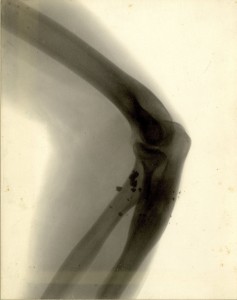 The first paper about x-rays, Wilhelm Röntgen’s “Über eine neue Art von Strahlen” (“About a new kind of rays”), was submitted for publication on December 28, 1895. By April of the following year Dr. Ernest Amory Codman had already been qualified in a Boston court as an “Expert in X-ray.”
The first paper about x-rays, Wilhelm Röntgen’s “Über eine neue Art von Strahlen” (“About a new kind of rays”), was submitted for publication on December 28, 1895. By April of the following year Dr. Ernest Amory Codman had already been qualified in a Boston court as an “Expert in X-ray.”
Codman was the first “skiagrapher” (shadow printer, what we’d today call a radiologist) at Boston Children’s Hospital. He was succeeded by Dr. Percy Emerson Brown, author of the headline above. Dr. Brown established what was then called the Department of Roentgenology there.
Did Dr. Brown refuse to make radiological images unless he got opera tickets? No, it was more basic. An X-ray tube requires electricity, something opera houses had before there were power companies.
Here’s his full quote: “The first X-ray department at the Children’s was limited in its function by reason of the fact that the hospital was not equipped with electric current, and was obliged to obtain its power from the Opera House nearby. A wire was run from the Opera House to the Hospital, but when there was no music there was no current. No opera, no X-rays!”: http://www.ajronline.org/content/161/4/887.full.pdf
I’m not yet certain to which opera house Dr. Brown referred. The first “Boston Opera House” wouldn’t be built until 1909. But there were places in Boston at the time where one could go to see opera.
Ernani was performed in the Howard Athenaeum (formerly the Millerite Tabernacle) in 1847 (shortly after “the Great Disappointment”); Fidelio was performed in the Boston Theatre (later the Academy of Music) in 1854. Besides in places called Academy, Athenaeum, Tabernacle, and Theatre, operas were also performed in Boston prior to the Children’s Hospital X-rays in places that went by the designations Alhambra, Garden, Hall, Museum, and Temple (and possibly also Adelphi, Amphitheatre, Palais Royal, and Saloon).
Some sites were actually called Opera House — Dudley-Street, Gray’s, Pell & Trowbridge’s, School-Street, Siege of Paris, Union’s, and, starting in 1888, Grand (not too far from Children’s Hospital at the time) — but how much opera they provided is a matter of question. The Grand Opera House certainly looked the part, complete with large auditorium, boxes, and orchestra pit, but the only exterior photograph I’ve seen of it, from 1890, has two large signs indicating that it featured “All Star Wrestling — Three Great Bouts to a Finish — Every Monday Night.” It was also located in a neighborhood that was then considered a “red-light district”: http://rfi.bostonhistory.org/boston/full/001448.jpg
 Although (because the Boston Theatre wasn’t available) the Grand Opera House had a poorly attended Otello in its opening season, its first offering was The Arabian Nights by the Imperial Burlesque Company. According to historian Douglass Shand-Tucci, it should never be confused with the Boston Opera House. “That opera house knew Caruso and Pavlova, neither of whom I’m sure had ever heard of the Grand Opera House”: http://www.backbayhistorical.org/blog/archives/1032
Although (because the Boston Theatre wasn’t available) the Grand Opera House had a poorly attended Otello in its opening season, its first offering was The Arabian Nights by the Imperial Burlesque Company. According to historian Douglass Shand-Tucci, it should never be confused with the Boston Opera House. “That opera house knew Caruso and Pavlova, neither of whom I’m sure had ever heard of the Grand Opera House”: http://www.backbayhistorical.org/blog/archives/1032
Still, neighborhood, wrestling, burlesque, and all, it seems likely to have been the opera house that supplied the electric power necessary to run the first pediatric radiology department in the U.S. And maybe Dr. Brown didn’t check what was being performed at his power source.
Comments: People often ask where I find this stuff, and this one is still clear in my mind, so here it is:
I’ve written previously about how opera houses, often first in their neighborhoods with generators, would supply electric power to others. So, I was searching for more info on that when I came across an American Institute of Architects presentation on hospital design. It had the “No opera, no X-rays” line, taken from a pictorial history of radiology. That led me to the American Journal of Roentgenology paper linked above, which led me to a paper in the Harvard Medical Alumni Bulletin in 1947.
A friend at the Library of Congress told me the New York Academy of Medicine library had that, so I went over and had a look. That’s where I found the full quote, followed by “Percy Brown, 1900.”
I knew from the other sources that Brown had established the roentgenology department at Boston Children’s Hospital in 1903 (Codman had been skiagrapher there previously but didn’t create a department), so I was surprised to find what seemed a reference to the hospital by Brown three years before he got there. But there were no 1900 references by Brown in the 1947 Harvard bulletin paper. So I looked up “Percy Brown” and 1900 and got a reference to his marriage in 1904. Then I looked at the publication cited. It was from the Harvard Medical Alumni Association.
Duh!
Like other alumni, Percy Brown, Harvard Medical School class of 1900, had sent Merrill Sosman, author of the 1947 paper about “Roentgenology at Harvard,” a letter with the information.
As for the opera and opera house info, there’s a wealth of scanned books online. This one discusses the opening season of the Grand Opera House in some detail: http://openlibrary.org/books/OL7204331M/The_dramatic_year_1887-88
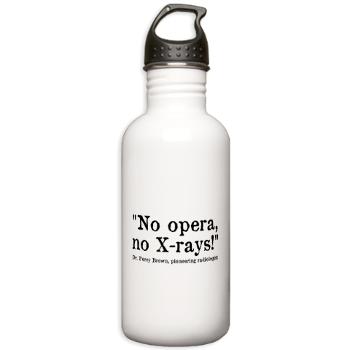 The hardest thing was locating where Boston Children’s Hospital was at the time. No one there today either knew or was willing to say, so I checked some old maps and other sources (I found a great picture of a herd of cows grazing across the street from its 1919 location; the hospital used them to obtain “healthy” milk for its patients).
The hardest thing was locating where Boston Children’s Hospital was at the time. No one there today either knew or was willing to say, so I checked some old maps and other sources (I found a great picture of a herd of cows grazing across the street from its 1919 location; the hospital used them to obtain “healthy” milk for its patients).
By the way, I’ve opened a “shop” for “No opera, no X-rays!” merchandise, from T-shirts to hip flasks to gym bags. All profits go to Opera America, the national service organization for opera: http://www.cafepress.com/no_opera_no_x_rays
30. Baseball at the Opera House and Opera on the Ball Park (2012 October)
My Library of Congress blog post has just been published: http://blogs.loc.gov/inside_adams/2012/10/watching-baseball-at-the-opera-house/
Enjoy!
31. The First Opera Broadcast and the 200-Ton Musical Instrument (2012 October)
The Metropolitan Opera Saturday-matinee radio broadcasts began on Christmas 1931, but that was by no means the first opera broadcast; it wasn’t even the Met’s first. Cesare Sodero’s opera Ombre Russe was broadcast in its entirety on NBC in 1929 before it even opened on stage. The previous year, a trimmed version of African-American composer Harry Freeman’s opera Voodoo was broadcast on WGBS.
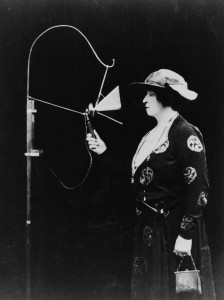 In 1926, Teatro Colón in Buenos Aires ordered its own radio transmitter for opera; it’s possible they were inspired by their smaller rival, Teatro Coliseo, which transmitted an entire opera season (!), starting with Parsifal, in 1920. Those transmissions, in turn, were inspired by a wireless experiment by opera star Nellie Melba (after whom Melba toast and peach Melba are named) earlier that year from the Marconi factory in Chelmsford,England. It was powerful enough to be heard on different continents (within about a thousand-mile radius), and it was probably the source of the first off-air recording (at the Eiffel Tower).
In 1926, Teatro Colón in Buenos Aires ordered its own radio transmitter for opera; it’s possible they were inspired by their smaller rival, Teatro Coliseo, which transmitted an entire opera season (!), starting with Parsifal, in 1920. Those transmissions, in turn, were inspired by a wireless experiment by opera star Nellie Melba (after whom Melba toast and peach Melba are named) earlier that year from the Marconi factory in Chelmsford,England. It was powerful enough to be heard on different continents (within about a thousand-mile radius), and it was probably the source of the first off-air recording (at the Eiffel Tower).
Previous test transmissions took place in the factory workshop, but that was considered too dirty for Melba, so a microphone line was run to a front office. Unfortunately, when the transmitter was turned on, the microphone exploded, and its line set fire to the carpet; she sang in the workshop. The Postmaster General later shut the transmissions down because they were interfering with other communications (primarily direction finding at Croydon airfield).
It wasn’t the most-powerful opera broadcast to date. That was probably from the New Brunswick Opera House (in New Jersey) in April 1919, transmitted by naval station NFF and heard on board the U.S.S. George Washington, at least 2000 miles away.
The first complete opera carried wirelessly by radio (was it a broadcast if almost no one had receivers?) was Cavalleria Rusticana from the Met (where Lee De Forest’s transmitter was) on January 13, 1910. It was followed the same day by Pagliacci (with Enrico Caruso) and was preceded the previous day by two acts of Tosca.
But those weren’t the first wireless transmissions of opera music. At the Paris World’s Fair of 1900, people could listen wirelessly to opera music, and they didn’t even need radios! Horace Short took his compressed-air-amplified gramophone to the top of the Eiffel Tower and played opera records.
As for radio, if he actually did a Christmas Eve radio “broadcast” in 1906, Reginald Fessenden played a record of opera music (from Handel’s Serse) as part of it, but media-technology historian James O’Neal has come very close to proving it never happened. On March 1, 1907, however, the New York Herald ran an article headlined “Grand Opera by Wireless.” The story discussed a radio transmission of opera music from Telharmonium Hall to the Yale Club that night.
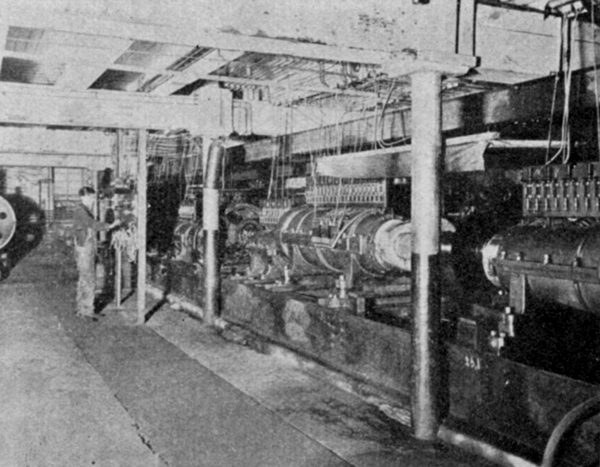 The Hall was across the street from the Met and housed what might be described as the first music synthesizer, originally developed in 1897, using an alternator for each pitch and harmonic. There were two consoles with eight 84-key keyboards each. The 1907 version weighed some 200 tons; a Boeing 737 aircraft, fully loaded with passengers, baggage, freight, and fuel, has a maximum take-off weight of about 87 tons.
The Hall was across the street from the Met and housed what might be described as the first music synthesizer, originally developed in 1897, using an alternator for each pitch and harmonic. There were two consoles with eight 84-key keyboards each. The 1907 version weighed some 200 tons; a Boeing 737 aircraft, fully loaded with passengers, baggage, freight, and fuel, has a maximum take-off weight of about 87 tons.
In addition to feeding music to the Hall, the Telharmonium also fed dinner music to a number of New York restaurants via phone lines (yes, a precursor of Muzak). But AT&T engineer Robert E. Chetwood, Jr. ran tests and found that, based on the power of all of those alternators, “the music was induced on practically every other circuit… with a sufficient loudness to be considered extremely serious.”
If phone lines were a problem, why not radio? That’s what led to De Forest’s 1907 opera-music transmission. But four days later the chief electrician of the Brooklyn Navy Yard came to Telharmonium Hall to complain of interference to his wireless transmissions.
Ah, well.
32. Opera and Street Organs (2012 October)
Two discoveries in media-technology and opera history were made this year at the small Morris Museum in Morristown, New Jersey. Both were made in their Guinness Collection of Mechanical Musical Instruments & Automata: http://morrismuseum.org/mechanical-musical-instruments-automata/
The first (and much more significant one) was made in January by Professor W. Anthony Sheppard, head of the music department at Williams College. He had been working at the Institute for Advanced Study at Princeton (Albert Einstein’s academic home) and was heading back north, looking for stopping places to entertain his children. A collection of mechanical music and automata sounded good, so off he went.
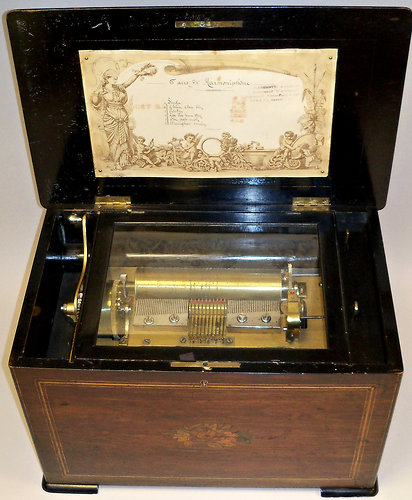 While the kids ran around looking at robotic banjo players and the like, Sheppard noticed a device with Chinese characters on its label. To make a long story short, Sheppard discovered what appears to be the long-sought source of melodies used by Puccini in his operas Madama Butterfly and Turandot. The New York Times reported on Sheppard’s discovery in a huge article on the front page of their June 15 arts section, leading to the second discovery, when I went out to see that music box and visit the collection.
While the kids ran around looking at robotic banjo players and the like, Sheppard noticed a device with Chinese characters on its label. To make a long story short, Sheppard discovered what appears to be the long-sought source of melodies used by Puccini in his operas Madama Butterfly and Turandot. The New York Times reported on Sheppard’s discovery in a huge article on the front page of their June 15 arts section, leading to the second discovery, when I went out to see that music box and visit the collection.
The Puccini item was nice, others were fun, and a lecture-demo was highly educational, but my epiphany came when I heard a music box’s rendition of an opera tune. That’s when it dawned on me that opera music had been disseminated long before phonograph recordings. I began reporting on that here in the discussions “Playback of Opera before the Advent of Recording” and “What Was the First Opera Playback?”
In the first of those I mentioned street organs and opera. I’ve been doing some more research into those. They seem to have originated in Italy in the middle of the 18th century and by the end of the 19th were in major cities across Europe and North America.
I’ve come across a couple of stories related to two foibles of such playback that I’d like to share. One is about cranking speed. Here is how it was reported in the London publication Pick-Me-Up on April 20, 1895 under the headline “A DISTINGUISHED ORGANIST”:
“During [opera composer Pietro] Mascagni’s visit to London, he heard, while at his room at an hotel, an organ-grinder play the intermezzo from Cavalleria Rusticana. The man, playing the piece too fast all through, exasperated Mascagni, and descending into the street the composer addressed the organist, saying:
“‘You play this too fast. Let me show you how it ought to be played.’
“‘And who are you?’ asked the wandering minstrel.
“‘I happen to be the composer of that piece,’ replied Mascagni, and then he played the intermezzo for the astonished organ-grinder in the correct tempo.
“The following day the same organ-grinder appeared in front of the hotel with a large placard on the organ, on which was inscribed in large letters: ‘PUPIL OF MASCAGNI.’”
The other is about tuning, something organ-grinders rarely had time to do, with cacophonous results. Arthur W. J. G. Ord-Hume wrote in his 1978 book Barrel Organs that “A high proportion of their earnings was in the form of money given to them by people as an inducement for them to quit their earshot.”
The book also cites this report of a new instrument that appeared in the summer of 1900: “Being driven by a spring motor, the organ was to be set going and those annoyed by it would secure the ‘silence of the torturer’ for a quarter of an hour by the insertion of a penny, after which it would start again.”
33. Discs before Discs: the First Opera for the Masses (2012 November)
I’ve done some recent posts on the playback of opera music long before the phonograph, based on musical clocks, barrel organs, and even instrument-playing automata (one of which, I’m told, is in a new furniture exhibit atNew York’s Metropolitan Museum of Art). But those devices were too expensive for mass consumption; they were either owned by the very rich or exhibited to paying audiences.
Even after the comb-based music box was introduced towards the end of the 18th century, mechanical music reproduction was still expensive. Each note-playing cylinder had to be crafted individually.
Thomas Edison’s first phonograph, in 1877, was similarly unfriendly to mass reproduction, which is one reason he wrote that its primary purpose was for “letter writing.” Even after the Edison phonograph was “perfected” in 1888, its cylinders still had to be recorded individually, which is why many phonographs would be crowded around a performer to capture as many master recordings as possible (allowing the later recreation of stereo by using two spatially displaced cylinders).
A different 1888 invention, Emile Berliner’s disc-based gramophone, eliminated that mass-audience problem. Record discs could replicated inexpensively by stamping.
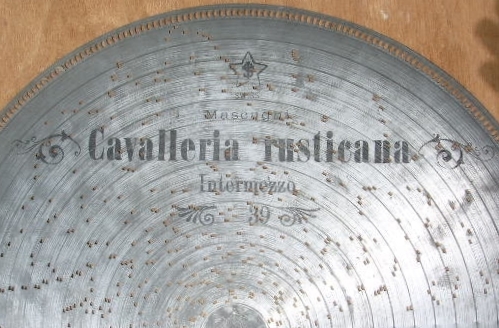 Shortly before Berliner’s invention, however, two other inventors came up with systems for relatively inexpensive stamped-disc-based music playback. Ellis Parr, in London, received his first patent in 1885, and at almost the same time Oscar Paul Lochmann, near Leipzig, came up with his version. Each had useful characteristics, so the two collaborated on what became known as the Symphonion.
Shortly before Berliner’s invention, however, two other inventors came up with systems for relatively inexpensive stamped-disc-based music playback. Ellis Parr, in London, received his first patent in 1885, and at almost the same time Oscar Paul Lochmann, near Leipzig, came up with his version. Each had useful characteristics, so the two collaborated on what became known as the Symphonion.
Their discs were made of sheet metal into which holes were punched. Instead of smoothing off the pieces of metal that formerly occupied the holes, however, they left them attached to the discs so they could pluck music-box combs (and control other instruments). Punching sheet-metal discs was much less expensive than sticking pins into music-box barrels (or even molding them), and the discs could also be easily changed. In England, discs were said to cost only “a few pence;” I’ve seen U.S. catalogs in which they were sold for 20 cents each.
The idea spread quickly, but U.S. import tariffs were a problem, so some former Lochmann employees who had established the Polyphon brand in Europe established Regina in the U.S. And after discs came disc changers, multi-disc players, and coin-operated systems — effectively the first juke boxes.
The opera connection is most apparent in those aforementioned catalogs. I can’t say my research has been exhaustive, but I’ve seen many catalogs and ads for disc-based music boxes, and, in every one I can recall (even the coin-operated models), the tune on the disc or discs being displayed was from an opera, the name of the opera printed on the disc in big letters.
The three most popular (in the images in the ads and catalogs) seem to have been the intermezzo from Mascagni’s Cavalleria Rusticana, the polonaise from Thomas’s Mignon, and the overture from Hérold’s Zampa. But the opera-tune listings in the catalogs were huge, with works by such well-known opera composers as Bellini, Bizet, Donizetti, Flotow, Gounod, Handel, Mendelssohn, Meyerbeer, Mozart, Rossini, Sullivan, Verdi, Wagner, and von Weber as well as such lesser-knowns as Bishop, Boïeldieu, Lortzing, Nicolai, Paladilhe, and Planquette.
You can listen to an early Cavalleria Rusticana intermezzo on a Symphonion here: http://musicboxmaker.com/6217Symphonion/62CavalleriaRusticana.mp3
The next link is to a Saydisc album called Mechanical Opera. I recommend clicking on the second sample on the right (labeled “Gounod & Bizet”) and waiting for the second version, when you can hear a harmonically rich version of the soldiers’ chorus from Faust: http://www.wyastone.co.uk/mechanical-opera.html
Incidentally, Regina, the first U.S. manufacturer of disc-based music boxes, had sales that grew to more than $2 million a year, but they could see competition from phonographs and gramophones becoming a problem, so they dropped “Music Box” from the company name in 1902 (the same year Caruso made his first recording) and added more products, ranging from player pianos to presses (remember the stamping process) to, yes, vacuum cleaners. They went bankrupt more than once and were sold to different parents (including Philips and Oreck). Today, what’s left is owned by Royal.
You can’t buy a new Regina opera-playing music box anymore. But, if you buy a Home Depot-brand vacuum cleaner today, chances are good that it was made by the company that owns what’s left of the company that helped bring opera music to the masses.
34. Opera Furniture (2012 December)
Yesterday, I went to the exhibit “Extravagant Inventions: The Princely Furniture of the Roentgens” atNew York’s Metropolitan Museum Of Art: http://www.metmuseum.org/exhibitions/listings/2012/roentgen
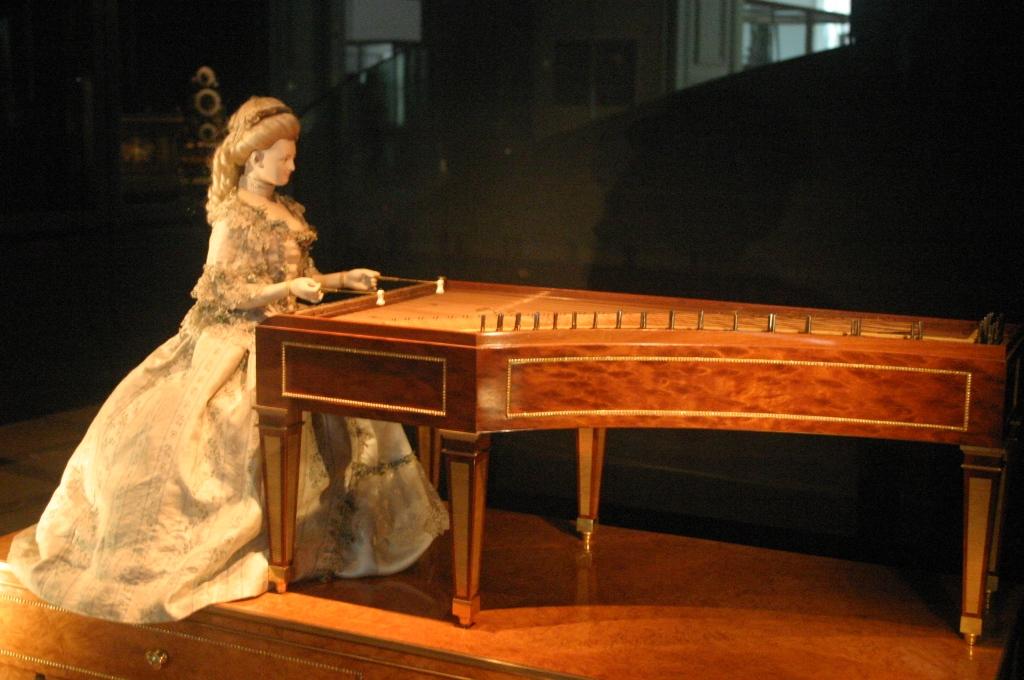 At least four of the objects on display include automatic music devices, and at least two of those play opera music by Gluck. At the heart of the exhibition is La Joueuse de Tympanon (the dulcimer player), an automaton that plays tunes on a hammered dulcimer. It was given to Marie Antoinette in 1784. She, in turn, gave it to the Academy of Sciences, which is why it survives today. It plays eight Gluck tunes (by actually hammering the dulcimer); two are from his operas. Another object is a column clock that once belonged to the empress Catherine the Great of Russia. According to the exhibition catalog, it is the only known 18th-century record of Gluck’s opera Iphigénie en Aulide.
At least four of the objects on display include automatic music devices, and at least two of those play opera music by Gluck. At the heart of the exhibition is La Joueuse de Tympanon (the dulcimer player), an automaton that plays tunes on a hammered dulcimer. It was given to Marie Antoinette in 1784. She, in turn, gave it to the Academy of Sciences, which is why it survives today. It plays eight Gluck tunes (by actually hammering the dulcimer); two are from his operas. Another object is a column clock that once belonged to the empress Catherine the Great of Russia. According to the exhibition catalog, it is the only known 18th-century record of Gluck’s opera Iphigénie en Aulide.
If you happen to be in the neighborhood, it might be worth a visit. It’s pay what you wish.
Here’s an audio selection from a long-case clock <http://shar.es/6ujo2> and here is a video of the dulcimer-playing automaton <http://shar.es/6ud7T>. They’ve removed parts of her clothing to show the mechanism.
Those are from the museum. This one is from a site dedicated to the magician Robert Houdin. Ignore the sound and text for the first 50 seconds, but then it shows the automaton’s playing better than the Met Museum video: http://www.youtube.com/watch?v=75CXFwgslsY
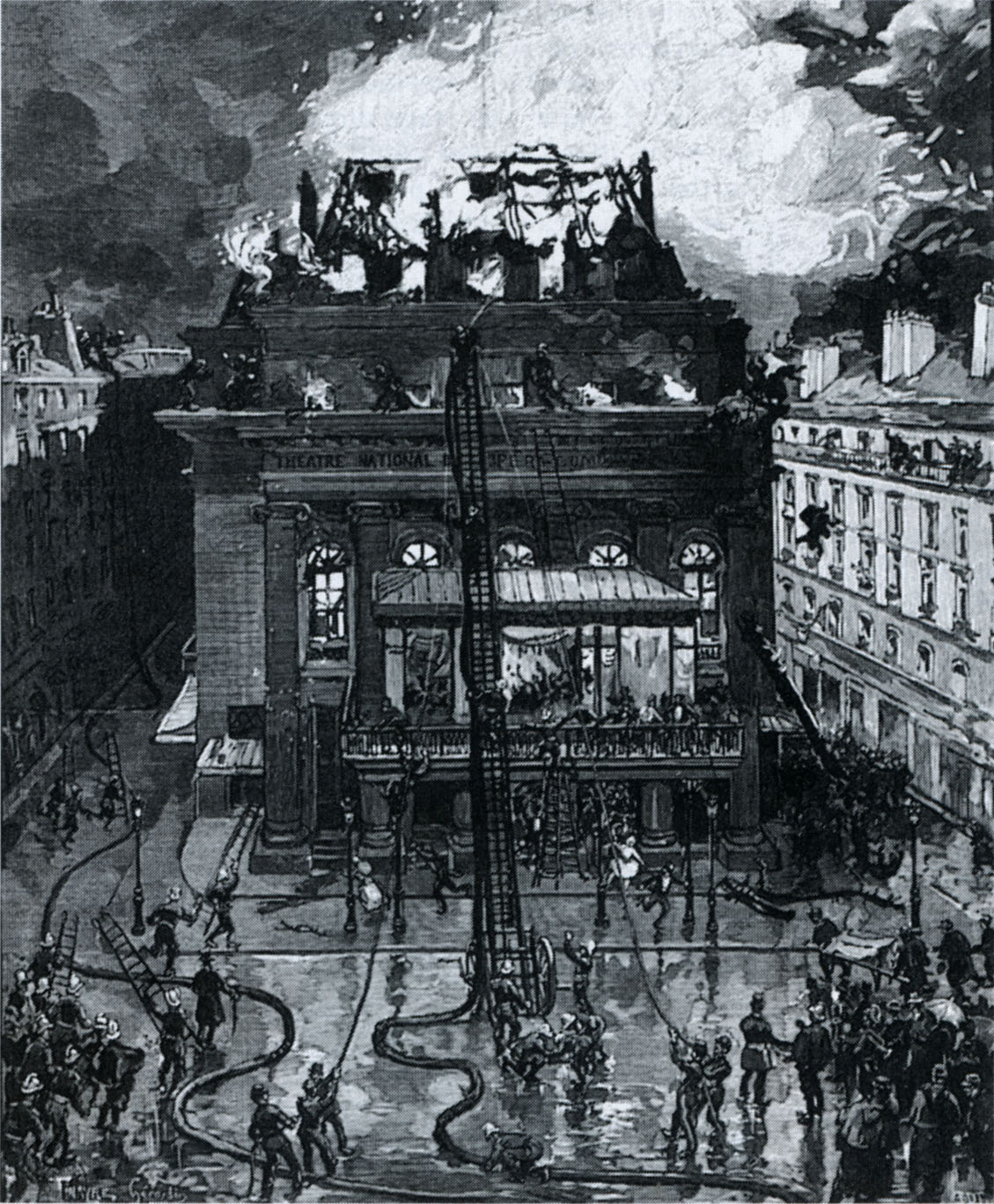 BTW, there’s another new exhibit at the Met, “Matisse: In Search of True Painting.” It’s terrific, too, but it might be even more meaningful if you bear in mind that Matisse was at the Opéra-Comique to see Mignon the night in 1887 when the scenery caught fire, burning down the opera house and killing 84 people. According to The Unknown Matisse: A Life of Henri Matisse: The Early Years 1868-1908 by Hilary Spurling (University of California Press, 2001), separated from his cousin in the stampede for the exits, Matisse “fought his way down to the ground floor, where he found thirty bodies piled up against a glass-paneled door that opened inwards” but was eventually saved by firefighters who made an opening. Despite that traumatic experience, Matisse later regularly attended the rebuilt Opéra-Comique for free as part of a “claque hired to clap on first nights” and applied for a job there as a guard (but didn’t get it).
BTW, there’s another new exhibit at the Met, “Matisse: In Search of True Painting.” It’s terrific, too, but it might be even more meaningful if you bear in mind that Matisse was at the Opéra-Comique to see Mignon the night in 1887 when the scenery caught fire, burning down the opera house and killing 84 people. According to The Unknown Matisse: A Life of Henri Matisse: The Early Years 1868-1908 by Hilary Spurling (University of California Press, 2001), separated from his cousin in the stampede for the exits, Matisse “fought his way down to the ground floor, where he found thirty bodies piled up against a glass-paneled door that opened inwards” but was eventually saved by firefighters who made an opening. Despite that traumatic experience, Matisse later regularly attended the rebuilt Opéra-Comique for free as part of a “claque hired to clap on first nights” and applied for a job there as a guard (but didn’t get it).
35. Opera and the Development of HDTV (2012 December)
I’ve been reading Philip Cianci’s new book High Definition Television: The Creation, Development and Implementation of HDTV Technology, and some of the entries reminded me of the amazing role opera played in that development. First, let me try to put the time frame into perspective.
Although the term “high-definition television” dates back to the 1930s, modern HDTV is much more recent. The first two TV stations in the United States that could broadcast it both went on the air in 1996, and one of those began broadcasting before it could even transmit any pictures (it just sent data bits).
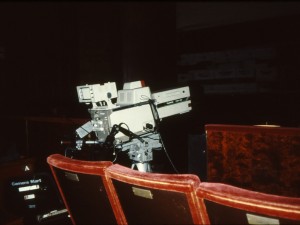 Nevertheless, the world’s first regularly scheduled live HDTV broadcast, seven years earlier, in 1989, included Norwegian soprano Sissel Kyrkjebø. Later that same year, Bavarian State Opera’s Ring cycle was recorded in HDTV, followed in 1990 by Seattle Opera’s War and Peace and the Metropolitan Opera’s Semiramide. At the time, HDTV equipment was so difficult to use that camera placement was determined, in part, by available cable lengths, and each tape had to be “burnished” in place by running it through a recorder, then cleaning the recorder, and only then being able to make the recording.
Nevertheless, the world’s first regularly scheduled live HDTV broadcast, seven years earlier, in 1989, included Norwegian soprano Sissel Kyrkjebø. Later that same year, Bavarian State Opera’s Ring cycle was recorded in HDTV, followed in 1990 by Seattle Opera’s War and Peace and the Metropolitan Opera’s Semiramide. At the time, HDTV equipment was so difficult to use that camera placement was determined, in part, by available cable lengths, and each tape had to be “burnished” in place by running it through a recorder, then cleaning the recorder, and only then being able to make the recording.
In 1991, still five years before those first two U.S. HDTV stations, New York City Opera put two giant HDTV screens outside the edges of the stage so people in the opera house could watch close-ups. That was followed by Houston Grand Opera’s and then San Francisco Opera’s OperaVision in-theater HDTV close-up displays.
By 1999, there were more HDTV stations on the air, but a technology debate was raging over interlaced vs. progressive HDTV scanning. That year, Washington Opera used the first progressive-scan HDTV production truck to shoot Le Cid. They were followed by Houston Grand Opera’s Little Women.
London’s Royal Opera House was the first to install its own, in-house HDTV-production facilities, followed by San Francisco Opera and then others worldwide. And, today, The Metropolitan Opera: Live in HD is the number-one “alternative content for cinema” worldwide.
36. The First Opera Seen Live ‘Round the World (2012 December)
The 2009 movie Angels and Demons begins at the European Nuclear Research Center (CERN) outside Geneva and approaches its denouement at Castel Sant’Angelo in Rome. Those sites made me think of global opera media.
CERN has some of the highest-speed, highest-capacity data links in the world, so, naturally, they were used for a test of the World Opera Project. The idea of the project is that singers, other musicians, and audiences could be located anywhere in the world, and they could be combined digitally into a unified opera performance. It’s a tricky proposition. Even at the speed of light, a connection between, say, Sydney and London would take so much time that it would be difficult for everyone to sing in unison. Adding more delay for coding used to reduce data rate would add to the problem, thus the use of the CERN facilities.
The Metropolitan Opera: Live in HD is already currently seen in 64 countries, but all of its performers are on the same stage. It also wasn’t the first opera sent live globally. In 1992, Tosca in the Settings and at the Times of Tosca was sent live by satellite to 107 countries. Each act of Tosca takes place at a specific location in Rome and at a specific time of day, so that’s where and when they were shot, including Act III at Castel Sant’Angelo. A positive review of the recorded version came from a viewer who had to get up at 4 a.m. in Australia to watch Act II.
That wasn’t the first opera transmitted live globally, either. The Metropolitan Opera transmitted 14 hours live on its centennial in 1983, but that, too, wasn’t the first.
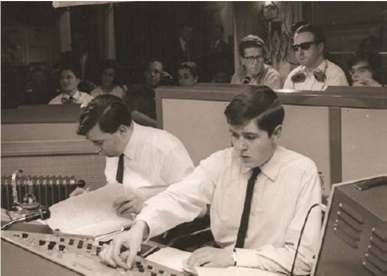 The first opera was seen live around the globe in 1967, a rehearsal of Lohengrin from the Bayreuth Festspielhaus on June 25 as part of the world’s first global broadcast, Our World. The program also included (among many other things) Van Cliburn and Leonard Bernstein rehearsing Rachmaninoff’s third piano concerto in New York and The Beatles recording “All You Need Is Love” in London.
The first opera was seen live around the globe in 1967, a rehearsal of Lohengrin from the Bayreuth Festspielhaus on June 25 as part of the world’s first global broadcast, Our World. The program also included (among many other things) Van Cliburn and Leonard Bernstein rehearsing Rachmaninoff’s third piano concerto in New York and The Beatles recording “All You Need Is Love” in London.
Here are some details about the program: http://www.paleycenter.org/collection/item/?q=the+beatles&p=11&item=B:06999
And you can watch most of it here: http://www.youtube.com/watch?v=aQsA6TNwWB8
37. 160 Years of Movie Technology and Opera (2012 December)
As 2012 draws to a close, I thought it time to celebrate 160 years of opera and movie history.
Actually, there was moving-picture projection used at the Hamburg opera house even longer ago; a 1726 production of Handel’s Giulio Cesare had the technology documented (the motion came from physically moved painted slides). On November 12, 1852, however, the world’s first photographic motion-picture patent was issued in France to Louis Jules Duboscq, who was, at the time, head of special effects at the Paris Opera (and it was for stereoscopic 3D movies).
Thomas Edison’s first filing about movie technology with the U.S. patent office saw no purpose to motion pictures other than the depiction of “a continuous opera.” Some people battling Edison’s patents pointed to the prior work of Louis Aime Augustin Le Prince, whose apparatus was certified by the secretary of the Paris Opera as being a “method and apparatus for the projection of animated pictures in view of the adaptation to operatic scenes.”
The oldest existing sync-sound movie (1894-5) depicts two Edison employees dancing as Edison’s chief movie assistant plays a tune from the opera Les cloches de Corneville on a violin. There were sync-sound opera movies with arias shown at the 1900 World’s Fair in Paris. In fact, most early movie sound systems were developed for opera. By 1908, a movie actor lip-synched to a recording of Caruso singing “La donna e mobile” from Rigoletto to demonstrate the Cinephon system, possibly the world’s first instance of lip-synching.
Many Americans had their first movie experiences in the late 19th century watching a filmed bullfight being projected as part of the last act of the Rosabel Morrison touring opera company’s production of Carmen. Its first performance was in 1896.
Other than spurring the development of sync-sound systems, opera’s big contributions to movies in the first half of the 20th century were stars (like Geraldine Farrar), directors (like Rouben Mamoulian), plots, and music. Opera music was often recommended for silent movies. The first film score was written by opera composer Camille Saint-Saëns for La Mort du duc du Guise in 1908; the first Academy Award for best score given to an individual went to opera composer Erich Wolfgang Korngold for The Adventures of Robin Hood. I’m not quite sure why the 1915 movie Rapsodia Satanica is sometimes called the “first film opera” except that its music was written by opera composer Pietro Mascagni, and it’s the only movie I know of that has a printed libretto.
A hundred years after Duboscq’s first movie patent, television was hurting the movie box office, so new technologies were developed to give movie-goers experiences they couldn’t get at home. The first to appear was the widescreen, three-strip Cinerama process, which opened with This Is Cinerama on September 30, 1952.
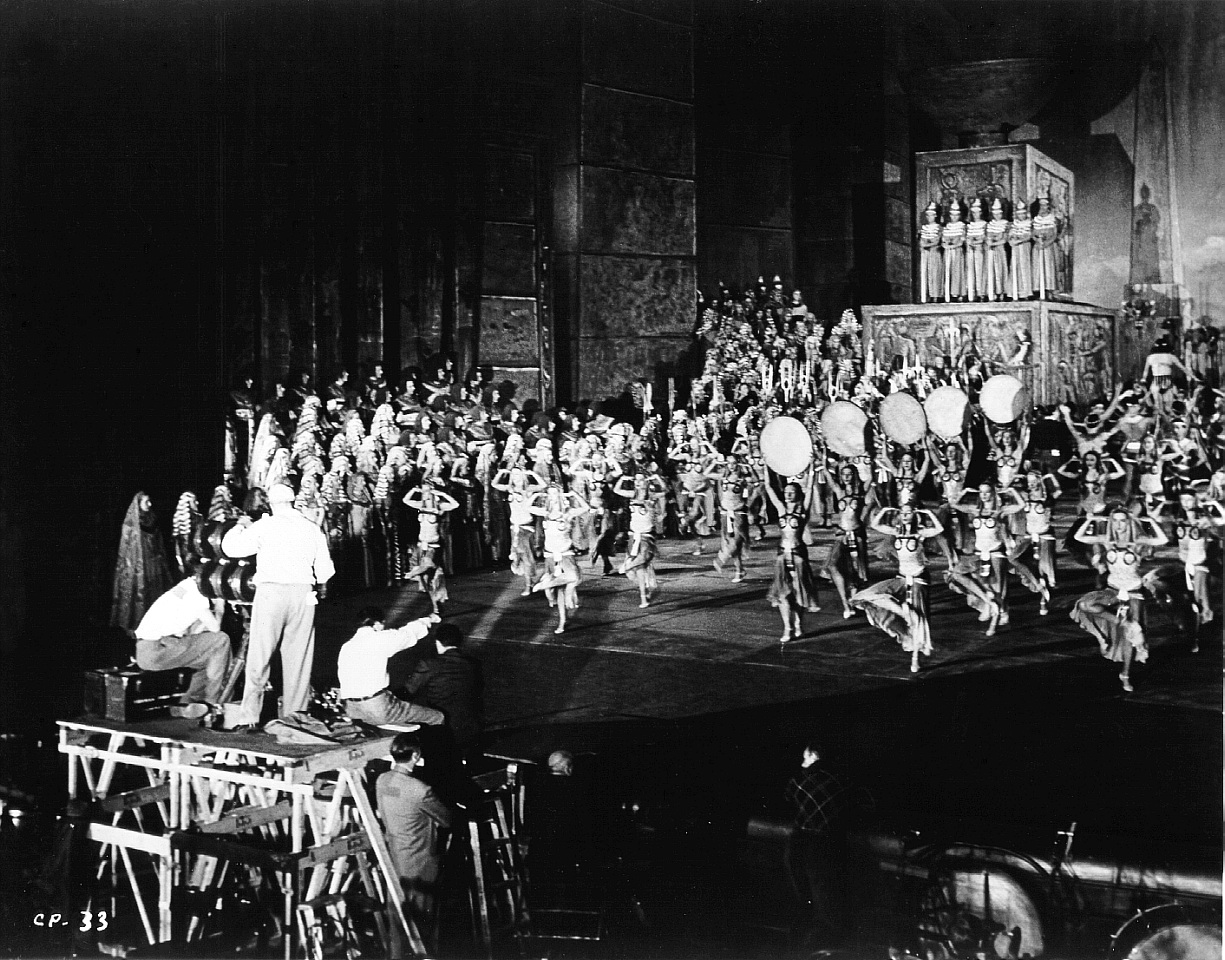 After a brief black-&-white, small-image history of movies, the picture expanded to a color roller-coaster ride. What then? The opera Aida, of course, from La Scala in Milan. According to the program given out to the Cinerama audience:
After a brief black-&-white, small-image history of movies, the picture expanded to a color roller-coaster ride. What then? The opera Aida, of course, from La Scala in Milan. According to the program given out to the Cinerama audience:
“Including the orchestra, there were more than six hundred people on the stage at one time when the Cinerama camera photographed the La Scala Opera Company’s brilliant presentation of the Finale of the Second Act of Aida. It turned out that there weren’t enough lights in Italy to illuminate the stage; additional lights had to be flown in from England on short notice and generators to supply the current were recruited from all over Italy.”
Three months later, Carmen from the Metropolitan Opera pioneered live alternative content for cinemas, transmitted to 31 movie theaters in 27 cities. The Orpheum in Los Angeles was equipped with a stereophonic sound system for the purpose.
Sixty years after that Carmen, the Metropolitan Opera is still transmitting opera live to movie theaters, now worldwide. The most-recent presentation (as this is being written) was Aida on December 15th. According to published figures, its single live transmission, even compared to three days of continuous showings of movies, finished ninth in U.S. weekend theatrical box office gross.
Happy New Year!
Comment: I just (2013 March 19) discovered that, despite its being called an opera in many references, Rosabel Morrison’s Carmen was a play based on the Mérimée story, not an opera. Sorry!
38. Opera & Media: A Very Good Year (2013 January 5)
It’s traditional in a new year to look forward and backward. With the HPA Tech Retreat coming up <http://www.hpaonline.com/2013-program>, I’m looking forward to higher frame rates, resolution, & dynamic range (contrast ratio), more-reliable wireless cameras, better surround sound, and such good voice recognition and automatic translation that we’ll be able to do live multi-language subtitling of unscripted opera interviews.
As for the past, 1938, seventy-five years ago, was a heck of a year in opera-media history. The opera Brundibár was written that year and incorporated a barrel organ, the earliest opera-playback mechanism (as I pointed out in a previous post here, barrel-organ-equipped clocks made in 1733 and 1738 played music from Handel operas).
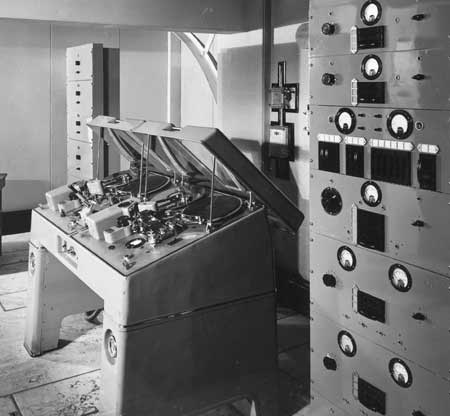 In radio, a live broadcast of The Barber of Seville from the Metropolitan Opera was “performed” by marionettes for children who were in St. Vincent’s Hospital in New York. Later that year, Carmen, recorded on the Millerfilm system in London, was edited and then broadcast on WQXR, possibly the first edited broadcast in the U.S.
In radio, a live broadcast of The Barber of Seville from the Metropolitan Opera was “performed” by marionettes for children who were in St. Vincent’s Hospital in New York. Later that year, Carmen, recorded on the Millerfilm system in London, was edited and then broadcast on WQXR, possibly the first edited broadcast in the U.S.
Speaking of film, opera-composer Erich Wolfgang Korngold won the first Academy Award given to a composer for his score for 1938’s The Adventures of Robin Hood (Korngold’s score for the 1936 “Anthony Adverse” previously won when the award went to the head of the studio’s music department). In Berlin in 1938, the Paul Nipkow Sender, a TV transmitter named for the inventor of video scanning, repeatedly carried a movie of Mozart’s opera Der Schauspieldirektor.
In live TV, in 1938, the BBC adapted for television a radio opera of Cinderella they had previously commissioned from Spike Hughes. And choreographer Antony Tudor created a TV dance version of Tristan und Isolde with off-camera singers; though the opera was trimmed to just 64 minutes, it had only 36 shots and was called “visually funereal.”
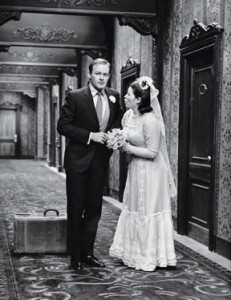 Of course, there are other anniversaries besides the 75th. In 1963, 50 years ago, NBC Opera Theater premiered Menotti’s opera Labyrinth, which used video effects and could not be performed on stage. Also that year, opera-conductor Fritz Reiner’s obituary mentioned his “invention” of the concept of the video conductor camera.
Of course, there are other anniversaries besides the 75th. In 1963, 50 years ago, NBC Opera Theater premiered Menotti’s opera Labyrinth, which used video effects and could not be performed on stage. Also that year, opera-conductor Fritz Reiner’s obituary mentioned his “invention” of the concept of the video conductor camera.
In 1913, 100 years ago, a version of Pagliacci was said to be the first complete opera sync-sound movie. Also that year, Prince Albert of Monaco’s portable “wireless piano” (a synthesizer) played music from The Merry Widow. Asked by a New York Times reporter that year, “What will be the future of the moving picture?” Thomas Edison responded, “Perfect opera.”
He wasn’t changing his tune. In 1888, 125 years ago, Edison filed his first motion-picture caveat with the U.S. Patent Office, saying the only purpose of the invention was for opera. If you prefer as your movie inventor Louis Le Prince, he was issued both UK and U.S.patents that year for what was called “animated pictures” to be used for “adaptation to Operatic Scenes.” Also in 1888, The Electrical Engineer provided the earliest description of consumer headphones, used for Lisbon’s opera-by-telephone subscription service.Edison acknowledged that year that such systems had been successful but said his “phonographic opera will cost nothing.”
In 1788, 225 years ago, perhaps the earliest theatrical gas lighting was at London’s English Opera House. In 1738, 275 years ago, besides the opera clock, the term “opera glass” was used in print for a Galilean telescope used to see close ups in the opera house. And in 1638, 375 years ago, a handbook of opera staging provided what might be the oldest existing description of a lighting dimmer.
Onward to the future!
Comments:
Miriam Lewin: Menotti’s “The Labyrinth” sounds intriguing. Is there a video record of it?
Mark Schubin: It exists (in color) at the Paley Center (formerly the Museum of Television and Radio): http://www.paleycenter.org/collection/item/?q=labyrinth&p=1&item=T81:1398
Incidentally, an opera that uses video effects so it can’t be staged raises an interesting question of what opera is. The 1937 CBS-commission radio opera Green Mansions by Louis Gruenberg was called a “non-visual opera” because it used sound effects that made it unstageable. In 1989, UK Channel Four sought to commission only unstageable operas.
39. “The Greatest Invention,” Said Tom Swift Operatically (2013 January 13)
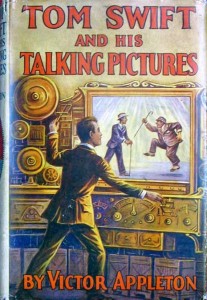 A colleague recently gave me a copy of the 1928 book Tom Swift and His Talking Pictures. Despite the title, it’s not about sound movies.
A colleague recently gave me a copy of the 1928 book Tom Swift and His Talking Pictures. Despite the title, it’s not about sound movies.
Page five describes the activities of Tom’s business manager, Ned Newton. “For several weeks now he had been helping Tom Swift on the latter’s newest idea–an invention, Tom declared, that would be the greatest on record and one that would tend to revolutionize the radio and motion picture industries.” And what was the invention? Its purpose is described on page six.
“‘I’ll make it possible,’ declared Tom Swift, ‘for a man to sit in his easy chair, smoking a cigar in his library, and, by a turn of a switch, not only to hear the latest opera but also to see each and every performer and witness the whole play.’”
The technologies involved included broadcast television, in full color, seen on a large-screen flat-panel display, with a totally secure conditional-access pay-TV system. The acquisition system included a mirrored fabric (like that used in lens ring-light color-replacement systems today). Near the end (page 207), there is a hint of even more advanced technology to come: “‘…some day, Ned,’ Tom said to his chum, after a preliminary test, ‘I’ll show these images without the use of any screen at all.’”
The plot, meanwhile, is based on the movie industry’s fear of television. Tom helps them over their phobia by giving them a half interest in the new medium (for a tidy sum).
If the above makes you want to read the book yourself, I offer two cautions: First, it’s a pretty silly story. Second, like some other literature of its time, it is full of bigoted ethnic, racial, and religious stereotypes, though the last is at least partially cancelled by the very end of the book.
By the way, 1928 is actually pretty late to predict opera on television. Television had already been broadcast by then.
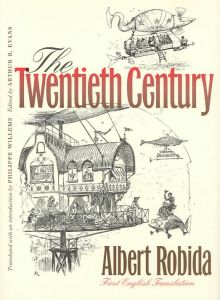 As for its carrying opera, in his 1925 book Vision By Radio, Society of Motion-Picture Engineers founder and first president Charles Francis Jenkins wrote, “The casing enclosing the mechanism is not very large, and contains, besides the radio vision mechanism, the radio receiving set, and a loudspeaker, so that an entire opera in both action and music may be received.”
As for its carrying opera, in his 1925 book Vision By Radio, Society of Motion-Picture Engineers founder and first president Charles Francis Jenkins wrote, “The casing enclosing the mechanism is not very large, and contains, besides the radio vision mechanism, the radio receiving set, and a loudspeaker, so that an entire opera in both action and music may be received.”
Thomas Edison said in 1891 that he’d show opera on television in 1893 (he didn’t), and, in 1882, based on Clement Ader’s demonstration of the stereophonic transmission of opera the previous year, Albert Robida described opera on television (he called it the “telephonoscope”) in his book The Twentieth Century. That book also features giant, flat-panel screens and such other innovations as TV-camera-wielding war correspondents and product placement in broadcast scripts. It’s a fun read, and I recommend it wholeheartedly.
40. Opera & the Media: It’ll Never Fly (2013 January 20)
I’ve written here about the many people who predicted the success of opera in various forms of media. This time, I’d like to do the opposite and write about how people said opera would NOT work that way.
Many reasons have been offered. The most recurring seems to be a fear of hurting the opera-house ticket sales. It surfaced no later than March 22, 1876, in a story in The New York Times about the telephone.
“The use of the telephone will, of course, be viewed with disapprobation by the sound-producing part of the community,” they wrote. “No man who can sit in his own study with his telephone by his side, and thus listen to a performance of an opera at the Academy, will care to go to Fourteenth street and to spend the evening in a hot and crowded building.”
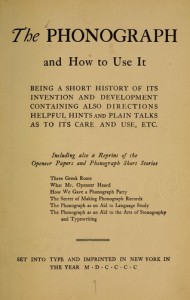 Next came sound quality. After inventing the phonograph in 1877, Thomas Edison made grand claims for its ability to “annihilate time and space,” but he was still cautious about opera.
Next came sound quality. After inventing the phonograph in 1877, Thomas Edison made grand claims for its ability to “annihilate time and space,” but he was still cautious about opera.
“The only element not absolutely assured,” he wrote in an otherwise optimistic article in 1878, “in the result of experiments thus far made–which stands in the way of a perfect reproduction at will of Adelina Patti’s voice in all its purity–is the single one of quality….” He would later comment that “The Phonograph Is Not an Opera House.” As late as 1900, readers of The Phonograph and How to Use It were instructed to “Avoid singing with too much expression.”
On May 4, 1877, the first aria was transmitted by telephone line from Providence to Boston. The Boston Herald politely reported that “the air, if not the voice, was distinctly recognized.” A different report noted that “the tenor’s voice rose and fell, the sound being faint, sometimes lost, and then again audible.”
When opera became the first stereo sound transmission, in Paris in 1881, the French press raved about the quality, while the British press ranted. Perhaps the most-reasoned opinion was that “The telephone is a harsh judge.” But was that referring to the sound quality or to the loss of visuals?
The issue was clarified in 1887. P. T. Barnum proposed carrying the Paris Opera to New York for $5 an act (about US$126 in today’s money, or more than $600 for a four-act opera). The Electrician and Electrical Engineer, a trade publication, could have commented on the seemingly ridiculous economics or the problems of transmitting sound thousands of miles in the era before amplification. Instead, though they mentioned those, they emphasized the loss of visuals:
“Furthermore, there is the interesting fact that the performances at the Paris Opera depend largely for their success on the scenery and ballet, the singers not ranking very high. Merely to hear a work in that great house is not a great musical treat, as matters stand. To hear it filtered through three thousand miles of wire, so to speak, is certainly not worth $20.”
How about the visual media? Opera was broadcast on television no later than 1934, but five years later, after many operas on TV, in an otherwise positive book called The Victory of Television, Philip Kerby wrote that “Grand Opera cannot be televised successfully.” Why not?
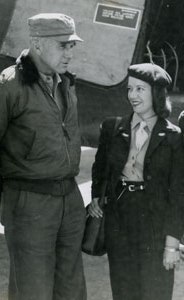 “All of [the director’s] cast must be approximately the same size and must be reasonably thin, because on the small screen an actor who weighs over 150 pounds or is more than six feet tall appears a giant and thus dominates the whole picture,” he wrote. “Lily Pons is probably the only diva whose unusual talent and physique would make her a great television star.” And that’s not all. “Pons has another attribute in her favor. She is a natural brunette.” Kerby also noted that TV viewers get bored very quickly (within three minutes) with music.
“All of [the director’s] cast must be approximately the same size and must be reasonably thin, because on the small screen an actor who weighs over 150 pounds or is more than six feet tall appears a giant and thus dominates the whole picture,” he wrote. “Lily Pons is probably the only diva whose unusual talent and physique would make her a great television star.” And that’s not all. “Pons has another attribute in her favor. She is a natural brunette.” Kerby also noted that TV viewers get bored very quickly (within three minutes) with music.
As for me, I just finished working on a live transmission of opera to cinemas around the world. Opera is now the number-one form of alternative content for cinema, earning millions of dollars in ticket sales and frequently finishing in the top-ten in U.S. weekend box-office grosses. It’s also something I thought, before my first transmission, was unlikely to succeed.
Oh, well.
41. Opera and the Invention of Broadcast Rights (2013 January 24)
Tomorrow, I’ll be working on a TV-lighting test at the Metropolitan Opera for Verdi’s Rigoletto. The live worldwide cinema transmission will be on February 16, and I think it will be great (buy your tickets now). But an earlier presentation of that opera had a significant impact on our industry.
The first opera music to be transmitted from one city to another (1877) was from Rossini’s Il barbiere di Siviglia. The first complete opera transmitted from an opera house (1878) was Donizetti’s Don Pasquale.
According to Harvard’s F. M. Scherer, in “The Emergence of Musical Copyright in Europe from 1709 to 1850,” “Rossini, Bellini, and Donizetti died or retired from [opera composing] too early to reap significant fruits” from “an effective copyright law [that] was finally in place during the early 1840s.” It wasn’t that you couldn’t make money as a composer; according to Scherer, “there was substantial free-lance composing activity even for persons born in the second half of the 17th century. The main money spinner for such individuals was the writing of operas.” But composers had to make their money up front, on commissions; performance fees were nearly impossible to collect.
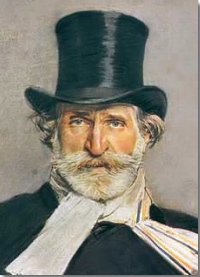 Taking advantage of the new copyright law, however, Verdi “became very rich as a consequence.” Scherer goes on:
Taking advantage of the new copyright law, however, Verdi “became very rich as a consequence.” Scherer goes on:
“Verdi’s abundant surviving correspondence makes it clear that the maestro viewed opera composition as exhausting drudgery. As his wealth accumulated, Verdi reduced his compositional effort — from 14 operas in the 1840s to seven in the 1850s, two in the 1860s, and one each in the succeeding three decades.” There’s much more about copyright in the paper; you can download it here: http://hks.harvard.edu/publications/getFile.aspx?Id=315
I’m more interested, however, in something that happened in the last of those “succeeding three decades.” To continue the early history of transmitted opera, the first transmitted in stereo (1881) was Meyerbeer’s Robert le diable; the first for which a subscription fee was paid (1885) was Boito’s Mephistofele.
After that, transmission of opera by telephone exploded, with commercial systems introduced in such countries as France, Hungary, Italy, Portugal, Spain, the UK, and even the U.S. So it was not surprising that, at an electrical exhibition in Brussels in 1899, a company would want to demonstrate opera transmission by telephone. It was by no means the first transmission of opera by telephone in that country. The Queen of Belgium had listened to Gounod’s Faust in 1884 at her chalet in Ostend, transmitted to her from Brussels.
Unfortunately, the music chosen for the 1899 demo wasn’t by any of those other composers; it was from Verdi’s Rigoletto. The composer who had gotten rich from copyright didn’t like the idea, even though the usual performance fee had been paid for the in-person venue. Verdi sued, and the judge ruled in his favor. The telephone-opera people had to pay the world’s first “broadcast” rights fee and were prohibited from transmitting Verdi’s music again without his permission.
The rest, as they say, is history.
Comment added 2013 January 26: I wrote above that Robert le diable was the first opera transmitted in stereo, and it almost certainly was the first complete one. It was what was performed the first evening that the electricity exhibition was open (August 26). But there had been demonstrations previously during the day. The first presented to those not working on the project was the huntsmen’s chorus from Weber’s Der Freischütz on the VIP-preview day (August 10).
42. Opera House Video Production (posted by Winston Tharp 2013 February)
I’ve enjoyed video productions of operas from both the Met and San Francisco Opera over the years and as a former video engineer have always been interested in the technology behind them. Watching your great presentation on the production process at the Met, I learned that you bring in a mobile rig every time you record or transmit. I know that SF Opera went for a permanent installation and has the capability to produce every production in house. I’m curious about the reasons both companies had for making different decisions. Would you care to comment on the Met side? Perhaps someone from SF Opera would chime in (Frank?).
Comments:
Mark Schubin: First, let me emphasize that my opinions are my own. I’ve been doing television at the Met since 1973 but have never, in all that time, been an employee of the Met.
That said, I think it boils down to economics. After a certain number of performances a year, equipment purchase becomes less expensive than rental, but, on the purchase side, maintenance and replacement need to be figured in, too.
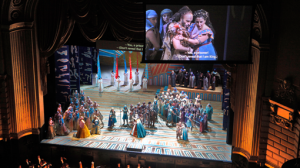 San Francisco Opera’s OperaVision (close-ups for people in distant seats) justifies equipment purchase. Similarly, the Met owns the cameras used for its surveillance coverage but doesn’t do OperaVision-type close-ups.
San Francisco Opera’s OperaVision (close-ups for people in distant seats) justifies equipment purchase. Similarly, the Met owns the cameras used for its surveillance coverage but doesn’t do OperaVision-type close-ups.
Another reason for purchase is when equipment just isn’t available for rental. The Met worked with Screen Subtitling on its live, multi-language subtitling system, so that equipment was purchased from Screen Subtitling.
On the rental side, an advantage is replacement. The Met changed from Sony HDC-1500 to HDC-2500 cameras when the latter came out by urging its vendor, All Mobile Video, to make the switch. That brought a big improvement in sensitivity though the 1500s were working fine. Had the Met owned the 1500s, they might have been reluctant to spend on new cameras when the old ones were still working; AMV had other areas where they could use the 1500s.
Both models can work.
Dyann Espinosa: It’s a never-ending situation, and usually the pendulum swings back and forth over the years (sometimes depending on the source of funding or a new director or management). IMHO, no one answer for all.
Eric Peters: Mark, if the Met were ever to go for a permanent video installation, rather than a mobile rig, where would they put it? I understand space is pretty tight there, so is it an important part of the rent/buy decision?
Mark Schubin: You’re right; space is at a premium, but it can be found as necessary. The Met Titles team was moved out of their space recently to accommodate the in-house video department (on-stage projections), and another space was recently found for the video department’s servers and warp engines (for the moving-plank “Machine”).
We’ve discussed where we’d put a TV-production facility. For one thing, the production trucks stay in place so long that we could conceivably park a facility there. We’ve also discussed building onto roof spaces (as we did for a radio satellite facility).
Another comment (2013 March 15): In giving a tour to some broadcasters from Finland at the Met today, I remembered something I should have mentioned: When the Met’s “new” house was built, it was wired for television.
Those of you who have been in the business a long time might remember multi-core camera cable. Those in the business a really long time might remember such behemoth cameras as RCA’s TK-41, which used TV-81 multi-core cable that weighed about a pound a foot and was essentially impossible to repair.
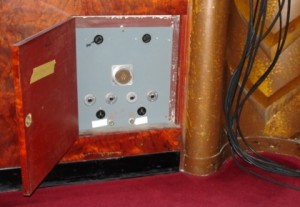 When the “new” Metropolitan Opera House opened in 1966, it was pre-wired with TV-82 multi-core cable, about the size and weight of TV-81 (I’ve yet to find any old timer who remembers the TV-82 version). Among the locations wired was the coat closet of the Top of the Met restaurant above the main lobby, the theory being (I guess) that it would be nice to start shows showing a patron checking her mink.
When the “new” Metropolitan Opera House opened in 1966, it was pre-wired with TV-82 multi-core cable, about the size and weight of TV-81 (I’ve yet to find any old timer who remembers the TV-82 version). Among the locations wired was the coat closet of the Top of the Met restaurant above the main lobby, the theory being (I guess) that it would be nice to start shows showing a patron checking her mink.
Today, that restaurant is gone, and the best recollection of the old timers at the Met is that those camera cables were never used. We have, on occasion, used associated coax in the connector panels (adding PL-259 to BNC adaptors), and we tried to use the conduits in which the cable was run for newer cables. Sometimes we were successful, but, when the wall started to move as we turned on a pulling engine, we stopped. It didn’t take too many years for “pull grease” to turn to glue.
So there are plenty of chunks of cable to remind us of the folly of buying equipment without a known use for it.
Winston Tharp: After spending the last 23 years of my career in a 1960s era plant with miles of legacy cable in the floors, walls and ceilings, I sympathize with you totally. Sometimes you wish there were something like a Roto-Rooter for electrical conduits! It also makes you understand why people just walk away from an older facility rather than try to refurb it. 🙂
I agree about the folly of purchasing equipment without a clear reason, but I don’t agree that pre-wiring a facility falls into this category. Given the long lead times for construction of a major facility, all one can do is make an educated guess about what might be required years (or decades) in the future. Who would have foreseen fiber optics in 1966?
Mark Schubin: I’m not complaining about the technology, just its lack of use. I’m aware of a number of facilities with the latest and greatest equipment just sitting there because they were installed on an “If you build it, they will come” basis.
I put pre-wiring into that category. Access is much more important. When I consult on a new facility, I suggest cable paths: grooves in boxes, removable slots in door jambs, etc. That way, whatever the cable is, and wherever the director (or lighting director or audio producer) wants it to go, and wherever the trucks have to park, there will be a path.
43. Opera and the Invention of Lip-Synching (2013 February 3)
I belong to an opera-discussion group on the Internet that doesn’t shy away from controversy. Two of their latest heated exchanges have been over Beyoncé’s possible lip-synching of the national anthem at President Obama’s second inauguration ceremony and the Met’s new production of Rigoletto set in Las Vegas in 1960. I think the two are connected.
Although there have been occasions when a singer was injured and had to sit at the side of the stage vocalizing while someone else went through the motions, lip-synching really requires media technology. The earliest applied to opera–acoustic ducts, telephone transmission, and even sound recordings–didn’t really apply to lip sync outside the opera house. For that, media that offered both visual and aural stimulation were required: sound movies and television.
In 1937, BBC Television offered a production of the opera Hansel and Gretel in which child actors lip-synched to off-camera singers, but that was by no means the first lip-synching in opera media. Ten years earlier, composer Kurt Weill wrote a film interlude into his opera Royal Palace, but, shortly before that, director Gustav Brecher shot a movie of himself mouthing the words sung by a glacier (really!) in Ernst Krenek’s opera Jonny spielt auf and even created a synchronization mechanism so the projected-on-stage movie would match the off-stage singer. Krenek reportedly hated the effect. And even that wasn’t the first lip-synching in opera.
The oldest existing sound movie was made in 1894/5. It featured Edison employee William Dickson playing music from Planquette’s opera Les cloches de Corneville on a violin as two other (male) employees danced <http://www.youtube.com/watch?v=Y6b0wpBTR1s>. The first sound movie to feature a singing human voice was probably made shortly thereafter (perhaps as early as 1896) by Auguste Baron, who shot stars of the Opéra Comique in Paris. But both Edison/Dickson and Baron made sync-sound movies, not lip-synching.
In 1898, Flotow’s opera Martha was shot on film; the following year, it was projected, and, as described in the New York Tribune on January 15, 1899, “As the pictures are shown the music is sung from behind the screen” by live singers. But that’s what we’d today call dubbing (making the sound fit the picture) not lip-synching (making the picture fit the sound).
Beginning in 1900, it was relatively easy to watch sync-sound movies of opera arias at such places as the Paris World’s Fair. And opera inspired the creation of many movie-sound systems.
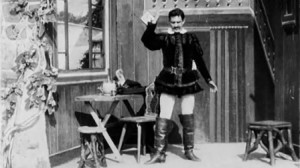 One was Alfred Duskes’s Cinophon system. He wanted to promote it, so he came up with an interesting idea.
One was Alfred Duskes’s Cinophon system. He wanted to promote it, so he came up with an interesting idea.
Enrico Caruso had recorded “La donna è mobile” from Rigoletto in 1907. Duskes hired an actor to lip-sync to Caruso’s voice and distributed the short Ach wie so trügerisch in 1908. You can watch it here: http://www.europafilmtreasures.eu/PY/323/see-the-film-la_donna_e_mobile
So Rigoletto led to the first instance of lip-synching!
44. Super-soprano and the Ceno-orchestra! (2013 February 10)
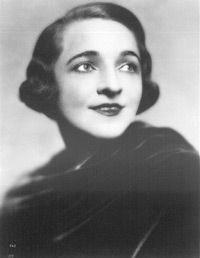 Her name was Agnes Davis. She was born in Colorado Springs in 1902 and was named the best amateur singer in the United States in the first Atwater Kent radio signing competition in 1927. Part of her prize was two years of tuition, which she used to attend the Curtis Institute of Music in Philadelphia. But before she graduated and before she was asked to sing at the Metropolitan Opera, she gave a performance of Brünnhilde in Götterdämmerung at Philadelphia’s Academy of Music opera house that was so monumental that it was covered on the front page of The New York Times on April 13, 1933. And the orchestra wasn’t slouching, either. Here’s Waldemar Kaempffert in the Times:
Her name was Agnes Davis. She was born in Colorado Springs in 1902 and was named the best amateur singer in the United States in the first Atwater Kent radio signing competition in 1927. Part of her prize was two years of tuition, which she used to attend the Curtis Institute of Music in Philadelphia. But before she graduated and before she was asked to sing at the Metropolitan Opera, she gave a performance of Brünnhilde in Götterdämmerung at Philadelphia’s Academy of Music opera house that was so monumental that it was covered on the front page of The New York Times on April 13, 1933. And the orchestra wasn’t slouching, either. Here’s Waldemar Kaempffert in the Times:
“In the building up of rushing crescendos, it seemed as if an army instead of 100 men were playing….” But “The voice of the singer always soared above the instruments.” It “seemed as if… Miss Davis were as huge as the Statue of Liberty.”
So here’s a question. Why haven’t you heard of her?
In fact, Miss Davis did go on to have a respectable career as an opera singer and teacher. But in that amazing performance she had a little help. Here’s Kaempffert, again.
“It was a hushed audience that heard the last faint tones of Götterdämmerung die away. Dr. Stokowski himself seemed to be overcome by this new magnificence of Wagner. In his effort to build huge climaxes he twisted a knob off one of his dials. The audience was none the wiser.” But that audience knew from the start that this was to be an unusual performance. For one thing, the stage was empty.
In fact, orchestra and singer were in the building, in a ballroom where there were microphones. Bell Telephone Laboratories staff, with whom Philadelphia Orchestra conductor Leopold Stokowski had been working for years before the demo, ran signals from the microphones to loudspeakers placed on the stage via amplifiers connected to a small console that Stokowski controlled. Not only was there multichannel sound, but the presented dynamic range was extraordinary.
According to Bell Labs’ Dr. Harvey Fletcher, radio listeners of the time might have heard a dynamic range (loudest to softest) of about 1,000 to 1. A live orchestral performance could do 10,000,000:1. The demonstrated apparatus could handle 1,000,000,000:1. Here’s Kaempffert, again.
“Dr. Stokowski believes that Wagner dreamed of the pianisimi and the climaxes now possible, but knew that they could never be obtained from unaided human beings.”
John Mills of Bell Labs named the “ceno-orchestra,” using the prefix of cenotaph (empty tomb). According to Kaempffert, “If some mispronounce the new term so that it sounds like ‘see-no-orchestra,” Mr. Mills is not the man to object.” After all, AT&T stood to make money on the system. Stokowski predicted it in the article.
“Now the problem is solved of what we shall do with our leisure when we have to work only a few hours a day for a living; that is, for all except the musicians, for whom there can be no rest.
“There will be music in small-town auditoriums as splendid as that which is now played by fine symphony orchestras in large cities, and people with time on their hands will flock to hear it. I can imagine spacious gardens of pleasure in which happy idlers, after a brief day’s work, wander amid the trees while they listen to the strains of great music played in some distant tower.”
“The engineers present,” according to Kaempffert, “were not so sure as Dr. Stokowski that the music would come from the tower over a beam of light. They could not get out of their minds three complicated circuits between the master orchestra and each theatre with which it must at present be connected.”
Maybe they were also wondering how to fix the twisted-off knob.
45. Opera and Medical Media Technology (2013 February 16)
I’ve already written here previously about opera and X-rays. X-rays (the images) can be considered a form of media technology because they’re a form of photography.
Opera was also involved in some other forms of medical media technology. Consider assistive technology for vision. One of the oldest compounds in the English language that includes the word opera is “opera glass,” traced back at least as far as 1738.
An opera glass is a Galilean (non-inverting) telescope. Incidentally, Galileo’s father has a claim to being one of the inventors of opera, and Galileo, himself, knew opera composer Claudio Monteverdi well enough to ask him to procure a violin for Galileo to give to a nephew as a present. But why is a Galilean telescope known as an opera glass?
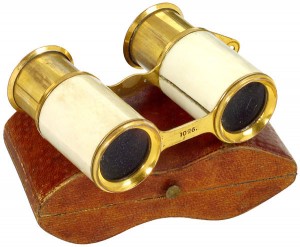 The first opera house, in 1637, was much larger than typical theaters. To see what was happening on stage, some opera-goers used those telescopes. But closing one eye was awkward. So, although there had been previous proposals and perhaps even prototypes, in 1823 Vienna optician Johann Friedrich Voigtlander combined two of those telescopes to create binocular opera glasses.
The first opera house, in 1637, was much larger than typical theaters. To see what was happening on stage, some opera-goers used those telescopes. But closing one eye was awkward. So, although there had been previous proposals and perhaps even prototypes, in 1823 Vienna optician Johann Friedrich Voigtlander combined two of those telescopes to create binocular opera glasses.
That’s vision. What about hearing? In the collection of hearing aids at the Washington University School of Medicine, you’ll find an image of the Aurolese Opera Comb (near the bottom of the page you get to with this link: http://beckerexhibits.wustl.edu/did/rarebks/spv.htm). It was something looking like a hair ornament that gathered sound and discreetly sent it to earpieces.
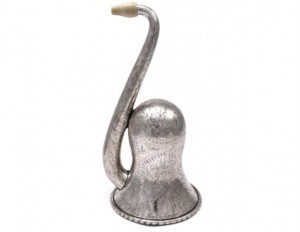 The Opera Comb was sold by the hearing-aid manufacturer F. C. Rein & Son, which also sold less-discreet (but no less ornamental) devices. Some of their most elaborate were called Opera Domes or even Grand Opera Domes. There’s a picture of one of the latter here: http://phisick.com/item/rein-silver-plated-grand-opera-dome-ear-trumpet/
The Opera Comb was sold by the hearing-aid manufacturer F. C. Rein & Son, which also sold less-discreet (but no less ornamental) devices. Some of their most elaborate were called Opera Domes or even Grand Opera Domes. There’s a picture of one of the latter here: http://phisick.com/item/rein-silver-plated-grand-opera-dome-ear-trumpet/
Those were all purely acoustic devices (so are the stethoscopes doctors and nurses typically use even today). What about electronics?
The Medical Dial had an interesting report on page 78 of its April 1903 issue. Headlined “The Deaf Shall Hear,” the story noted that “Five patients from the New York institute for the instruction of the deaf and blind attended a performance at the Metropolitan Opera House, March 30, and were enabled to hear perfectly by the aid of the ‘acousticon,’” probably the earliest electrical hearing aid. The inventor of the Acousticon, Miller Reese Hutchison, eventually separated its microphone and sound-reproducing elements, and the Met installed permanent microphones and wired 25 seats for the hearing impaired, who could bring their own earphones. The microphones were also used so the Met’s general manager could hear stage activity in his office and, by 1910, for the first live opera transmitted by radio.
That’s seeing and hearing. What about singing, speaking, and even breathing? Air, after all, is a medium.
It’s possible that as early as 1743 someone had come up with a mechanism for looking into the human larynx. But the person who invented and popularized the mirror laryngoscope was opera singer and voice teacher Manuel Garcia, whose students included “the Swedish Nightingale” Jenny Lind. According to “A Short History of Laryngoscopy” in the journal Logopedics Phoniatrics Vocology in 1996, “Garcia’s presentation to the Royal Society of Medicine in 1855 caught the attention of the medical community,” and “Garcia’s original technique of mirror examination remains part of every laryngologist’s armamentarium.”
46. Opera and the Invention of Electronic Home Entertainment (2013 March 2)
Today, you can download movies and TV shows when you want them. My former boss, Paul Klein, predicted as much about 45 years ago. He called his idea “computer television,” and it was ahead of its time, though both computers and television already existed.
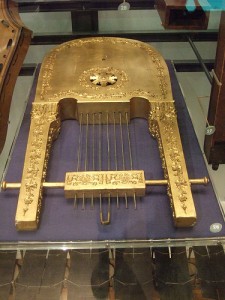 In 1821, there was no such thing as a telephone, at least not as we understand the term today, but physicist Charles Wheatstone gave what were sometimes called “telephone concerts” that year; Wheatstone, himself, preferred to use a word he coined: acoucryptophone (from roots for hearing hidden sound). He built a fake lyre out of heavy metal and suspended it from a wire that passed through a tiny hole in the ceiling to the soundboard of a musical instrument, such as a piano. Sound was mechanically conducted down the wire and emanated from the “enchanted lyre,” which Wheatstone would sometimes pretend to wind up for power. On September 1, a reporter who attended a concert wrote in Repository of Arts, “Who knows but by these means the music of the opera, performed at the King’s Theatre, may ere long be simultaneously enjoyed at Hannover Square Rooms, the City of London Tavern, and even at the Horn’s Tavern in Kennington.”
In 1821, there was no such thing as a telephone, at least not as we understand the term today, but physicist Charles Wheatstone gave what were sometimes called “telephone concerts” that year; Wheatstone, himself, preferred to use a word he coined: acoucryptophone (from roots for hearing hidden sound). He built a fake lyre out of heavy metal and suspended it from a wire that passed through a tiny hole in the ceiling to the soundboard of a musical instrument, such as a piano. Sound was mechanically conducted down the wire and emanated from the “enchanted lyre,” which Wheatstone would sometimes pretend to wind up for power. On September 1, a reporter who attended a concert wrote in Repository of Arts, “Who knows but by these means the music of the opera, performed at the King’s Theatre, may ere long be simultaneously enjoyed at Hannover Square Rooms, the City of London Tavern, and even at the Horn’s Tavern in Kennington.”
In the December 30, 1848 issue of Punch, Tom Taylor added an important element to the concept of what he called an opera telakouphanon: money. It would be “extended to the dwellings of all such as may be willing to pay for the accommodation. In this way our domestic establishments might be served with the liquid notes of Jenny Lind as easily as they are with soft water…. Then, at a soirée or evening party, if a desire were expressed for a little music, we should only have to turn on the Sonnambula or the Puritani, as the case might be.”
As I reported here previously, even before Bell’s telephone announcement, The New York Times predicted on March 22, 1876 that telephonic opera transmission could reduce opera-house attendance. One of Bell’s earliest telephone transmitters that year had multiple funnels so three people could sing into it at once.
On May 5, 1877, the Boston Herald reported on Signor Ferranti’s singing “largo al factotum” in Providence the day before and being heard live in Boston. In June 1878, the complete opera Don Pasquale was carried by telephone lines from the auditorium of the Teatro Sociale in Bellinzona, Switzerland to another hall. The stage was set.
The November 4, 1882 issue of London’s The Era called a recent telephonic transmission from a theater in Brighton “the first time this sort of thing has been attempted in the provinces,” provoking quite a few letters to the editor disputing that contention. Two are of particular interest.
J. J. Mann, an electrical engineer at Scotland’s National Telephone Company, noted that, by means of a telephone transmitter installed at the Theatre Royal in Dundee a month before, “On the occasion of the visit by Mr. D’Oyly Carte’s Opera Company, the music and singing were distinctly heard and enjoyed by several gentlemen in Forfar,” 20 miles away. And William Hearden noted that “through the kindness of J. R. Newcombe, Esq., the lessee of the Theatre Royal, Plymouth, I have had [a telephone connection] laid on for the last two years from the theatre to my house, a different part of the town.”
That letter was written on November 7, so, if his “two years” were a precise measurement, he began to get electronic home entertainment on November 7, 1880. On November 18, 1880, Edward P. Fry wrote a letter to Colonel J. H. Mapleson in New York. “I thank you for your courtesy in permitting the erection of a telephone in the Academy of Music, by which the experiment could be made of transmitting the sound of operatic performances to me in my sick room; and to let you know the entirely successful, wonderful, astounding result.”
One of those two appears to have been the first to experience electronic home entertainment; at this point, I cannot say with certainty which, although I have a strong suspicion. I know little of Hearden. Based on the census of 1901, he was 31 in 1880. He was rich enough to have two telephone lines to the Theatre Royal and another to a church. That letter to the editor of The Era is the only connection I can find between him and opera (and the opera was The Pirates of Penzance).
Fry is different. His brother William is sometimes said to have written the first American opera, and his brother Joseph the first English translation of Bellini’s opera Norma. Fry, himself, was an opera impresario in both Philadelphia and New York. His letter to Mapleson was reprinted in its entirety in newspapers around the world, possibly inspiring Hearden, if the latter’s “two years” is approximate (many other news stories also covered Fry’s home opera listening).
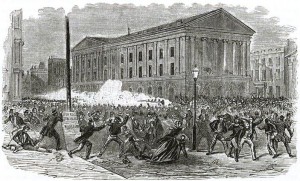 According to his obituary in The New York Times, Fry rescued actor William Macready from the deadly Shakespeare riots of 1849 and was “the first person to connect his dwelling by telephone with the stage of the Academy of Music in Fourteenth-street,” which he probably did because he had become an invalid and could no longer attend in person. There were many details published of his listening habits, such as surrounding himself with photos of the singers, patting them when they did well, and turning them upside down when they didn’t. He also read a libretto during the opera.
According to his obituary in The New York Times, Fry rescued actor William Macready from the deadly Shakespeare riots of 1849 and was “the first person to connect his dwelling by telephone with the stage of the Academy of Music in Fourteenth-street,” which he probably did because he had become an invalid and could no longer attend in person. There were many details published of his listening habits, such as surrounding himself with photos of the singers, patting them when they did well, and turning them upside down when they didn’t. He also read a libretto during the opera.
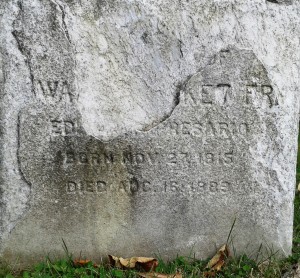 That begs a question: How did he listen? There were no loudspeakers at the time. Are we to imagine an invalid holding a telephone receiver to his ear throughout a long opera while reading a libretto and manipulating photographs? It seems unlikely. My spouse suggests that he would have rigged up a hands-free headset of some sort, in which case Fry created not only the first electronic home entertainment but also the first headphone.
That begs a question: How did he listen? There were no loudspeakers at the time. Are we to imagine an invalid holding a telephone receiver to his ear throughout a long opera while reading a libretto and manipulating photographs? It seems unlikely. My spouse suggests that he would have rigged up a hands-free headset of some sort, in which case Fry created not only the first electronic home entertainment but also the first headphone.
Incidentally, even if Fry didn’t invent the headphone, the best research that The New York Times (after my goading them into action), some top librarians, and I could come up with still indicates that the consumer version was invented by home opera listeners no later than 1888. Here’s a headphone history I wrote a little over two years ago: https://staging.sportsvideo.org/blogs/?blog=schubin-cafe&news=headphones-history-hysteria
Comment: I just (2013 November 12) learned that The Era got the name of the letter writer wrong. It was William Sleep Hearder, not Hearden (the 1901 UK census made the same error). Just as Fry was an editor, publisher, playwright, impresario, and rescuer, Hearder was a medical student, electrical engineer, seller of fishing tackle, curator of fish, reptiles, and amphibia, and lecturer on such topics as wireless telegraphy.
But I still don’t know who came first!
47. Opera and U.S. Commercial Television (2012 March 9)
Martin’s Lie, then a brand new opera, opened the 17th Bath Festival in England in 1964 with a performance in Bristol Cathedral on June 3. It was reportedly carried live by the BBC. Six years earlier, Maria Golovin, another brand new opera, was performed in a large theater at the 1958 Brussels World’s Fair on August 20; writing in The New York Times, critic Howard Taubman called it “the only new work of major proportions introduced at the Fair.” Both operas were written by Gian Carlo Menotti, but they had something else in common; both had been commissioned by and were later broadcast on U.S. commercial television networks, CBS for Martin’s Lie and NBC for Maria Golovin. Really!
Mad magazine has often spoofed current events in song. One song a half-century ago, to the tune of “Summertime” (from the opera Porgy and Bess), complained about TV reruns. It ended with these lines: “Oh, the FCC says that TV’s a wasteland. In summer those reruns compound the crime.”
The reference is to a speech given by President Kennedy’s Federal Communications Commission chair, Newton Minnow, to the National Association of Broadcasters on May 9, 1961. There were 5,416 words in the speech, but just three of them, starting with word 1,410, have been repeated often ever since. Minnow characterized TV as “a vast wasteland.”
Few, however, ever mention some words Minnow used a bit earlier in his speech. After listing both older and then-current programs, he said, “I could list many more — programs that I am sure everyone here felt enriched his own life and that of his family. When television is good, nothing — not the theater, not the magazines or newspapers — nothing is better.” And he said that years before PBS was created.
Minnow didn’t mention any television opera, but he could have. NBC carried its first television opera programming in 1939, with scenes from Carmen performed by the Miniature Opera Company, which Barry Singer, writing in Opera News, described as “a twelve-year-old soprano and a nine-year-old coloratura.” By 1940, the network shifted to hour-long live opera programming by the Metropolitan Opera, fully staged but in a studio. NBC’s vice president in charge of television wrote a personal letter to U.S. President Franklin Roosevelt to get him to tune in.
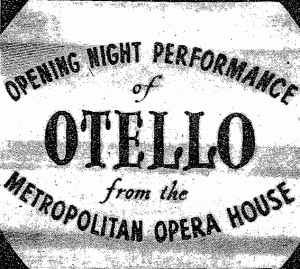 It took a little longer before the Metropolitan Opera was brought to television from its own house. ABC broadcast the Met’s opening-night Otello on November 29, 1948. To avoid interfering with the audience, the cameras were kept on the periphery, and, to deal with the stage’s low light levels, ABC added infra-red lighting, visible to the cameras but not to the audience. Seven cameras (a huge quantity at the time) were supposed to be used, but one, Taubman reported in a front-page story in the Times, “it was learned later, had been out of order,” though a technician tried to restore it.
It took a little longer before the Metropolitan Opera was brought to television from its own house. ABC broadcast the Met’s opening-night Otello on November 29, 1948. To avoid interfering with the audience, the cameras were kept on the periphery, and, to deal with the stage’s low light levels, ABC added infra-red lighting, visible to the cameras but not to the audience. Seven cameras (a huge quantity at the time) were supposed to be used, but one, Taubman reported in a front-page story in the Times, “it was learned later, had been out of order,” though a technician tried to restore it.
Whatever the difficulties of shooting under performance conditions in the opera house, sometimes there seemed even greater ones in live studio productions, where the orchestra often performed in one room and the singers another, and the action had to be confined to an area considerably smaller than a typical stage. Nevertheless, both forms continued. The DuMont Television Network adapted H.M.S. Pinafore to live studio conditions in 1944, NBC televised Pagliacci from a studio in 1946, and Martin Mayer, author of the book Television, recalled watching several Met opening nights live on ABC on a TV in a bar, starting in 1948, the same year that CBS created a TV-studio version of Menotti’s The Medium (and, according to one source, so did NBC a month earlier).
CBS began Opera Television Theater in 1949 (with “Carmen” sung in French), the same year that NBC Opera Theater began a 15-year run. We think of television as a cautious medium today, but NBC Opera Theater presented Salome and the American premiere of Billy Budd and featured soprano Leontyne Price in the title role of Tosca. It wasn’t just a television series; it was an opera company, with its own performers. It sometimes toured, and, like some other opera companies, it commissioned operas.
 Menotti’s Amahl and the Night Visitors was the first opera commissioned for television (the BBC had earlier commissioned Cinderella from Patrick “Spike” Hughes and televised it in 1938, but it was originally intended and broadcast as a radio opera). In 1963, Menotti’s Labyrinth on NBC Opera Theater made extensive use of video effects and was therefore called the first “unstageable” opera. Labyrinth is sometimes called Menotti’s second TV opera because Maria Golovin opened on a stage in Brussels, but it had been commissioned by NBC as an opera for television, and the company performing it at the 1958 World’s Fair was NBC Opera Theater.
Menotti’s Amahl and the Night Visitors was the first opera commissioned for television (the BBC had earlier commissioned Cinderella from Patrick “Spike” Hughes and televised it in 1938, but it was originally intended and broadcast as a radio opera). In 1963, Menotti’s Labyrinth on NBC Opera Theater made extensive use of video effects and was therefore called the first “unstageable” opera. Labyrinth is sometimes called Menotti’s second TV opera because Maria Golovin opened on a stage in Brussels, but it had been commissioned by NBC as an opera for television, and the company performing it at the 1958 World’s Fair was NBC Opera Theater.
Please don’t get the impression that only Menotti was commissioned to write operas for television. ABC (which ran a series called Opera vs. Jazz starting in 1953, the same year DuMont’s Opera Cameos began) commissioned TV operas from such composers as David Amram, Mark Bucci, and Mary Johnson; CBS from Bernard Herrmann, Ezra Laderman, Benjamin Lees, Thomas Pasatieri, John Strauss, Igor Stravinsky, and Alec Wilder; NBC from Norman Dello Joio, Lukas Foss, Stanley Hollingsworth, Leonard Kastle, Bohuslav Martinů, and Russell Woollen. Sponsor Armstrong Flooring commissioned an opera by Darrell Peter broadcast on NBC on Armstrong Circle Theatre. Commissioned opera on commercial TV was fairly common in the U.S. well before the BBC did its first in 1956.
It also wasn’t just networks. When Louisville NBC affiliate WAVE-TV built a new studio in 1959, they commissioned an opera, Beatrice by Lee Hoiby, to inaugurate it. And Baltimore NBC affiliate WBAL-TV broadcast A Room in Time by Charles Kent from its studio in 1966.
NBC Opera Theater was off the air by that time, but commissions by U.S. commercial networks were not. CBS aired Medea in Corinth, commissioned from Lees, in 1974.
Did commercial-TV opera affect media technology? ABC’s infra-red lighting of the Met stage led to increased camera sensitivity, with hyper-sensitive cameras used to shoot New York City Opera’s Le coq d’or, fed live to cable TV in 1971. And conductor-monitor systems first used in NBC’s Amahl are now found in opera houses worldwide.
The creative team at NBC Opera Theater moved to National Educational Television’s NET Opera Theater, which also commissioned operas for a few years. And the “unstageable” commissioned-for-TV Labyrinth might have inspired a grants program initiated in 1989 by UK commercial broadcaster Channel 4 to fund the creation of unstageable television operas.
Comments:
Alexander Magoun: Mark, as always a fascinating article that raises one question: was FDR expected to tune in for a radio simulcast in 1940? My specifics are rusty but you might want to clarify Washington, DC’s television status at the time.
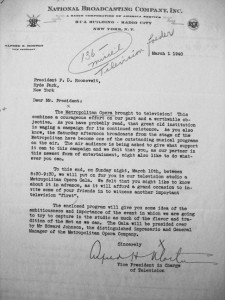 Mark Schubin: Thanks! One problem with this LinkedIn group is that I can’t post attachments. I actually have a copy of the letter. It was sent from Alfred Morton to FDR at Hyde Park, New York, where NBC had installed television receiving equipment capable of picking up signals from New York City. The President was definitely expected to tune in; from the tone of the March 1 letter it might seem as though he was the only one expected to tune in:
Mark Schubin: Thanks! One problem with this LinkedIn group is that I can’t post attachments. I actually have a copy of the letter. It was sent from Alfred Morton to FDR at Hyde Park, New York, where NBC had installed television receiving equipment capable of picking up signals from New York City. The President was definitely expected to tune in; from the tone of the March 1 letter it might seem as though he was the only one expected to tune in:
“To this end, on Sunday night, March 10, between 8:30-9:30, we will put on for you in our television studio a Metropolitan Opera Gala. We felt that you might like to know about it in advance, as it will afford a grand occasion for you to invite some of your friends in to witness another important television ‘first’.”
Included with the letter was the show’s printed program, listing the pieces and the performers. The top says “RCA-NBC Television;” the bottom says “under the personal direction of Edward Johnson, General Manager, Metropolitan Opera Company.”
The letter, the program, and more may be found at the FDR Presidential Library in Hyde Park. I’m happy to send photos I shot of them there on request.
Alexander Magoun: Aha, the Hyde Park White House (as it were)! Hyde Park is about 50 miles due north of the Empire State Building and I imagine they constructed a fairly tall antenna to pick up the signal on Channel 1 (44-50 MHz), which apparently had a range of 40 miles. I wonder what the FDR papers might have on that project.
Mark Schubin: There’s quite a bit about “the television man.”
48. The First Opera Cinemacast (2013 March 21)
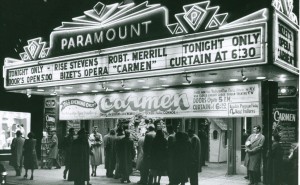 Opera-star Risë Stevens died yesterday at age 99. A little over 60 years ago, she played the title role in the first opera cinemacast, Carmen, transmitted live from the Metropolitan Opera House to 31 cinemas in 27 U.S. cities. It differed from the modern transmissions in a number of ways: it was black-&-white, low-definition video with low-fidelity, mono sound. It used only four cameras, and they were in fixed positions.
Opera-star Risë Stevens died yesterday at age 99. A little over 60 years ago, she played the title role in the first opera cinemacast, Carmen, transmitted live from the Metropolitan Opera House to 31 cinemas in 27 U.S. cities. It differed from the modern transmissions in a number of ways: it was black-&-white, low-definition video with low-fidelity, mono sound. It used only four cameras, and they were in fixed positions.
It was transmitted via AT&T’s coaxial-cable distribution system, meaning some TV stations had to agree to forego their network programming so the opera could go through. It was also a one-shot offering (though an opening night was also cinemacast in 1954) of Nathan Halpern’s Theatre Network Television, not the Met itself.
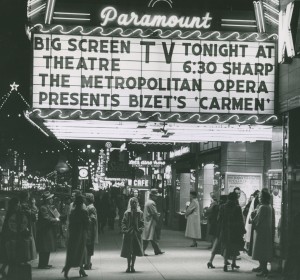 Some of the movie palaces where it was shown were larger than the opera house, and they were accustomed to being filled with moviegoers. There were some empty seats, possibly as a result of ticket prices that exceeded $60 in today’s money. There were also some problems, including one at a switching center that briefly sent the wrong program to the screen.
Some of the movie palaces where it was shown were larger than the opera house, and they were accustomed to being filled with moviegoers. There were some empty seats, possibly as a result of ticket prices that exceeded $60 in today’s money. There were also some problems, including one at a switching center that briefly sent the wrong program to the screen.
I’ve read through the comment cards filled out by viewers, however, and they were almost uniformly positive, even at those sites where there were technical difficulties. I think that, in addition to great performances and a novelty factor, those positive comments might be rooted in two psychological principles.
One is sometimes called mob mentality. One psychological experiment involved a person being asked to perform a task in a room into which smoke began to seep from under a door. When one person was performing the task, invariably he or she would alert someone to the presence of the smoke. But when three people performed the task in the same room, no one raised an alert. The theory seems to be that, if it doesn’t bother the others, why should it bother me? Perhaps the same mentality was at work at the cinema receiving the wrong signal.
The other principle is the theory of cognitive dissonance, the battling in the mind of conflicting ideas. In this case, one idea might be that the cinemacast isn’t very good, and the other that paying $60 for and spending hours at an event that isn’t very good makes one seem stupid. One doesn’t want to seem stupid, so maybe the cinemacast is actually better than initially thought.
The idea of transmitting opera productions live to theaters worldwide appeared in print in The Sun in New York in 1877. Risë Stevens helped show it was possible in 1952. And today opera is the number-one “alternative content for cinema” worldwide.
49. Movies at the Opera instead of Opera at the Movie theater? (posted by Pete Ludé 2013 March 22)
Mark’s been keeping us posted about how Opera has been transmitted to Movie Theaters for remote viewing. This appears to be an example of the opposite. (Although, it’s not clear how much Opera really is presented at this Opera House…): [linked article from Penobscot Bay Press “Digital Cinema Goes Live at Stonington Opera House” http://penobscotbaypress.com/news/2013/mar/21/digital-cinema-goes-live-at-stonington-opera-house/
Comments:
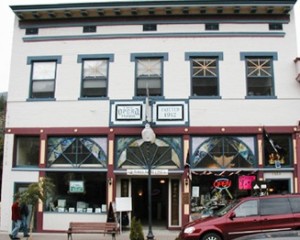 Mark Schubin: True! For about half a century after the U.S. Civil War buildings called “opera house” were constructed throughout the country with no intended connection to the art form. As William Faricy Condee’s book Coal and Culture: Opera Houses in Appalachia (Ohio University Press, 2005) puts it, “They housed little, if any, opera, but were used for almost everything else, including traveling theater, concerts, religious events, lectures, boxing matches, union meetings, and — if the auditorium had a flat floor — skating and basketball.” Many Americans were introduced to motion pictures at these “opera houses” via a bullfight movie used in the last act of a touring production of Carmen (a play, not the opera) in 1896-7. And those “opera houses” typically lacked the three key features of the first opera house in 1637: boxes, a larger-than-normal auditorium, and a location for the orchestra musicians in front of the stage.
Mark Schubin: True! For about half a century after the U.S. Civil War buildings called “opera house” were constructed throughout the country with no intended connection to the art form. As William Faricy Condee’s book Coal and Culture: Opera Houses in Appalachia (Ohio University Press, 2005) puts it, “They housed little, if any, opera, but were used for almost everything else, including traveling theater, concerts, religious events, lectures, boxing matches, union meetings, and — if the auditorium had a flat floor — skating and basketball.” Many Americans were introduced to motion pictures at these “opera houses” via a bullfight movie used in the last act of a touring production of Carmen (a play, not the opera) in 1896-7. And those “opera houses” typically lacked the three key features of the first opera house in 1637: boxes, a larger-than-normal auditorium, and a location for the orchestra musicians in front of the stage.
So, why call them “opera house”? Condee says the term was “intentionally misleading,” starting with an attempt to get around an 18th-century Philadelphia law banning theatrical performances. “The word ‘theater’ was associated with immorality, licentious behavior, lewd entertainment, and a simple waste of time. Thus, while a ‘theater’ building was often banned, an ‘opera house’ might be permitted. Other coded names included ‘academy of music,’ ‘museum,’ and ‘histrionic academy,’ each lending respectability to the building by virtue of its cultural acceptability.”
Still, I think the idea of showing opera movies (or opera-related movies) in real opera houses is a good one. Many opera houses have dark days or off-seasons when the auditorium might be used that way, and many have already installed digital projectors for scenic effects. I think it’s also a good way to keep opera audiences interested in opera during the off-season. To that end, Santa Fe Opera, which has a summer season, arranged for a local arts center/cinema to carry The Metropolitan Opera: Live in HD, which is transmitted outside of their season.
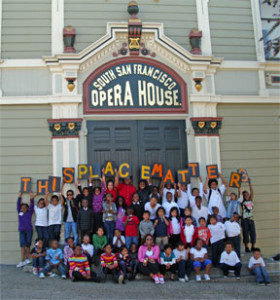 Pete Ludé: Good background, Mark. And this directly relates to the *oldest theater* in my hometown of San Francisco — the little-known Bayview Opera House. It opened in 1888 and is located in Bayview/Hunters Point – one of the most ethnically diverse neighborhoods in the city — far from the current Civic Center where the current Opera House and Symphony hall are located. Bayview Opera House is currently used as a performance space and community center. Frankly, I hope it remains that way, and is not fitted with a DCinema projector! http://www.bvoh.org/
Pete Ludé: Good background, Mark. And this directly relates to the *oldest theater* in my hometown of San Francisco — the little-known Bayview Opera House. It opened in 1888 and is located in Bayview/Hunters Point – one of the most ethnically diverse neighborhoods in the city — far from the current Civic Center where the current Opera House and Symphony hall are located. Bayview Opera House is currently used as a performance space and community center. Frankly, I hope it remains that way, and is not fitted with a DCinema projector! http://www.bvoh.org/
50. Opera and the Plazacast (2013 March 23)
In the “No opera, no X-rays!” post [29.], I noted that Boston’s first Grand Opera House sometimes offered burlesque performances. Turnabout is fair play, so I should mention that this past Tuesday I went to an opera performance in a burlesque house.
Last week, I went to an opera performance in a nightclub. I’ve also attended opera in a high school gymnasium, a kindergarten, a 19th-century stable about 8500 feet above sea level, the courtyard of a 15th century castle on an island in Finland, and on the lawn of an 11th-century castle in England. But, usually, when I see opera, it’s in an opera house.
I can’t tell you when the first opera was performed, but I haven’t found any dispute about the first opera house. It was created by the Tron family in Venice in 1637. Before that, opera was an entertainment offered by the rich at parties, but the first opera house needed to be a successful business, and two of its innovations were intended to ensure its success: boxes (which could be sold or rented to the rich as places to see and be seen) and a larger-than-usual auditorium (so more tickets could be sold per performance). A third innovation was putting the musicians in front of the stage.
The large auditorium made the acoustics challenging. In his book Buildings for Music (Cambridge University Press, 1985), Michael Forsyth noted that early opera houses sometimes used acoustic piping or troughs to help deliver sound to distant listeners.
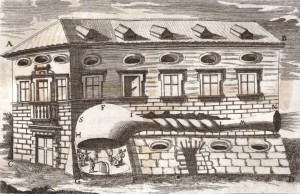 A more recent book (it came out in November) is A Man of Misconceptions by John Glassie (Riverhead Books, 2012). It’s about another prolific author, Athanasius Kircher, a Jesuit priest who wrote, not counting updates, 35 books.
A more recent book (it came out in November) is A Man of Misconceptions by John Glassie (Riverhead Books, 2012). It’s about another prolific author, Athanasius Kircher, a Jesuit priest who wrote, not counting updates, 35 books.
In his book Phonurgia Nova (1673), Kircher illustrated a way of using an acoustic duct system to convey the sounds of musicians and singers outside the opera house. That might be considered the first proposal for a “plazacast,” an extension of the live performance to the plaza outside the opera house.
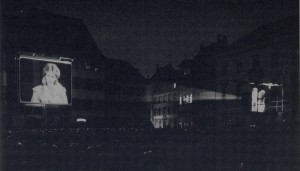 Pictures came considerably later. For a performance of Lucia di Lammermoor in Basel in 1986, an Eidophor projector (an amazing device involving hot oil, vacuum pumps, electron beams, and Schlieren optics) brought live color images to a crowd outside.
Pictures came considerably later. For a performance of Lucia di Lammermoor in Basel in 1986, an Eidophor projector (an amazing device involving hot oil, vacuum pumps, electron beams, and Schlieren optics) brought live color images to a crowd outside. 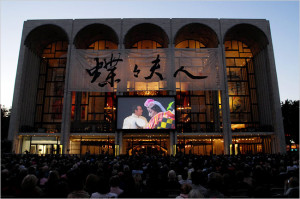 Twenty years later, the Metropolitan Opera sent its opening-night in high definition to a 32-foot-wide screen seen by thousands on the Lincoln Center plaza. That event started early on a September evening, so four 25,000-lumen projectors were converged on the same screen to provide sufficient intensity for the pictures to be seen in daylight. And there was more.
Twenty years later, the Metropolitan Opera sent its opening-night in high definition to a 32-foot-wide screen seen by thousands on the Lincoln Center plaza. That event started early on a September evening, so four 25,000-lumen projectors were converged on the same screen to provide sufficient intensity for the pictures to be seen in daylight. And there was more.
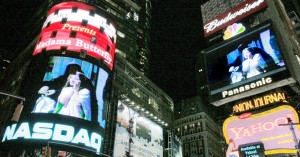 The same HD pictures were also transmitted to Times Square, where they appeared on a number of giant LED screens, including the NASDAQ one wrapped around a cylindrical building (besides the ones showing the opera, other screens carried opera-promotional messages). Broadway was filled with seats for opera watchers. Each opening night since then has been trans
The same HD pictures were also transmitted to Times Square, where they appeared on a number of giant LED screens, including the NASDAQ one wrapped around a cylindrical building (besides the ones showing the opera, other screens carried opera-promotional messages). Broadway was filled with seats for opera watchers. Each opening night since then has been trans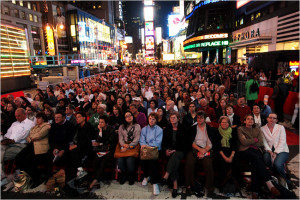 mitted to Times Square, where as many as 15 different screens have been fed in almost as many different ways (including coax, twinax, fiber, microwave, and satellite) via multiple different delays to bring them into synchronization (and where viewers have sometimes sat through drenching rainstorms to see the opera). Then there’s the issue of audio lip sync (dealt with in part by restricting audio to just two seating areas). And Times-Square viewers have also been interviewed on camera, the interviews sent back to the Met to be integrated into the live TV show.
mitted to Times Square, where as many as 15 different screens have been fed in almost as many different ways (including coax, twinax, fiber, microwave, and satellite) via multiple different delays to bring them into synchronization (and where viewers have sometimes sat through drenching rainstorms to see the opera). Then there’s the issue of audio lip sync (dealt with in part by restricting audio to just two seating areas). And Times-Square viewers have also been interviewed on camera, the interviews sent back to the Met to be integrated into the live TV show.
Wheee!
51. Opera and the Advent of Color Television (2013 April 6)
Much of my work these days is related to delivering live color moving pictures to theatrical screens. The first time live color moving pictures were delivered to a theatrical screen with an audience was in 1938 on February 4 at the Dominion Theatre on Tottenham Court Road in London, when thousands of people had their first experience of a live color cinemacast on a 9-foot by 12-foot screen.
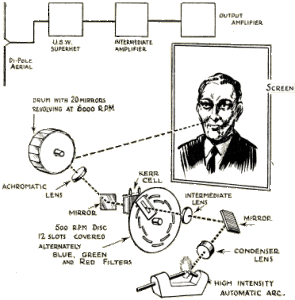 The person behind the transmission was John Logie Baird. Of all the myriad television inventors (and there certainly were many), he is my favorite, and not just because he loved opera and was the first to achieve theatrical color television. He was quite a character. Early in his work on television, for example, he procured a freshly extracted human eyeball from an ophthalmic hospital in an attempt to extract something that would improve his camera’s sensitivity.
The person behind the transmission was John Logie Baird. Of all the myriad television inventors (and there certainly were many), he is my favorite, and not just because he loved opera and was the first to achieve theatrical color television. He was quite a character. Early in his work on television, for example, he procured a freshly extracted human eyeball from an ophthalmic hospital in an attempt to extract something that would improve his camera’s sensitivity.
The 1938 demo was not Baird’s first of either theatrical or color television. In fact, the Dominion Theatre had already been equipped for live theatrical television for years before the color transmission. Baird’s first theatrical television demo (black & white) was at the London Coliseum in 1930, currently home to the English National Opera. As for color, Baird first demonstrated that (on a small screen) in 1928 (on July 3). When it was shown at a large exhibition the following month, the main person televised in color was singer Peggy O’Neil. By the way, just before the end of 1928, Baird televised a play (in black & white) called Box and Cox. It’s highly unlikely, but, if the name was somehow misreported, then the one-act comic opera Cox and Box would have been the first opera on television.
In an article, “Die Zukunft der Oper im Rundfunk” (“The Future of Opera on Radio”) in the June 1929 issue of Musikblätter des Anbruch (Music Sheets of Dawn), Frank Warschauer saw no problem in delivering opera in color to homes, noting Baird’s 1928 demos. Of course, Thomas Edison had also told the press in 1891 that he’d be demonstrating apparatus for transmitting opera in color to homes by the 1893 World’s Fair (he didn’t achieve it).
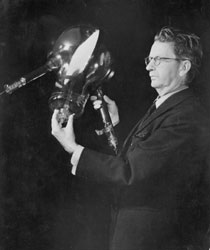 The operas that I help send to theatrical screens in color are high definition, with roughly a thousand scanning lines of resolution. Baird demonstrated 600-line color in 1940 and by 1944 was using the thousand-line figure as a goal. But in the 1940s broadcast television was black & white.
The operas that I help send to theatrical screens in color are high definition, with roughly a thousand scanning lines of resolution. Baird demonstrated 600-line color in 1940 and by 1944 was using the thousand-line figure as a goal. But in the 1940s broadcast television was black & white.
Not counting experiments, the first regularly scheduled color television broadcasts began in the United States in 1951 on June 25. Unfortunately, they were for the CBS-developed spinning-filter color system incompatible with the 10.5-million black-&-white sets already in U.S. homes, and the first (and only) CBS-color TV sets wouldn’t be manufactured for almost another three months. So no ordinary home viewer got to see the June 25 premiere broadcast, featuring New York City Ballet (which, for most of its life, shared two theaters with New York City Opera).
Less than a month after CBS-color TVs began to be produced, the U.S. Defense Production Administration asked CBS to stop making color sets so as “to conserve materials for defense,” something generally viewed as a way to let CBS off the hook of broadcasting incompatible color to an estimated 100 home receivers. CBS ceased its incompatible color transmissions after October 20. According to The New York Times that day, “The cancellation of the color broadcasts will upset a $250,000 schedule of Saturday afternoon programs that were to have been produced by leading Broadway figures and the Metropolitan Opera Company beginning Nov. 11.” You can find more at Ed Reitan’s excellent color-TV history site: http://www.novia.net/~ereitan/
CBS’s incompatible color was replaced by the second National Television System Committee’s (NTSC) industry-wide color system compatible with black-&-white TVs. It was sent to the Federal Communications Commission (FCC) for approval in 1953 on July 22 and was approved. So what was the first NTSC-color broadcast?
It’s not a simple question to answer. The FCC approved the NTSC color system on December 17 of that year, with color broadcasting authorized 30 days later, so special permission had to be obtained by NBC to broadcast the Tournament of Roses Parade in color on New Year’s Day of 1954, the “first” color broadcast. But, on December 17, the day the standard was approved, NBC broadcast its chimes logo in NTSC color at 5:31:17 pm Eastern Standard Time, and CBS broadcast an NTSC-color program at 6:15 followed by NBC at 6:30. Were those the first NTSC-color broadcasts?
No. NBC had obtained special permission to broadcast an episode of the Colgate Comedy Hour in NTSC color on November 22. Even before that, on November 3, NBC had sent a show from the Colonial Theater all the way across the country, but it was seen only by advertising executives in the network’s Burbank studios.
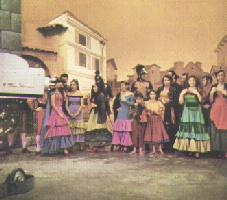 What was the first NTSC-color program actually seen at home via broadcast TV? According to TV-critic Jack Gould in The New York Times, it was the opera Carmen, by NBC Opera Theater, from the same Colonial Theater, on October 31, and the home was his own. But on August 30 there had been another operatic NTSC-color transmission from that same theater.
What was the first NTSC-color program actually seen at home via broadcast TV? According to TV-critic Jack Gould in The New York Times, it was the opera Carmen, by NBC Opera Theater, from the same Colonial Theater, on October 31, and the home was his own. But on August 30 there had been another operatic NTSC-color transmission from that same theater.
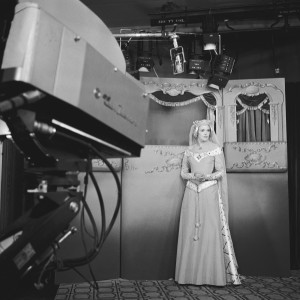 It is described as “the first publicly announced experimental broadcast in compatible color TV of a network program.” NBC brought Kukla, Fran, and Ollie (two puppets and a woman) to New York from their Chicago home studio to perform Jack Fascinato’s television operetta St. George and the Dragon, originally broadcast on June 7 (in black & white) with the Boston Pops Orchestra.
It is described as “the first publicly announced experimental broadcast in compatible color TV of a network program.” NBC brought Kukla, Fran, and Ollie (two puppets and a woman) to New York from their Chicago home studio to perform Jack Fascinato’s television operetta St. George and the Dragon, originally broadcast on June 7 (in black & white) with the Boston Pops Orchestra.
As for the Colonial Theater, after opening in 1905 as a “legitimate” theater, becoming a movie theater, and serving as NBC’s first color studio (where Meet the Press was first telecast in color), it housed game shows for both NBC and ABC and The Dick Cavett Show, then became a theater again, and was finally torn down. The space is currently occupied by the Lincoln Center for the Performing Arts David Rubenstein Atrium, where one might catch an occasional free performance of an opera singer or buy discounted day-of-show tickets to the Metropolitan Opera.
Comment by Alexander Magoun: Regarding the stop order on color TV production during the Korean War, CBS’s television receivers used mu metal to shield the CRT from the motor’s electromagnetic fields from CRT. Whether that production was significant enough in quantity to justify banning manufacture is moot, but Sava Jacobson’s fascinating memoir indicates that CBS was trying to extricate itself from a series of misguided business decisions: http://www.davidsarnoff.org/jac-maintext.html.
52. The Eidoloscope and the Opera That Wasn’t (2013 April 13)
Strangely (because they were born 32 years apart), Rosabel Morrison and Woodville Latham died in the same year, 1911. They also had another significant connection, the Eidoloscope.
Morrison was born in New Orleans in 1869. At the age of 16, she made her debut as Marguerite in Faust in Chicago. She was so successful that she performed the role across the country and “made her nightly ascensions to Heaven on piano wires to the celestial music of Gounod,” according to The Bennett Playbill by Joan Bennett & Lois Kibbee (Holt, Rinehart and Winston, 1970).
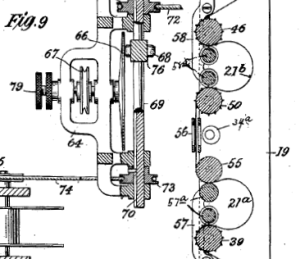 Latham was born in Washington, D.C. in 1837. He served as an ordnance officer in the Confederate Army and then a chemistry professor at West Virginia University. Pharmaceuticals in Nashville with his sons followed before they all got into the peep-show movie business in New York, finally coming up (with others) with one of the earliest movie-projection systems in 1895, first called the Panopticon and then the Eidoloscope. The bands of film associated with intermittent-motion film systems are still called Latham loops after his patent.
Latham was born in Washington, D.C. in 1837. He served as an ordnance officer in the Confederate Army and then a chemistry professor at West Virginia University. Pharmaceuticals in Nashville with his sons followed before they all got into the peep-show movie business in New York, finally coming up (with others) with one of the earliest movie-projection systems in 1895, first called the Panopticon and then the Eidoloscope. The bands of film associated with intermittent-motion film systems are still called Latham loops after his patent.
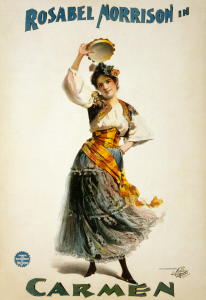 Beginning in 1896, Morrison performed the title role in a touring production of Carmen. According to The Bennett Playbill, “Critics predicted she was on the high road to fame and, in glowing terms, described her graceful figure and perfect brunette beauty,” also praising her “fluent French” and that she “was an excellent musician.” And there was a special twist to the production.
Beginning in 1896, Morrison performed the title role in a touring production of Carmen. According to The Bennett Playbill, “Critics predicted she was on the high road to fame and, in glowing terms, described her graceful figure and perfect brunette beauty,” also praising her “fluent French” and that she “was an excellent musician.” And there was a special twist to the production.
Ronald L. Davis of Southern Methodist University described it in a paper called “Opera Houses in Kansas, Nebraska, and the Dakotas: 1870-1920” published in the University of Nebraska’s Great Plains Quarterly in 1989. “On the evening of 28 January 1897, Rosabel Morrison sang a performance of Carmen at the Topeka Grand Opera House. In the final act, when Carmen has her confrontation with Don José outside the bullring, footage of an ‘authentic Spanish bull fight’ was projected on a canvas stretched across the stage, giving the Kansas capital not only its first movie but its first mixed media presentation as well.”
Ken Wlaschin’s Encyclopedia of Opera on Screen (Yale University Press, 2004) has this to say about that production. “First film seen in an opera was a bullfight shown in an 1896 production of Carmen by the Rosabel Morrison company at the Lyceum Theater in Elizabeth, New Jersey. It was shot in Mexico City using the Eidoloscope camera/projector.” In The Emergence of Cinema by Charles Musser (University of California Press, 1994), there’s an index entry for “Carmen (opera);” the listed page carries the story of the Eidoloscope bullfight film in the fourth act.
There are many references to how that production of the opera Carmen introduced many Americans to their first experience of movies. I made a number of them myself. And, then, last month, I posted corrections to those statements here. I neglected to heed the advice of Vincenzo Galilei sufficiently: “It appears to me that those who rely simply on the weight of authority to prove any assertion, without searching out the arguments to support it, act absurdly.”
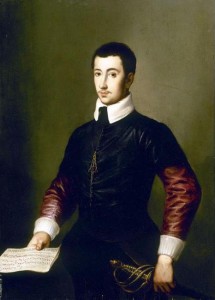 That’s how it was translated in James Reston’s Galileo: a Life (HarperCollins, 1994). Vincenzo, a famous musician, composer, and scientist of his day (he worked out the formulas of tuned strings and pipes) named his son Galileo because he found it mellifluous. And we call Galileo by his first name today because there was already a famous Galilei, his father. Perhaps I should mention that Vincenzo is also sometimes called the father of opera, for bringing his ideas about singing the words between arias (“recitative”) to Count Giovanni de’ Bardi’s Florentine Camerata, which, according to many scholars, came up with the first opera.
That’s how it was translated in James Reston’s Galileo: a Life (HarperCollins, 1994). Vincenzo, a famous musician, composer, and scientist of his day (he worked out the formulas of tuned strings and pipes) named his son Galileo because he found it mellifluous. And we call Galileo by his first name today because there was already a famous Galilei, his father. Perhaps I should mention that Vincenzo is also sometimes called the father of opera, for bringing his ideas about singing the words between arias (“recitative”) to Count Giovanni de’ Bardi’s Florentine Camerata, which, according to many scholars, came up with the first opera.
Georges Bizet’s opera Carmen, interestingly, was not composed with recitative. It consists of spoken dialogue between sung arias. After Bizet’s death, versions with recitative began to be performed.
Rosabel Morrison has become so associated with Bizet’s Carmen that, if you search for images of that opera, a poster of her as Carmen is likely to appear. As this is being written, one is even shown on San Francisco Opera’s educational web site of images of Carmen, captioned “Poster for Bizet’s Carmen, starring Rosabel Morrison.” But, despite its prominent words Rosabel Morrison and Carmen, it isn’t.
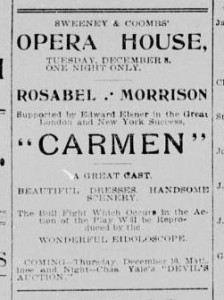 Before my error, I did do research. I read numerous scholarly references. I found ads in local papers, like one in the Houston Daily Post on December 6, 1896, which mentions the opera house, Rosabel Morrison, Carmen, and that the bullfight would be “Reproduced by the WONDERFUL EIDOLOSCOPE.”
Before my error, I did do research. I read numerous scholarly references. I found ads in local papers, like one in the Houston Daily Post on December 6, 1896, which mentions the opera house, Rosabel Morrison, Carmen, and that the bullfight would be “Reproduced by the WONDERFUL EIDOLOSCOPE.”
I became suspicious only after doing some more-recent research into the history of cinema technology for a different project. In Robertson’s Book of Firsts by Patrick Robertson (Bloomsbury, 2011), I found a reference to the Eidoloscope. According to the book, Latham’s company “pioneered once again when it produced a multi-scene version of Carmen, starring Rosabel Morrison.” “It is likely that this was the first true narrative film made anywhere in the world….” Really? How had I missed that?
So I hit the newspapers again. All I could find was the bullfight scene, and Robertson later told me he’d misinterpreted a reference. But, in the course of this new research, I made an important discovery: Morrison’s Carmen was not Bizet’s opera. It wasn’t an opera at all, but a play based on Prosper Mérimée’s story.
This is from The New York Dramatic Mirror of July 25, 1896 in a story headed “Rosabel Morrison in Carmen” (with a reference to the movie bullfight): “Miss Morrison’s version was adapted by Misses Marie Doran and Mollie Revel, and is said to be more exhaustive than any other stage version. It includes the character of Garcia, the convict husband of Carmen, who plays an important part in the story, but who has strangely been omitted in other adaptations, possibly because the opera has usually been taken for a model instead of the original tale.”
The Bennett Playbill (actress Joan Bennett was Morrison’s niece) says, “Advertisements were careful to inform playgoers that they were being offered a dramatic version of Carmen, not the musical one, for Bizet’s opera had become a popular standard in the operatic repertory since its American premiere in 1878.” I can’t say I’ve noticed any careful informing, but, in that Houston Daily Post ad, under the large “Opera House” and the even larger Carmen, the finest print, describing the movie, does say it’s part of the “Action of the Play” (not opera). The Faust in which Morrison performed Marguerite was also a play, despite Bennett & Kibbee’s reference to Gounod’s music.
That’s why I sent out my corrections, apologizing for writing that Morrison’s Carmen was an opera. But my research did turn up something else.
A few months before that Carmen opened, The Yankee Clipper by Fred Miller was first performed in Boston. Described variously as either an opera or an operetta, it wasn’t a huge hit with audiences. So it was trimmed, and Eidoloscope movies were shown between acts, “but without improving affairs,” according to The New York Dramatic Mirror on July 4, 1896. “When the company arrived on Saturday, they found a notice saying that the season would end that night. Thereupon they refused to go on for the evening.” And that’s why The Yankee Clipper was also not the opera that introduced many Americans to movies.
53. Opera and Stereoscopic 3D (2013 April 20)
Sunken Garden, a new opera staged by English National Opera (ENO), opened at London’s Barbican Centre on April 12. Its libretto is by Cloud Atlas author David Mitchell. It has been called the “first 3D opera.” It’s not.
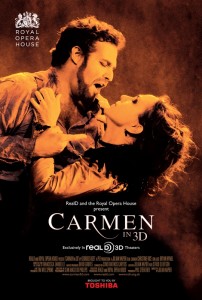 Opera audiences donned 3D glasses to view the action, but it wasn’t for the first time. A couple of months before Sunken Garden opened, a stereoscopic-3D Aida from Verona began appearing on movie screens, and London’s Royal Opera House has thus-far delivered two stereoscopic-3D opera movies, Madam Butterfly in 2012 and Carmen in 2011. Those weren’t live, but ENO’s earlier Lucrezia Borgia and Stockholm Folkoperan’s 2010 Faust were; they were transmitted live in stereoscopic 3D to cinemas (Lucrezia Borgia to homes, too). So was Don Giovanni from Opéra de Rennes in France in 2009, half a year before Avatar. Those were all in stereoscopic 3D only in cinemas (or homes), not in their opera houses, but Sunken Garden wasn’t even the first opera with stereoscopic 3D on stage.
Opera audiences donned 3D glasses to view the action, but it wasn’t for the first time. A couple of months before Sunken Garden opened, a stereoscopic-3D Aida from Verona began appearing on movie screens, and London’s Royal Opera House has thus-far delivered two stereoscopic-3D opera movies, Madam Butterfly in 2012 and Carmen in 2011. Those weren’t live, but ENO’s earlier Lucrezia Borgia and Stockholm Folkoperan’s 2010 Faust were; they were transmitted live in stereoscopic 3D to cinemas (Lucrezia Borgia to homes, too). So was Don Giovanni from Opéra de Rennes in France in 2009, half a year before Avatar. Those were all in stereoscopic 3D only in cinemas (or homes), not in their opera houses, but Sunken Garden wasn’t even the first opera with stereoscopic 3D on stage.
The Metropolitan Opera offered amazing, very realistic projected depth effects in Siegfried in 2011, but they required no glasses and weren’t stereoscopic; instead, the rotating “planks” of a giant “machine” on stage had images projected on them with depth varying according to the plank positions. Bluebeard’s Castle was staged with stereoscopic-3D projections on stage by the Hungarian State Opera House in Budapest in 2011. But even that wasn’t the first opera utilizing projected stereoscopic 3D.
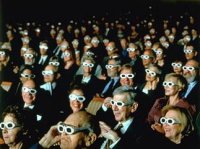 Photos of audiences wearing 3D glasses are common, but one looks different; its audience seems much better dressed than those who go to movies. That’s because it was shot of an opera audience viewing Monsters of Grace in 1998. Composed by Philip Glass, the opera was directed by Robert Wilson, who wanted such extraordinary set elements that it seemed less expensive, even back then, to create them as a computer-graphic stereoscopic-3D movie background instead. As best I know, audiences wore stereoscopic-3D glasses for every performance, in opera houses from Los Angeles to Athens.
Photos of audiences wearing 3D glasses are common, but one looks different; its audience seems much better dressed than those who go to movies. That’s because it was shot of an opera audience viewing Monsters of Grace in 1998. Composed by Philip Glass, the opera was directed by Robert Wilson, who wanted such extraordinary set elements that it seemed less expensive, even back then, to create them as a computer-graphic stereoscopic-3D movie background instead. As best I know, audiences wore stereoscopic-3D glasses for every performance, in opera houses from Los Angeles to Athens.
That might have been the first opera performed live with stereoscopic-3D on stage, but it’s not the first time opera was involved with stereoscopic 3D. Consider this paragraph from the diary of Mrs. G. Armstrong of 11 Percy Avenue, Auckland, New Zealand, during a trip to London:
“We dined in our hotel, and afterwards listened to an opera in the Concert Room. La Petronova was singing in a new work by the famous Russian composer, Smolensky. The opera was being performed in the Opera House in Milan. We saw it, of course, on the screen by television, but the transmission was so good it was almost impossible to realise we were not at the actual performance. The sound was perfect and the stereoscopic effect made the action look quite real. The only thing I noticed was that the colour very occasionally went wrong at the edge of the screen.”
The entry is dated Monday, May 17th, supposedly in the year 2456 (when, barring a future calendar change, May 17 will actually be on a Wednesday). But it was published in 1936 as part of After Us or The World as It Might Be by John Percy Lockhart-Mummery (Stanley Paul & Co. Ltd.). And even that wasn’t opera’s first connection with stereoscopic 3D.
Jules Duboscq sold 3D stereoscopes in 1851 and was awarded a French patent (13,069) for them on February 16, 1852. On November 12 of that year, he filed an addendum to the patent to add a “bioscope,” allowing for stereoscopic-3D photographic motion pictures, not only the world’s first 3D-movie patent but even the first photographic-movie patent. Duboscq was, at the time, the head of special effects of the Opéra de Paris, where he projected a sunrise effect using an electric arc in 1849 and later projected “moving” fountain images.
That’s probably the first association of opera with stereoscopic 3D, but there might be an earlier one. The stereographer Antoine Claudet later (1858) called Duboscq’s bioscope the most successful instrument of its kind. Claudet, himself, had an earlier claim to fame. At a time when photographic exposures typically took so long that people had to have their heads clamped into position, Claudet achieved the first snapshot. But how could he prove that the photo he showed hadn’t actually had a long exposure?
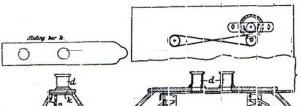 Claudet’s solution was described in Chambers’s Edinburgh Journal on Saturday, October 8, 1842. “Several members of the corps de ballet at the Italian opera [in London] lately stood — or rather danced — for their portraits to M. Claudet, in postures that could be retained but for an instant, such as poising on one toe with the other leg extended, and resting on the points of both feet.” Given that Claudet became a stereographer (he patented alternate-eye shuttering in 1853), it’s conceivable that he (or someone else) would have shot stereoscopic-3D snapshots of opera performers before 1852. I look forward to their discovery.
Claudet’s solution was described in Chambers’s Edinburgh Journal on Saturday, October 8, 1842. “Several members of the corps de ballet at the Italian opera [in London] lately stood — or rather danced — for their portraits to M. Claudet, in postures that could be retained but for an instant, such as poising on one toe with the other leg extended, and resting on the points of both feet.” Given that Claudet became a stereographer (he patented alternate-eye shuttering in 1853), it’s conceivable that he (or someone else) would have shot stereoscopic-3D snapshots of opera performers before 1852. I look forward to their discovery.
54. Opera and Stereo Sound (2013 April 27)
Of opera and stereoscopic 3D, I noted that despite being called “the first 3D opera” Sunken Garden wasn’t. A 2012 production of Neither, an opera (or “anti-opera” — it’s been called both) by Morton Feldman, with libretto by Samuel Beckett, has also been called “the first 3D opera.” Maybe so.
The 3D had nothing to do with stereoscopy. The production, directed by Sven Sören Beyer, which opened at the Festspielhaus Hellerau in Dresden, used 3D sound, from 80 speakers creating a synthesized wavefield. But it wasn’t the first time opera was involved in a sound-localization system.
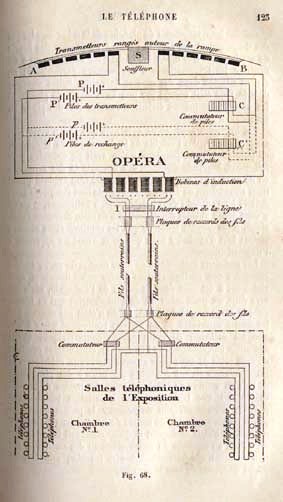 The first intentional time was at the International Electricity Exposition in Paris in 1881. Clément Ader, better known as an aviation pioneer (he coined the word avion, as in par avion air-mail stickers), rigged pairs of microphones across the edge of the stage of the Palais Garnier (the main Paris opera house of the time) and connected them to pairs of telephone receivers (of his own design) at the Exposition, a significant distance away.
The first intentional time was at the International Electricity Exposition in Paris in 1881. Clément Ader, better known as an aviation pioneer (he coined the word avion, as in par avion air-mail stickers), rigged pairs of microphones across the edge of the stage of the Palais Garnier (the main Paris opera house of the time) and connected them to pairs of telephone receivers (of his own design) at the Exposition, a significant distance away.
It wasn’t just the first time opera was transmitted stereophonically; it was the first stereo sound transmission, period. Of course, stereo sound was then an unknown term, so Ader called it “binauricular auduition” but compared it to a 3D stereoscope.
It’s not clear whether Ader was influenced by earlier transmissions of opera over telephone lines, but it’s clear how influential his demonstrations were. Victor Hugo was one of the listeners and pronounced the system both amazing and delightful.
Then there’s the author Albert Robida, who, in a novel first published in 1882, seemingly predicted much of the modern media landscape: one-person video journalism, product placement in broadcast scripts, online pornography, home shopping, distance learning, injured on-camera video war correspondents becoming the news story, and, yes, opera on television. According to the Wesleyan University Press version of The Twentieth Century, Robida’s inspiration was Ader’s demo.
When, in 1884, the king of Portugal couldn’t attend an important opera performance because his sister, the princess of Saxony, had died, and rules of royal mourning restricted him to the palace, the local phone company manager delivered the opera in stereo by duplicating Ader’s setup. That led to theatrical promoters creating the first pay-cable service in Lisbon the following year, delivering an entire season of operas to homes for a fee.
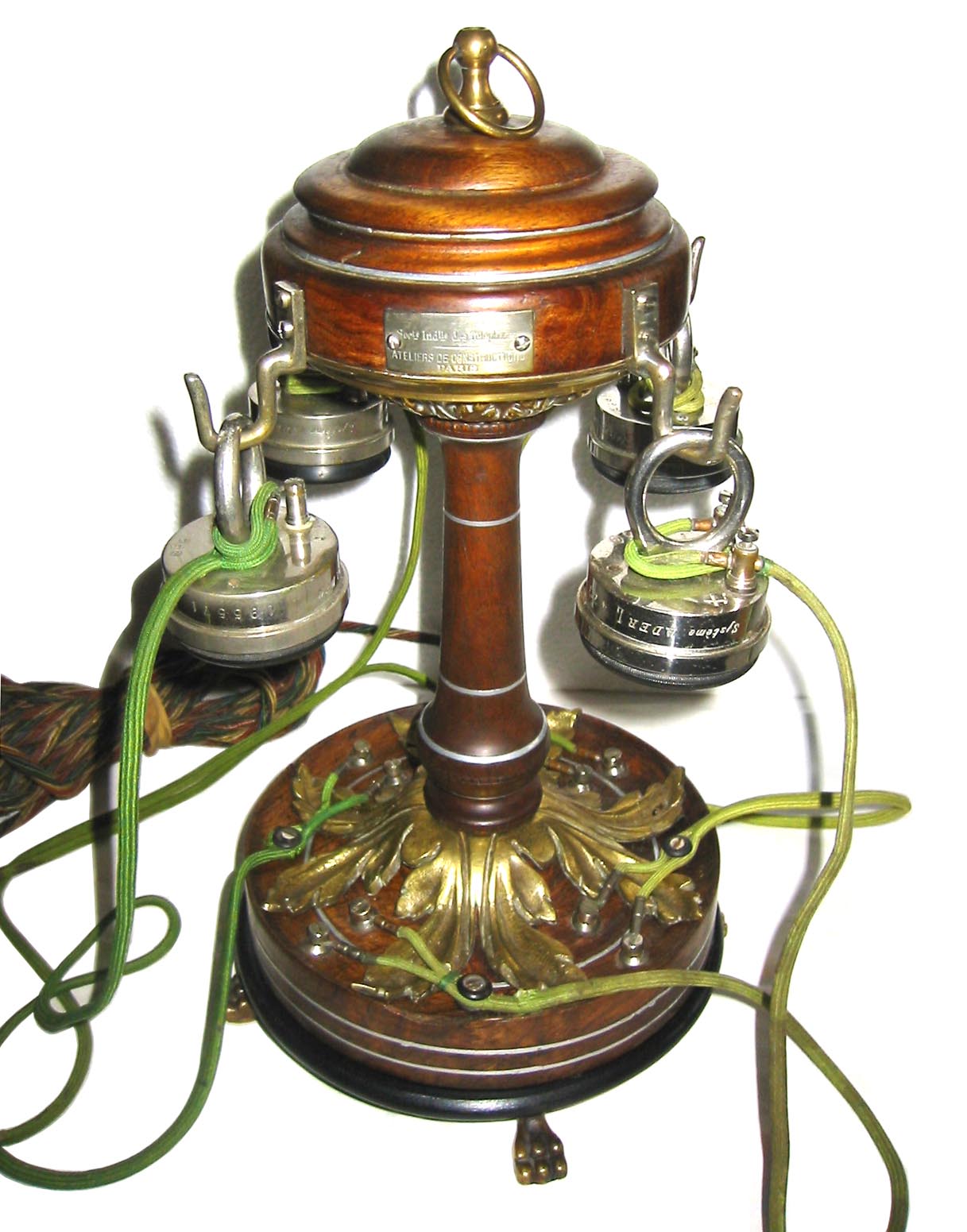 Ader, himself, brought commercial stereo opera-by-phone service to Paris a few years later. Among his customers were the President of France, opera composer Charles Gounod (who used it to listen to the opera Samson et Dalila), and the writer Marcel Proust (who first listened to the opera Pelléas et Mélisande in his bed).
Ader, himself, brought commercial stereo opera-by-phone service to Paris a few years later. Among his customers were the President of France, opera composer Charles Gounod (who used it to listen to the opera Samson et Dalila), and the writer Marcel Proust (who first listened to the opera Pelléas et Mélisande in his bed).
Of course, that wasn’t the end of opera in stereo. There were stereo opera radio broadcasts from Berlin no later than 1925. I’ve already written here about the Bell Labs stereo opera experiments in 1933 (44. Super-soprano and the Ceno-orchestra). The Los Angeles Times reported in 1952 that the Orpheum Theater in that city installed a stereo sound system for the Met’s first live cinema transmission.
The first commercial stereo sound recording is a matter of some dispute, but one of the contenders is a symphonic recording of Berlioz’s Damnation of Faust. The world’s first live stereo network was the Metropolitan Opera’s radio network (starting in 1973). The first live television show available in stereo sound to more than half of U.S. television households was Live from Lincoln Center’s transmission of the opera The Ballad of Baby Doe in 1976. And Lincoln Center’s first (and still only) patent was issued the same year for the first stereo pay-TV set-top box, to be used for opera (not exclusively).
Wavefield sonic 3D? Why not?
55. Opera and the Invention of the Newscast (2013 May 19)
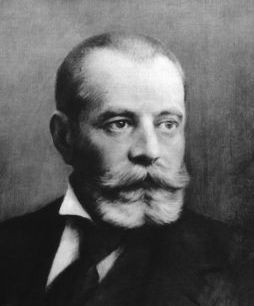 Like Count Dracula, Puskás Tivadar (sometimes called Theodore Buschgasch in English) was descended from Transylvanian nobility. Born in 1844, he studied law and engineering, dabbled in railroad work, travel agency, and mining, and created the first telephone central office. Some even credit him with introducing the word “hello” as an electronic-conversation opener. But the reason I’m mentioning him here is that he also created the first newscast — thanks to opera.
Like Count Dracula, Puskás Tivadar (sometimes called Theodore Buschgasch in English) was descended from Transylvanian nobility. Born in 1844, he studied law and engineering, dabbled in railroad work, travel agency, and mining, and created the first telephone central office. Some even credit him with introducing the word “hello” as an electronic-conversation opener. But the reason I’m mentioning him here is that he also created the first newscast — thanks to opera.
I’ve written previously about how, influenced by the 1881 public transmission of opera in stereo over telephone lines in Paris, Albert Robida described newscasts in his 1882 book Le vingtième siècle (The Twentieth Century). Robida might also have been influenced by the delivery of news by telegraph to the Grand Tier of the Royal Italian Opera House in London for decades.
Some say Robida predicted newscasts, and, indeed, much of what he wrote seems remarkably prescient. But the book also describes such not-yet implemented concepts as mid-ocean undersea train stations and cyclical scheduled revolutions in lieu of elections. Even in its chapter describing opera on television (or, as Robida called it, the téléphonoscope), the system was two-way, allowing visual conversations between home viewers and those in boxes at the opera house.
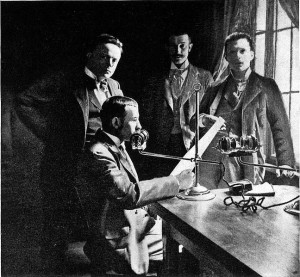 Puskás was different. He didn’t merely hypothesize the newscast; he actually created it. In 1893, on February 15, news readers began reporting into microphones at the offices of the Telefon-Hírmondó at Magyar utca 6 in Budapest. It was a fully staffed news operation, with a hundred employees, including editors, telegraph operators, foreign-newspaper readers, and investigators (who used nine telephone lines as well as a direct connection to the Hungarian parliament). As for the six news readers, they were called “stentors,” after the legendarily loud Greek herald who appears in Homer’s Iliad. Here’s his description in Alexander Pope’s 1760 translation: “Stentor the strong, endowed with brazen lungs, whose throat surpassed the force of fifty tongues.”
Puskás was different. He didn’t merely hypothesize the newscast; he actually created it. In 1893, on February 15, news readers began reporting into microphones at the offices of the Telefon-Hírmondó at Magyar utca 6 in Budapest. It was a fully staffed news operation, with a hundred employees, including editors, telegraph operators, foreign-newspaper readers, and investigators (who used nine telephone lines as well as a direct connection to the Hungarian parliament). As for the six news readers, they were called “stentors,” after the legendarily loud Greek herald who appears in Homer’s Iliad. Here’s his description in Alexander Pope’s 1760 translation: “Stentor the strong, endowed with brazen lungs, whose throat surpassed the force of fifty tongues.”
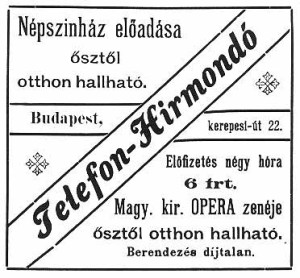 Some say the technology Puskás developed and patented could serve as many as half-a-million listeners at a time — in an era before what we think of as electronic amplifiers. The Telefon-Hírmondó began in 1893 with 60 subscribers and ended the year with 700, something Puskás never knew, having died at age 49 one month after commercial operation began. By the end of 1894, there were 4915 subscribers. The service lasted into World War II, when its facilities were destroyed by bombing. By then, the existence of radio made rebuilding a wired broadcast service commercially impractical.
Some say the technology Puskás developed and patented could serve as many as half-a-million listeners at a time — in an era before what we think of as electronic amplifiers. The Telefon-Hírmondó began in 1893 with 60 subscribers and ended the year with 700, something Puskás never knew, having died at age 49 one month after commercial operation began. By the end of 1894, there were 4915 subscribers. The service lasted into World War II, when its facilities were destroyed by bombing. By then, the existence of radio made rebuilding a wired broadcast service commercially impractical.
What does this have to do with opera? Puskás had been involved in the 1881 Paris stereo opera transmission experiments, and, in 1882, on February 4, he transmitted Erkel’s opera Hunyadi László from Budapest’s National Theater to a ball at the Vigadó concert hall (he also worked on the installation of electric lighting at the Palais Garnier opera house in Paris). When The Electrician reported in its March 28, 1885 issue that the head of the opera house in Madrid was planning to start a telephone-delivered home opera service, it was Puskás’s equipment that was to be used.
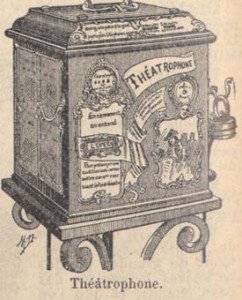 The first commercial opera-by-phone service began in Lisbon in October 1885. Its business plan was annual subscription (90 performances for 180,000 reis — about $20 each in today’s money). The institutional version that began appearing in Paris hotel lobbies and train stations in 1889 was coin operated. The Paris home version the following year involved a fee for connection to a Puskás-developed exchange, and then a pay-per-event model, with the subscriber able to select among performances at different opera houses.
The first commercial opera-by-phone service began in Lisbon in October 1885. Its business plan was annual subscription (90 performances for 180,000 reis — about $20 each in today’s money). The institutional version that began appearing in Paris hotel lobbies and train stations in 1889 was coin operated. The Paris home version the following year involved a fee for connection to a Puskás-developed exchange, and then a pay-per-event model, with the subscriber able to select among performances at different opera houses.
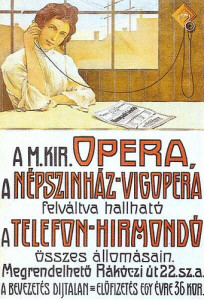 It seems likely, therefore, that Puskás was initially planning an opera-by-telephone service for Budapest, too. From the outset, the Telefon-Hírmondó offered nightly opera transmissions, with 27 lines run from the opera house “thru a patented device which increases the sound, its distribution to subscribers regulated by another ingenious contrivance, also patented,” according to a report in the April 1901 issue of Telephone Magazine. And, on nights when there was no opera, the Telefon-Hírmondó offered its own concerts, played by musicians on staff. But it probably seemed wasteful to Puskás, whose business plan was monthly subscriptions, to run lines and have them sit unused until the opera started. So he came up with something to fill the idle times and attract more subscribers, the world’s first newscasts.
It seems likely, therefore, that Puskás was initially planning an opera-by-telephone service for Budapest, too. From the outset, the Telefon-Hírmondó offered nightly opera transmissions, with 27 lines run from the opera house “thru a patented device which increases the sound, its distribution to subscribers regulated by another ingenious contrivance, also patented,” according to a report in the April 1901 issue of Telephone Magazine. And, on nights when there was no opera, the Telefon-Hírmondó offered its own concerts, played by musicians on staff. But it probably seemed wasteful to Puskás, whose business plan was monthly subscriptions, to run lines and have them sit unused until the opera started. So he came up with something to fill the idle times and attract more subscribers, the world’s first newscasts.
56. Public Executions, Prostitution, and the First Opera House (2013 June 4)
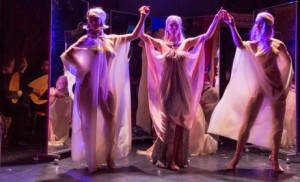 This year, I have thus far attended opera performances in a medieval chapel, a hipster hangout, a college auditorium, a burlesque house, and a nightclub. I have a ticket to attend one later this month at a botanical garden. I’ve gone to opera on the lawn of one castle and in the courtyard of another as well as in a high-school gymnasium and a high-altitude stable. I missed one in a planetarium. But most of the time I attend opera in an opera house.
This year, I have thus far attended opera performances in a medieval chapel, a hipster hangout, a college auditorium, a burlesque house, and a nightclub. I have a ticket to attend one later this month at a botanical garden. I’ve gone to opera on the lawn of one castle and in the courtyard of another as well as in a high-school gymnasium and a high-altitude stable. I missed one in a planetarium. But most of the time I attend opera in an opera house.
I don’t know when or where the first opera was performed. Many scholars say it was Dafne in Florence in 1598 (the Florentine calendar made the year 1597). But others pick an Orfeo in Bologna around 1480. And there are more choices, both later and earlier. I saw a performance of Danielis this year. It had music, a cast that sung their every word, a good story, sets, costumes, theatrical effects, and choreography, and it was directed by someone most famous as an opera countertenor. I can’t think of a single reason why it shouldn’t be considered an opera. But the best guess is that it was first performed in Beauvais, France in the early 13th century and might have been written in the previous century.
While there is much dispute about the first opera, there seems none about the first opera house to sell tickets. It was Teatro San Cassiano in Venice, and it sold its first ticket in what we call 1637, probably in late February.
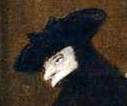 Entertainments in Venice at the time included gang stick fights on bridges, public executions, and a long carnival season during which people wore long-nosed masks and watched young nobles performing comedies. Today, there’s not much talk of comedy by the nobility, few long-nosed masks, and neither stick fights nor executions as entertainment. There’s also not a lot of jousting. In my opinion, a big reason opera has survived and those other entertainments haven’t is that first ticket-selling opera house.
Entertainments in Venice at the time included gang stick fights on bridges, public executions, and a long carnival season during which people wore long-nosed masks and watched young nobles performing comedies. Today, there’s not much talk of comedy by the nobility, few long-nosed masks, and neither stick fights nor executions as entertainment. There’s also not a lot of jousting. In my opinion, a big reason opera has survived and those other entertainments haven’t is that first ticket-selling opera house.
A lot can be traced to it: the orchestra pit in front of the stage, the large auditorium (see discussion 20. Why Is Soap Opera Called Opera?), the idea of listening outside the house (see discussion 50. Opera and the Plazacast), pre-opera libretto sales — perhaps even the idea of darkening the auditorium before performances. Here’s a report that appeared in the Mercure Galant in 1683 about another Venetian opera house (as translated in A Source Book in Theatrical History edited by Alois Maria Nagler, Courier Dover 1959):
“An hour before the opening of the theater, the painting of the Venus is withdrawn, leaving a great opening whence descends a kind of chandelier ornamented with four branches of gold and silver work.” “The chandelier carries four great tapers of white wax, which light the auditorium and remain lighted until the curtain is raised. Then the whole machine vanishes, and the proscenium returns to its first state. As soon as the opera is ended, this machine appears again to light the auditorium and to allow the spectators to leave at their ease and without confusion.”
Because projectionists don’t know when live transmission will end, The Metropolitan Opera: Live in HD also has to provide exit lighting in its cinemas. It transmits a white picture for ten minutes.
The most-significant development attributed to that first opera house, however, and the one that, in my opinion, helped opera survive over the centuries, was the introduction of boxes, where the rich and famous could see (each other), be seen, and enrich the owners of the opera house by renting their boxes. The reason I added “each other” is that the most expensive boxes were the ones on either side of the stage, with the worst view of the opera but the best of the other boxes.
Producing a play in Venice at the time might have cost about 250 ducats. Producing an opera was perhaps 3000. The difference was made up by both the size of the house and the rental of the boxes, the latter bringing in 2500 ducats alone. Teatro San Cassiano had a whopping 98 boxes. But was it the first?
A year before that opera house opened, a so-called “tournament” (an opera) called Ermiona was given a single performance in a specially built theater in Padua. Here’s a description from the libretto, as translated in Opera in Seventeenth-Century Venice: The Creation of a Genre by Ellen Rosand, University of California Press, 1991: “Five rows of galleries circled all around, one above the other, with parapets of marble balusters; the spaces, large enough to accommodate sixteen spectators each, were separated by partitions….” If the boxes at Teatro San Cassiano were as large, they could hold 1568 operagoers, not counting the non-box audience.
Were those boxes in Padua the first? No. Eugene J. Johnson published “The Short, Lascivious Lives of Two Venetian Theaters, 1580-85” in the Autumn 2002 issue of Renaissance Quarterly, and, yes, those theaters had boxes. Johnson also explains why their lives were both lascivious and short:
“Goings-on in the closed boxes caused considerable scandal. The documents describe no specific acts, but one can hardly go wrong if one characterizes them as sexual, nor can one exclude the possibility that some of Venice’s famous courtesans may have set up shop in the [boxes]. The existence of the boxes, the scandalous nature of the behavior therein, and the concern expressed over the boxes by the Jesuits resident in Venice were also documented in a letter written in October, 1581, by the Florentine ambassador to Venice….” The Jesuits eventually succeeded in getting the theaters shut down.
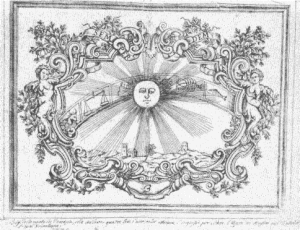 Two noble Venetian families ran those theaters, the Michiel and the Tron. Johnson knows of no indication that the Michiel were ever involved in another theater. But, after the Jesuits left Venice, the Tron rebuilt their theater, rebuilt it again after a fire, and, finally, modified it to become the first ticket-selling opera house in 1637.
Two noble Venetian families ran those theaters, the Michiel and the Tron. Johnson knows of no indication that the Michiel were ever involved in another theater. But, after the Jesuits left Venice, the Tron rebuilt their theater, rebuilt it again after a fire, and, finally, modified it to become the first ticket-selling opera house in 1637.
And where did the idea of boxes come from? Johnson wrote an earlier article, “Jacopo Sansovino, Giacomo Torelli, and the Theatricality of the Piazzetta in Venice” in the December 2000 issue of the Journal of the Society of Architectural Historians. The piazzetta is probably the most famous public space in Venice, the gateway from the water to St. Mark’s cathedral and the Doge’s palace. Sansovino was the architect of one of the buildings on the piazzetta, St. Mark’s library opposite the palace, and Torelli was probably the most famous engineer (and stage designer) in opera history — people would attend just to see his 17th-century stage machinery at work.
The opening of Johnson’s article suggests its subject: “Modern students of Venetian architecture have noted a relationship between the Piazzetta in Venice, viewed from the water, and Renaissance scene designs….” He provides many examples of how that view influenced stage scenery. But then he turns around to the view of the water, where public executions took place. There are paintings and drawings showing such entertainments being witnessed from such locations as the library’s windows. Here’s Johnson:
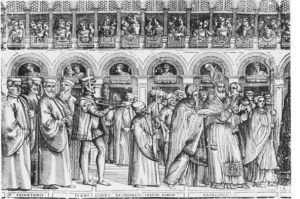 “The window balconies to which the procurators were assigned in the Libreria turn out to be spaces much like those of theater boxes.” “Both balconies and boxes provided elevated, separated spaces for patricians to watch performances and in turn to be watched.”
“The window balconies to which the procurators were assigned in the Libreria turn out to be spaces much like those of theater boxes.” “Both balconies and boxes provided elevated, separated spaces for patricians to watch performances and in turn to be watched.”
Whether it was the watching or the being watched, the wealthy (and government officials) have kept opera going ever since. Thanks!
57. Opera and the First Snapshot (2013 June 13)
The first opera to use recorded music on stage was Kurt Weill’s 1927 Der Zar lässt sich photographieren (The Tsar Has His Photograph Taken). Weill’s “Tango Angèle” was recorded and then played back on a practical gramophone on the stage. The disk was distributed with the score, probably helping it become, reportedly, Weill’s best-selling record. Weill was also the first to incorporate a motion-picture interlude into an opera score (Royal Palace 1928). But neither is what this post is about.
The story of Der Zar is that the Tsar telephones a studio to arrange to be photographed. Before he arrives, revolutionaries take over the studio and rig the camera so that, when the shutter bulb is squeezed, the Tsar will be shot ballistically rather than photographically.
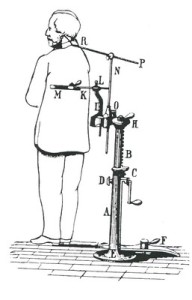 The Tsar had to go to a studio because photography, in its early days, was very different. If people seem stiff in 19th-century photographs, it’s because they were — clamped into place. They were unsmiling because it was hard to maintain a smile during the long minutes of exposure.
The Tsar had to go to a studio because photography, in its early days, was very different. If people seem stiff in 19th-century photographs, it’s because they were — clamped into place. They were unsmiling because it was hard to maintain a smile during the long minutes of exposure.
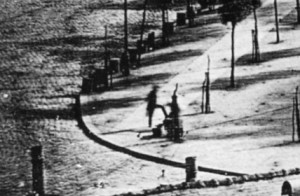 The invention of photography is sometimes credited to Louis Daguerre, a scenic artist and extra (and sometimes dancer) at the Paris Opera. He was probably the first person to photograph a human being. Although that image was shot on a busy Paris street, only one person, getting his shoe shined, can be vaguely seen; everyone else was moving and, therefore, invisible. The unmoving cobblestones are in sharp focus.
The invention of photography is sometimes credited to Louis Daguerre, a scenic artist and extra (and sometimes dancer) at the Paris Opera. He was probably the first person to photograph a human being. Although that image was shot on a busy Paris street, only one person, getting his shoe shined, can be vaguely seen; everyone else was moving and, therefore, invisible. The unmoving cobblestones are in sharp focus.
Antoine Claudet was taught by Daguerre and licensed by him to create Daguerreotypes in Britain. But he hated the long exposure times, so he experimented and was the first to publish a technique for increasing sensitivity through the use of chlorine and iodine. With a few more improvements, he was ready to shoot the first snapshot — an essentially instantaneous exposure. But what could he shoot? What could prove that the exposure was instantaneous?
Opera came to the rescue! Claudet shot dancers from the Italian Opera in poses they couldn’t possibly maintain for long durations. The result was so successful that he was able to open a “Temple of Photography” in London, where he continued experiments that led to, among other things, the darkroom safe light, the light meter, the side-by-side stereoscopic-3D shooting rig, and active-shutter stereoscopic-3D viewing. He was Queen Victoria’s photographer, and another customer was, yes, the Tsar.
Unfortunately, a year after his death, his Temple of Photography burned. It seems that the opera-performers photograph that started him on the road to success burned with it.
Alas!
58. Opera and Neutrinos (2013 June 22)
Just as libretto means little book in Italian, the original language of opera, neutrino means little neutral one — very little and very neutral. That subatomic particle can pass through things more easily than a hot knife through warm butter.
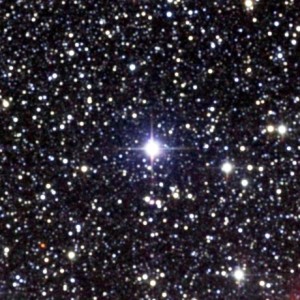 What kind of things, and how easily? Stars generate neutrinos. The sun is our closest star. The second closest is Proxima Centauri. It’s about 40 trillion kilometers (about 25 trillion miles) away. That’s a lot of kilometers (or miles), so we typically use a different distance measurement, a light year, the distance light travels through vacuum in a year. That way, Proxima Centauri is a mere four light years (or so) away.
What kind of things, and how easily? Stars generate neutrinos. The sun is our closest star. The second closest is Proxima Centauri. It’s about 40 trillion kilometers (about 25 trillion miles) away. That’s a lot of kilometers (or miles), so we typically use a different distance measurement, a light year, the distance light travels through vacuum in a year. That way, Proxima Centauri is a mere four light years (or so) away.
Imagine a star almost 250-times farther — a thousand light years away. Now imagine that somehow a solid lead column connects that distant star and Earth. If you put a neutrino detector at the Earth end of the column, you might detect a neutrino that left that star a thousand years earlier and passed through about ten quadrillion kilometers of solid lead. That’s how tiny and neutral neutrinos are.
What does this have to do with opera? Aside from operas dealing with the subject of particle physics, there are at least two things, actually.
The first was an exciting report in September 2011 from scientists who thought they had found neutrinos traveling faster than the speed of light in a vacuum (they later recanted). Those neutrinos came from the European Centre for Nuclear Research (CERN) near Geneva (home of the Large Hadron Collider), and the detector used is deep beneath Gran Sasso mountain in Italy. The mountain’s rock helps protect Laboratori Nazionali del Gran Sasso from cosmic rays. The neutrino detector is made of 150,000 “bricks” made of sheets of lead and photographic emulsion. I’ve seen pictures of it. It’s impressive, but it doesn’t look anything like an opera house.
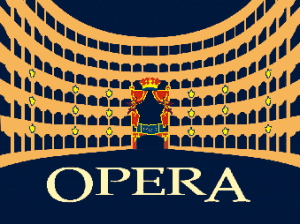 Nevertheless, the scientists named their detector OPERA, a strange acronym standing for the Oscillation Project with Emulsion-tRacking Apparatus. Note that the word matching the R starts with a T. And the logo for their project is a stylized interior of a typical old European opera house as seen from the stage, with a royal box in the center, six tiers of other boxes, and the word OPERA underneath. Perhaps the tiers of boxes are meant to suggest the stacking of the “bricks.”
Nevertheless, the scientists named their detector OPERA, a strange acronym standing for the Oscillation Project with Emulsion-tRacking Apparatus. Note that the word matching the R starts with a T. And the logo for their project is a stylized interior of a typical old European opera house as seen from the stage, with a royal box in the center, six tiers of other boxes, and the word OPERA underneath. Perhaps the tiers of boxes are meant to suggest the stacking of the “bricks.”
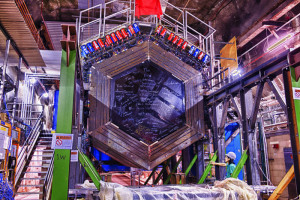 Another neutrino-opera connection was first reported in March 2012 at a different detector, this time at the Fermi National Accelerator Laboratory (Fermilab) near Chicago. The 170-ton detector is called MINERνA (the Main INjector ExpeRiment for ν-A). What looks like a lower-case v is actually the Greek letter nu, the symbol of the neutrino, and the A, in effect, stands for atom, the idea being that, with enough neutrinos, some might interact with atomic nuclei. The detector’s emblem is the head of a statue of Minerva, the Roman goddess of wisdom and sponsor of the arts (especially opera’s music and poetry).
Another neutrino-opera connection was first reported in March 2012 at a different detector, this time at the Fermi National Accelerator Laboratory (Fermilab) near Chicago. The 170-ton detector is called MINERνA (the Main INjector ExpeRiment for ν-A). What looks like a lower-case v is actually the Greek letter nu, the symbol of the neutrino, and the A, in effect, stands for atom, the idea being that, with enough neutrinos, some might interact with atomic nuclei. The detector’s emblem is the head of a statue of Minerva, the Roman goddess of wisdom and sponsor of the arts (especially opera’s music and poetry).
The neutrinos detected by MINERνA come from NuMI (Neutrinos at the Main Injector) a little over one kilometer away, with about 240 meters of rock, mostly shale, in between. It’s no thousand light years of lead; it’s not even an Italian mountain a long distance from Geneva. But here’s what happened:
Scientists converted the word “neutrino” into the digital ones and zeros of the American Standard Code for Information Interchange (ASCII). Then they effectively turned the NuMI beam on and off to represent those ones and zeros. And MINERνA detected the information! It was the first time neutrinos had been used for communication.
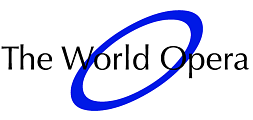 What does that have to do with opera? Niels Windfeld Lund was a professor at the University of Tromsø in Norway, north of the Arctic Circle. He had a vision, the World Opera Project (having an international workshop in Struer, Denmark later this summer – http://www.theworldopera.org/).
What does that have to do with opera? Niels Windfeld Lund was a professor at the University of Tromsø in Norway, north of the Arctic Circle. He had a vision, the World Opera Project (having an international workshop in Struer, Denmark later this summer – http://www.theworldopera.org/).
The best opera singers perform all over the world: New York, Milan, Buenos Aires, Paris, Sydney, etc. Getting them together in one place requires scheduling years in advance, and, even then, only the people at that opera house can hear and see them. In the World Opera Project, the singers, the orchestra, the conductor, the scenery, and the audiences could be anywhere, brought together by modern technology.
Certainly, there are challenges, so the project has enlisted top laboratories around the world to work on them. We don’t yet have imaging technologies, for example, that will allow singers in different locations to appear to perform a love scene together, especially with an embrace, but such systems are at least conceivable (think of the image-compositing systems already available).
Then there’s the speed of transmission. Bit-rate-reduction (data-compression) systems usually delay their signals, so an early World Opera Project test transmission made use of the ultra-high-speed data lines connecting CERN to other particle-physics sites to allow uncompressed high-definition video transmission of opera. But there was still a problem.
The minimum communications distance between Arts Centre Melbourne’s opera house in Australia and London’s Royal Opera House in Covent Garden is almost 17,000 kilometers (more than 10,500 miles) — and that’s assuming someone were to run a fiber-optic cable directly between the two or, better yet, erect a series of towers across the sea and land in between to carry the signals. Even at that shortest connection, and even at the speed of light in a vacuum, it would take signals more than 56 thousandths of a second to get from one opera house to the other. That’s roughly how long it would take sound at room temperature to travel the length of a bowling alley lane from foul line to end of pin deck, a distance more than 16% wider than the very wide proscenium opening at the Metropolitan Opera House.
Imagine an intimate operatic love scene, with the lovers separated by that great a distance. It’s not so good. But neutrinos can shorten the distance.
Neutrinos don’t need fiber optics or transmission towers; they pass right through the earth. That means that no two places on the planet can be more than about 12,700 kilometers apart; Melbourne and London would be even closer.
The experimental neutrino communication at Fermilab had a bit error rate of about 1% — not bad. Unfortunately, it also had a transmission rate of about a tenth of a bit per second, taking more than six minutes to transmit just the word “neutrino.” Uncompressed real-time high-definition video requires a transmission rate about ten billion times faster. And, while neutrinos greatly shorten the transmission distance, they don’t eliminate it. Instead of the lovers being acoustically separated by the length of a bowling lane, they might be just two-thirds of a bowling lane apart.
If only OPERA really had detected faster-than-light neutrinos, we might be all set. But Professor Lund is planning a new World Opera Lab, so stand by for further developments.
59. Unstageable Operas (2013 June 29)
I sometimes attend performances at the roofless Delacorte Theater in Central Park, where the momentary din of passing sirens and jet engines can be heard. One year, at the beginning of a production of The Tempest, the sound of a rotor came and didn’t pass. A helicopter hovered overhead. Patrick Stewart, playing Prospero, came onstage holding a toy helicopter. Whatever he did to the toy, the same change occurred at its large counterpart in the sky. It was an interesting way of depicting Prospero’s control over the title storm’s effect on the travelers.
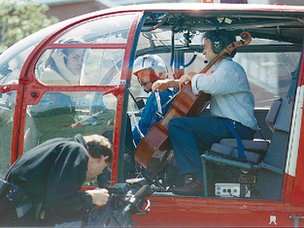 Last summer, Birmingham Opera Company presented Karlheinz Stockhausen’s six-hour opera Mittwoch aus Licht (Wednesday from Light, meaning it was one of a seven-opera cycle, one for each day of the week). It involved four full-size flying helicopters. They weren’t the idea of director Graham Vick; they are part of the instrumentation in the score written by the composer, a Helikopter-Streichquartett (helicopter string quartet) as he put it, which includes musicians, pilots, string instruments, audio and video equipment, and technicians. In one of the other scenes, two of the musicians are described as “bass with short-wave receiver” and “camel assistant.”
Last summer, Birmingham Opera Company presented Karlheinz Stockhausen’s six-hour opera Mittwoch aus Licht (Wednesday from Light, meaning it was one of a seven-opera cycle, one for each day of the week). It involved four full-size flying helicopters. They weren’t the idea of director Graham Vick; they are part of the instrumentation in the score written by the composer, a Helikopter-Streichquartett (helicopter string quartet) as he put it, which includes musicians, pilots, string instruments, audio and video equipment, and technicians. In one of the other scenes, two of the musicians are described as “bass with short-wave receiver” and “camel assistant.” 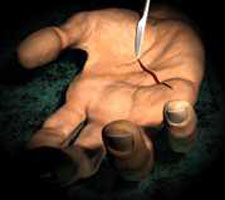 The opera was long considered “unstageable,” but it wasn’t; it was just more difficult than most.
The opera was long considered “unstageable,” but it wasn’t; it was just more difficult than most.
That might also be said of Robert Wilson’s 1998 production of Philip Glass’s Monsters of Grace. The director’s concept included giant body parts (as in some animated Monty Python clips) and, yes, a helicopter (this time flying over the Great Wall of China). Although Wilson wanted those things to be physically present, the cost was considered so great that it was less expensive to create a stereoscopic computer-graphic movie as a stage backdrop and have audiences wear 3D glasses.
 Neither of those operas was truly unstageable; they were just difficult to stage. At the Bregenz Festival in Austria, opera scenery the size of skyscrapers sometimes emerges from Lake Constance. But there have been supposedly unstageable operas. In fact, in 1989, the UK television broadcaster Channel 4 budgeted more than three million pounds to commission six operas that, in the words of Jennifer Barnes in Television Opera (Boydell 2003), “should be written in such a way that would preclude a subsequent transfer to the stage.” Barnes quotes Channel 4’s Andrew Yates having to remind someone in 1991 that an opera was to be “unsuitable for live performance!”
Neither of those operas was truly unstageable; they were just difficult to stage. At the Bregenz Festival in Austria, opera scenery the size of skyscrapers sometimes emerges from Lake Constance. But there have been supposedly unstageable operas. In fact, in 1989, the UK television broadcaster Channel 4 budgeted more than three million pounds to commission six operas that, in the words of Jennifer Barnes in Television Opera (Boydell 2003), “should be written in such a way that would preclude a subsequent transfer to the stage.” Barnes quotes Channel 4’s Andrew Yates having to remind someone in 1991 that an opera was to be “unsuitable for live performance!”
Although I don’t know where Channel 4 got the idea for unstageable television operas, I’m pretty sure the first was Gian Carlo Menotti’s Labyrinth, commissioned by and first aired on NBC Opera Theatre in 1963. Its use of video effects is what made it unstageable. But more than a quarter century earlier, there was another unstageable opera, Louis Gruenberg’s Green Mansions.
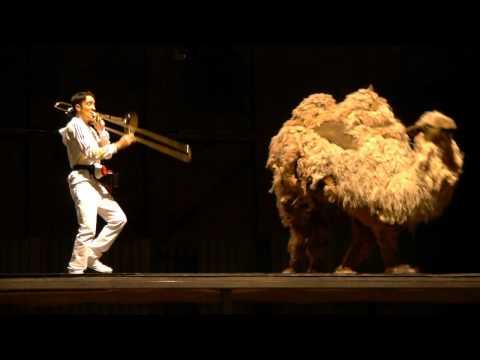 It’s actually more famous for its orchestration than for its unstageability. It had neither helicopter string quartet nor camel, but, according to a contemporary report in The New Yorker magazine, it was the first time music had been written specifically for a saw. Like Labyrinth, Green Mansions used special effects. Being a radio opera rather than a TV opera (and on CBS rather than NBC), its effects were aural rather than visual, evoking its jungle setting.
It’s actually more famous for its orchestration than for its unstageability. It had neither helicopter string quartet nor camel, but, according to a contemporary report in The New Yorker magazine, it was the first time music had been written specifically for a saw. Like Labyrinth, Green Mansions used special effects. Being a radio opera rather than a TV opera (and on CBS rather than NBC), its effects were aural rather than visual, evoking its jungle setting.
I suspect that both Green Mansions and Labyrinth really could be staged. But perhaps they shouldn’t.
Comment from Karen McLaughlin: Lots of fun information. What kind of saw was used in Green Mansions? I assume not the play-by-hand kind, but was it motorized?
Response: It was, indeed, the play-by-hand type. It was by no means the first time a musical saw had been used, but, according to Lucille Fletcher in The New Yorker on May 7, 1938, it was “a memorable day in the history of music” when Gruenberg “assigned Rima’s song to a solo musical saw, thus becoming the first composer ever to write for that instrument.” The article places the origin of the musical saw in 1904 in Springfield, MO, where Leon Weaver noticed Fitch Cooper imitating owls and windstorms on a saw and realized he could make music with it. Leon’s sister-in-law June made several important changes in technique, including a shift from padded hammer to bow for playing.
 At the time The New Yorker article was published, there was still a debate about whether musical saws should be the ordinary carpenter variety or specially made. The Weavers sawed wood with their instruments after each concert. A bibliography at the end of the piece starts with “Sawing News of the World,” published annually by Mussehl & Westphal.
At the time The New Yorker article was published, there was still a debate about whether musical saws should be the ordinary carpenter variety or specially made. The Weavers sawed wood with their instruments after each concert. A bibliography at the end of the piece starts with “Sawing News of the World,” published annually by Mussehl & Westphal.
60. Opera and Eye (2013 July 10)
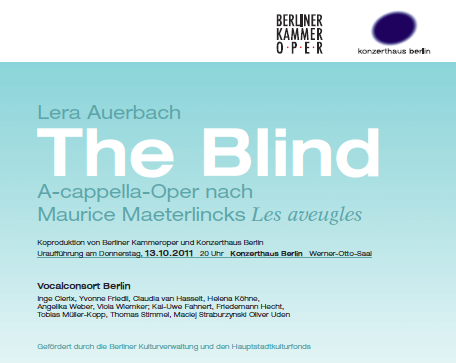 The Blind, an opera by Lera Auerbach being performed this week at the Lincoln Center Festival, has a number of unusual aspects. Unlike many opera productions today, it does not have visible titles to indicate what the singers are singing. Besides the voices of those singers, there are no other musical instruments; it is performed a cappella. It lasts only about an hour. And it has no sets or costumes. As for that last difference, the audience doesn’t notice, because they’re blindfolded (really!).
The Blind, an opera by Lera Auerbach being performed this week at the Lincoln Center Festival, has a number of unusual aspects. Unlike many opera productions today, it does not have visible titles to indicate what the singers are singing. Besides the voices of those singers, there are no other musical instruments; it is performed a cappella. It lasts only about an hour. And it has no sets or costumes. As for that last difference, the audience doesn’t notice, because they’re blindfolded (really!).
In the August 1929 issue of The Gramophone (Radio and Music) Critic, someone using the pseudonym “Tableau Vivant” (more later) wrote, “It is elementary knowledge that the appeal of opera is twofold—to the ear and to the eye.” I agree.
In the course of my research into opera’s media history, I’ve read many books the authors of which report that they fell in love with the art form on first hearing a recording or radio broadcast. Not I. I needed what could be seen onstage.
In 1673, Athanasius Kircher proposed transmitting opera’s sound without its image beyond the confines of the opera house; there’s no record that his idea was implemented. The first person actually to listen to opera sound transmitted to a home was probably Edward P. Fry in New York in 1880 (another possibility is William Hearden in Plymouth, England the same year). A contemporary account noted that, as Fry listened via telephone, he surrounded himself with photographs of the singers and read a libretto, indicating that his visual system had opera-related stimulation.
P. T. Barnum, the great American showman and sometime opera promoter (who created “Lind mania” for soprano Johanna Maria Lind, better known as “Jenny Lind, the Swedish Nightingale”), came up with the idea of transmitting Paris Opera performances to New York via transatlantic cable for $5 per act in 1887 (about $500 for a four-act opera in today’s money). In its August issue that year, The Electrician and Electrical Engineer scoffed at the idea. They began with cost and sound-quality concerns. “Furthermore, there is the interesting fact that the performances at the Paris Opera depend largely for their success on the scenery and ballet, the singers not ranking very high. Merely to hear a work in that great house is not a great musical treat, as matters stand.”
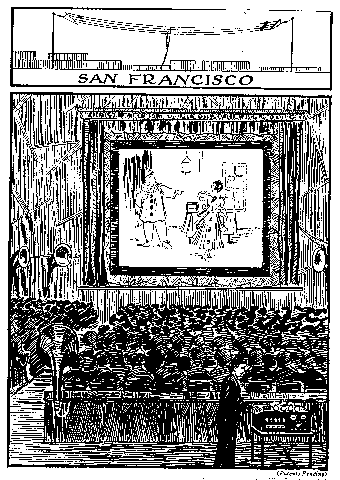 In the September 1919 issue of Radio Amateur News, Hugo Gernsback suggested a mechanism for “Grand Opera by Wireless” that preserved the visual element. An opera would be shot on film, the film would be distributed to cinemas and to a radio studio, all the films would start at the same moment, and the singers would lip-synch to their performances into radio microphones and be heard live in each cinema. Gernsback concluded, “The writer confidently expects that this scheme will be in use thruout the country very shortly,” but there’s no indication it was ever implemented. “Tableau Vivant,” however, in that 1929 article, had another suggestion.
In the September 1919 issue of Radio Amateur News, Hugo Gernsback suggested a mechanism for “Grand Opera by Wireless” that preserved the visual element. An opera would be shot on film, the film would be distributed to cinemas and to a radio studio, all the films would start at the same moment, and the singers would lip-synch to their performances into radio microphones and be heard live in each cinema. Gernsback concluded, “The writer confidently expects that this scheme will be in use thruout the country very shortly,” but there’s no indication it was ever implemented. “Tableau Vivant,” however, in that 1929 article, had another suggestion.
 Earlier this year, I attended a production of the opera Madama Butterfly in the small city (population less than 25,000) of Rolling Meadows, Illinois, not far from Chicago’s O’Hare airport. I was impressed by how the title character and her maid, Suzuki, moved in a believably Japanese manner, including those fluid kneeling and rising motions that my body won’t even try anymore. The sets and costumes were beautifully executed, and they were lit superbly. As for the voices, what can I say? Butterfly was performed by the great Renata Tebaldi, in her prime! Incidentally, she died in 2004 at age 82.
Earlier this year, I attended a production of the opera Madama Butterfly in the small city (population less than 25,000) of Rolling Meadows, Illinois, not far from Chicago’s O’Hare airport. I was impressed by how the title character and her maid, Suzuki, moved in a believably Japanese manner, including those fluid kneeling and rising motions that my body won’t even try anymore. The sets and costumes were beautifully executed, and they were lit superbly. As for the voices, what can I say? Butterfly was performed by the great Renata Tebaldi, in her prime! Incidentally, she died in 2004 at age 82.
No, I was not at a séance, nor was I watching a movie or television production, fulfilling Thomas Edison’s vision, quoted in The Century Magazine in 1894: “I believe that in coming years grand opera can be given at the Metropolitan Opera House in New York with artists and musicians long since dead.” I was watching a live production — well, visually live. The Opera in Focus team of puppeteers and technicians was creating a live performance based on recorded sound.
Let me be clear that I was not watching a puppet opera. Puppet operas were written to be performed by puppets. One of those, Il Girello (The Walker), opened in Florence in 1670, and I can’t say it was the first. Eszterháza, the palace where Joseph Haydn was composer-in-residence, had both an opera theater and a puppet-opera theater. Haydn was formally introduced to Empress Maria Theresa in 1773 when she attended the composer’s puppet opera Philemon und Baucis.
 The tradition has been somewhat updated. In 2010, Gizmodo.com ran the headline, “Robot Opera Is Less Madame Butterfly, More ‘Oops I Dropped a Butterfly Screw.’” The story was about what some called “the first robot opera,” Death and the Powers by Tod Machover, who heads the Opera of the Future group at Massachusetts Institute of Technology. I like the story and what I’ve heard and seen of recordings of its performances, but calling it the “first” robot opera ignores such earlier works as Gary Xaoui’s Foibles Mench.
The tradition has been somewhat updated. In 2010, Gizmodo.com ran the headline, “Robot Opera Is Less Madame Butterfly, More ‘Oops I Dropped a Butterfly Screw.’” The story was about what some called “the first robot opera,” Death and the Powers by Tod Machover, who heads the Opera of the Future group at Massachusetts Institute of Technology. I like the story and what I’ve heard and seen of recordings of its performances, but calling it the “first” robot opera ignores such earlier works as Gary Xaoui’s Foibles Mench.
Robots and puppets seem to have three main functions in opera. One is operas written for them, from that 1670 puppet opera to this year’s Casparo, Luc Steels’s robot opera presented by Vrije Universiteit Brussel’s Artificial Intelligence Lab.
Another is as a stage effect or convenience. Productions of Siegfried, for example, often use a puppet or robot to depict the dragon; the production I attended of Xavier Montsalvatge’s El Gato Con Botas (Puss in Boots) used puppets for many of the characters; the Metropolitan Opera’s current production of Madama Butterfly has a puppet as the child.
The Opera in Focus Madama Butterfly I saw in Rolling Meadows, however, is more from a third purpose of puppets (or robots) in opera: providing a visual element for sound-only media. That’s what “Tableau Vivant” had in mind in the article, “Gramophone-Opera with a Model Stage.” The writer actually suggested that listeners to opera recordings should build their own model stages to have something to watch. That’s also what The New York Times covered in their 1938 story headlined “Marionettes Act Out Radio Opera,” in a performance for children unable to leave St. Vincent’s Hospital.
Before that marionette-assisted radio transmission of The Barber of Seville from the Metropolitan Opera, and even before the “Tableau Vivant” suggestion of model stages for recording listeners, however, there was Ernest Wolff, who was so moved when he attended a performance of Carmen that he built quite an elaborate puppet opera theater in his basement. Reports vary as to his age at the time and the exact moment he carved his first opera puppet, but he seems to have been 12, and it was probably in 1926 (see http://bit.ly/PuppetOpera).
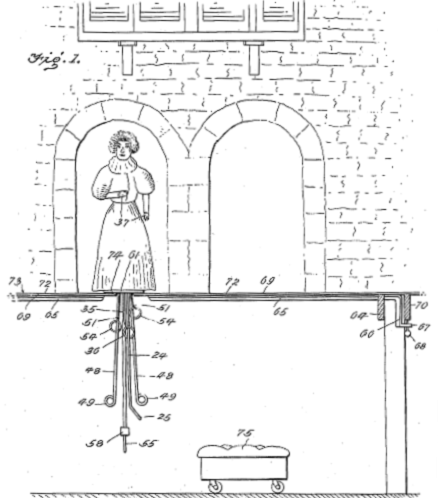 His facility grew more elaborate, and it started touring. The Gas Industries of America and RCA Victor sponsored a six-month engagement of his Miniature Opera Company at the 1939 World’s Fair, with 840 performances of six operas. He and his mother were granted U.S. patent 2,327,234 for an elaborate system of under-stage puppet control, including rolling stools for the puppeteers. Before joining the U.S. Army to serve in World War II, Wolff agreed to lend the owner of Chicago’s Kungsholm restaurant, who wanted to establish a puppet-opera theater, some puppets and scenery.
His facility grew more elaborate, and it started touring. The Gas Industries of America and RCA Victor sponsored a six-month engagement of his Miniature Opera Company at the 1939 World’s Fair, with 840 performances of six operas. He and his mother were granted U.S. patent 2,327,234 for an elaborate system of under-stage puppet control, including rolling stools for the puppeteers. Before joining the U.S. Army to serve in World War II, Wolff agreed to lend the owner of Chicago’s Kungsholm restaurant, who wanted to establish a puppet-opera theater, some puppets and scenery.
The ongoing story involves a lawsuit, a fire, another patent (3,229,411, issued to William B. Fosser, who also began doing opera puppetry in his teens), and at least two more teen-aged opera puppeteers. To cut it short, the Opera in Focus production of Madama Butterfly I saw this year has roots in the 1920s in Wolff’s basement. I recommend it highly.
Here are some links to learn more:
Popular Science, April 1940: http://blog.modernmechanix.com/boys-hobby-creates-puppet-opera/
Popular Mechanics, September 1952: http://books.google.com/books?id=jNwDAAAAMBAJ&pg=PA81
Opera in Focus history section: http://operainfocus.com/history/index.html
Short video made by WTTW: http://video.wttw.com/video/1856703560
Comment:
I just (2013 November 12) learned that The Era got the name of the writer of a letter about listening to opera at home by telephone in 1880 wrong. It was William Sleep Hearder, not Hearden (the 1901 UK census made the same error). Just as Fry was an editor, publisher, playwright, impresario, and rescuer, Hearder was a medical student, electrical engineer, seller of fishing tackle, curator of fish, reptiles, and amphibia, and lecturer on such topics as wireless telegraphy.
But I still don’t know who came first!
61. Opera and Radioactive Music (2013 July 21)
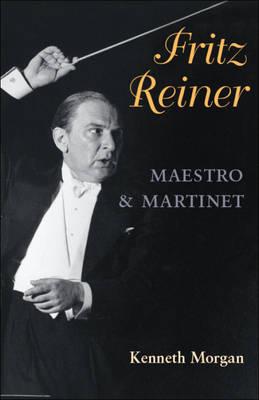 According to the book Fritz Reiner, Maestro and Martinet by Kenneth Morgan (University of Illinois Press 2010), the conductor “experimented with television as an aid to opera performances in Cincinnati in 1928….” Morgan’s source for this information is Reiner’s obituary in The New York Times, published November 16, 1963. The Times was wrong; it didn’t happen. If it had, Reiner might not have lived to be almost 75 years old.
According to the book Fritz Reiner, Maestro and Martinet by Kenneth Morgan (University of Illinois Press 2010), the conductor “experimented with television as an aid to opera performances in Cincinnati in 1928….” Morgan’s source for this information is Reiner’s obituary in The New York Times, published November 16, 1963. The Times was wrong; it didn’t happen. If it had, Reiner might not have lived to be almost 75 years old.
This October I will celebrate 40 years of working in media technology for opera. In that time, I’ve helped develop some new systems and techniques. What I considered one of the least of those was something I did for the Opera Company of Philadelphia, performing at the Academy of Music there. The prompter’s box cover was getting in the way of camera shots. The prompter said a lower cover would be fine for prompting if there were a way to see the stage. I went to a nearby electronics shop, bought a small TV set, “jeeped” it for a video input, and fed it the signal from a stage-wide camera. The prompter and TV director were both happy, and, within days, I started getting calls from prompters around the country who wanted their own video screens.
Not being an opera prompter, I cannot offer a judgment on the value of that video screen. But there’s another form of video monitoring — the one with which Reiner supposedly experimented in 1928 — that has had enormous impact on opera performance. It’s the conductor monitor.
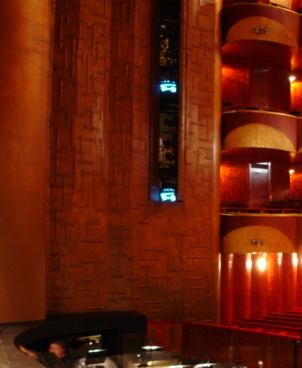 When I first set foot on the stage of the Metropolitan Opera in 1973, I was struck by the appearance of four video screens. They were invisible to the audience but visible to singers anywhere on stage. They were fed by a camera aimed at the conductor.
When I first set foot on the stage of the Metropolitan Opera in 1973, I was struck by the appearance of four video screens. They were invisible to the audience but visible to singers anywhere on stage. They were fed by a camera aimed at the conductor.
Before the introduction of the conductor monitor, singers had to keep glancing at the conductor in the center of the orchestra pit to get their musical cues. They could have been playing a love scene but would spend as much time looking at the maestro as at their supposed inamorata. The conductor monitor changed all that. No matter where singers faced, there could be a visible image of the conductor. 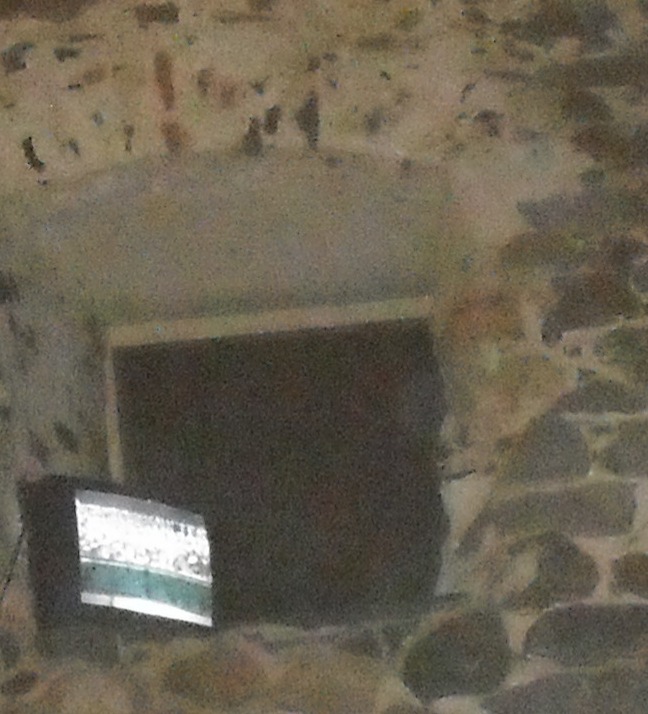 I’ve seen the monitors almost everywhere opera is performed — even in a 15th-century castle.
I’ve seen the monitors almost everywhere opera is performed — even in a 15th-century castle.
Strangely, newer technology has not been helpful. Tube-based cameras and monitors offered essentially instantaneous images. Latencies in some chip-based cameras and LCD monitors can be too great for proper cueing, which is why many modern opera houses still use old picture tubes.
There were conductor monitors in the “new” Metropolitan Opera House when it opened in 1966 but not in the old one. The New York State Theater had niches for conductor monitors when it opened in 1964. BBC Engineering Division Monograph 40 on “The Broadcasting of Music in Television,” published in February 1962, devotes an entire section (3.7.2) to “The Conductor’s Camera” for opera. Even before that, NBC Opera Theatre used conductor monitors; the orchestra was in a different studio from the singers (the BBC sometimes used a large studio with the orchestra at a different end from the singers). Incidentally, both the BBC and NBC used the monitors to cue assistant conductors called repetiteurs. According to the monograph, “By these means, perfect synchronism can be achieved between orchestra and artists, regardless of their movement, and the risk of serious time-lag, which is almost inevitable if the orchestra is at the other end of the same studio, is eliminated.”
Was NBC the first to implement the conductor monitor? I don’t know. But I know where the idea came from. It was opera conductor Fritz Reiner in Cincinnati in 1928.
The Cincinnati Opera (which performed at the city’s zoo before 1972) is the second oldest in the United States, and their archives are at the Public Library of Cincinnati and Hamilton County. Thanks to the company and the librarians, I know that Fritz Reiner never conducted the Cincinnati Opera. But he did conduct the Cincinnati Symphony Orchestra.
On November 17, 1928, the CSO was scheduled to perform Mahler’s second symphony. Here’s an excerpt from a story that appeared in the Cincinnati Commercial Tribune on September 4 of that year:
“The last movement requires not only the use of chorus, soloists, organ, and orchestra, but also of a small orchestra back stage. According to the instructions of the composer, printed upon the score, ‘the sound of this orchestra must reach the listener only like a faint, almost inaudible breath of music, carried to his ears only occasionally by the gentle sigh of the wind.’”
The article explained Reiner’s plan to install the off-stage musicians in their own room, where microphones on the main stage would bring in the sound of the full orchestra, and the musicians would “face a screen upon which the image of the conductor will be thrown.” The use of video was considered not merely a breakthrough in music performance:
“Television has already passed the experimental stage and is an assured development of the radio field. But until Mr. Reiner’s plans were announced, no definitely practical use had been made of the discovery.”
It was a big deal. Here’s an excerpt from a story sent nationally on October 12 (this version appeared in the Niagara Falls Gazette):
“While Fritz Reiner, conductor of the Cincinnati Symphony Orchestra, will be conducting his musicians on the stage of the concert hall here, he will also appear before a smaller orchestra far removed from the first and separated by thick walls. Thus one man will appear in two places at the same time. The catch is that while Reiner will direct one orchestra in person he will appear before the other by television. Reiner’s will be the first attempt to make use of television in the production of a difficult symphony.”
When the actual November 17 concert was reviewed in The Cincinnati Enquirer the next day, however, there was no mention of television. It was a lucky break for Reiner and the musicians.
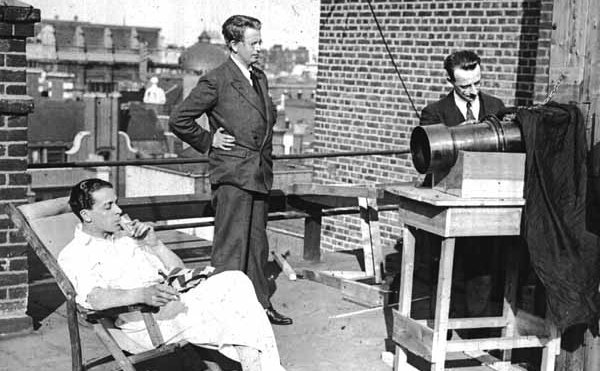 In 1928, television was considerably more primitive than it is today. Earlier that year, video pioneer John Logie Baird had finally achieved sufficient camera sensitivity for pictures to be shot in noon-time sunshine. Before that, there were two alternatives. One was artificial lighting so intense that it could set hair on fire. The other was “flying-spot” scanning.
In 1928, television was considerably more primitive than it is today. Earlier that year, video pioneer John Logie Baird had finally achieved sufficient camera sensitivity for pictures to be shot in noon-time sunshine. Before that, there were two alternatives. One was artificial lighting so intense that it could set hair on fire. The other was “flying-spot” scanning.
A carbon-arc lamp, of the sort used in movie projectors, would generate a tiny but intense spot of light that would be scanned across the scene like a later electron beam in a picture tube. In an exoneration of the visual theory of the ancient Greek philosopher Empedocles, light actually did emerge from the camera. After bouncing off the scene, it would be captured by banks of photocells.
Unfortunately, any light in the studio other than that emerging from the camera would also be picked up by the photocells, messing up the picture. So studios had to be dark except for their scanning light beam.
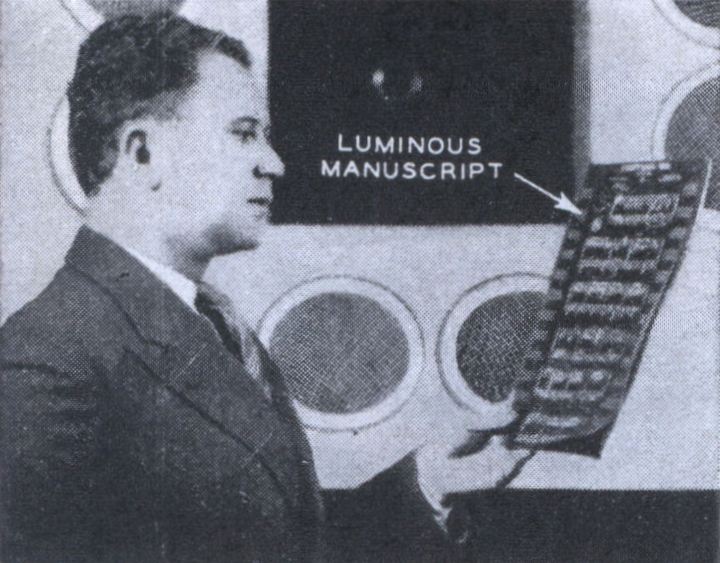 How could musicians read the score in such conditions? The April 1932 issue of Modern Mechanix and Inventions offered a solution:
How could musicians read the score in such conditions? The April 1932 issue of Modern Mechanix and Inventions offered a solution:
“To remedy this difficulty and enable the performers to see better the music manuscripts from which they are singing, Elliott Jaffe, a New York recording artist, has devised a luminous manuscript on which the characters are painted on black paper with radium paint.”
Yikes!
62. Opera and Outer Space (2013 August 1)
Earlier this week, I was listening to NPR’s Morning Edition as they did a story on social-media-using astronaut Chris Hadfield of the Canadian Space Agency. They played a YouTube video called “How to Cook Spinach in Space” <http://www.youtube.com/watch?v=iGiQZIb34_s>, and I heard “La donna è mobile” from the opera Rigoletto (the aria that created broadcast rights).
Opera in outer space? Not in that particular instance. The music was added in the editing of the video, apparently by someone who associates opera with cooking. But there is a long history of opera and space.
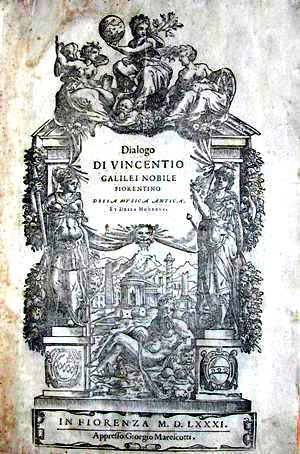 It began, perhaps, in the early 17th century, when astronomer Johannes Kepler undertook a long journey to defend his mother from charges of witchcraft (she lost the case, but the punishment was merely the threat of torture, not torture itself). Kepler had previously come up with his first two laws of planetary motion but not the third, the one that makes modern communications and broadcast satellites possible (not to mention the orbit of Hadfield’s International Space Station).
It began, perhaps, in the early 17th century, when astronomer Johannes Kepler undertook a long journey to defend his mother from charges of witchcraft (she lost the case, but the punishment was merely the threat of torture, not torture itself). Kepler had previously come up with his first two laws of planetary motion but not the third, the one that makes modern communications and broadcast satellites possible (not to mention the orbit of Hadfield’s International Space Station).
Kepler took a book to read on his long trip and soon published his third law, in a book sometimes called The Music of the Spheres, and he credited the book he read with giving him the idea for the law. The book he read was Vincenzo Galilei’s Dialogues on Ancient and Modern Music, often considered the first opera book, which outlined the principles of opera.
Then there are opera signals in space. SETI, the search for extra-terrestrial intelligence, is a project that uses giant antennas to “listen” for signs of intelligent life. If those life forms are doing the same thing, and if they point their antennas in the correct direction, they could pick up broadcast opera transmissions as early as 1907 (reaching a radius more than a hundred light years away by now). If their equipment is really, really, really sensitive, it might even pick up the signals from “Largo al factotum,” an aria from The Barber of Seville, transmitted over a telephone line in 1877.
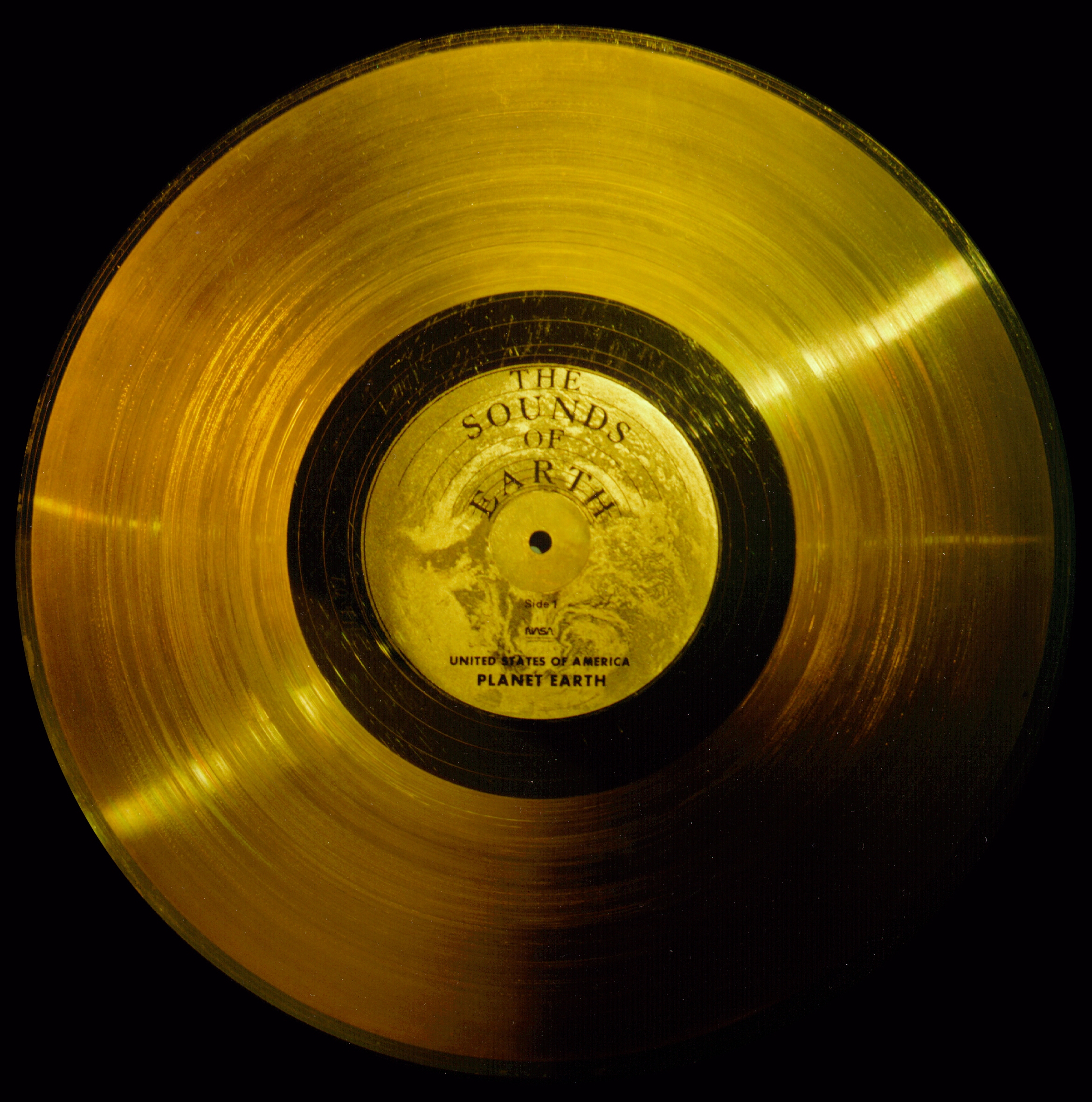 That’s a lot of required sensitivity. So how about interstellar opera disc delivery? That’s in progress.
That’s a lot of required sensitivity. So how about interstellar opera disc delivery? That’s in progress.
In 1977, two Voyager spacecraft were launched, each carrying a golden record. The records were intended to be played like old phonograph LPs, except at 16-2/3 rpm instead of 33-1/3. After greetings in many languages, the next section begins with Laurie Spiegel’s version of Kepler’s Music of the Spheres. The section after that includes Edda Moser singing the Queen of the Night’s aria from The Magic Flute (I wonder if that intelligent life form will realize that the aria, though beautiful, is one of the most vindictive, beginning with the words “Hell’s vengeance boils in my heart” and inciting murder). The disc also includes a color photo of the Sydney Opera House.
In another 40,000 years or so, Voyager 1, currently almost 18 billion kilometers from the sun, will get within 1.6 light years of AC+79 3888, a star in the constellation Camelopardalis. In less than 300,000 years, Voyager 2 should be just 4.3 light years from Sirius. Who says opera doesn’t have outreach?
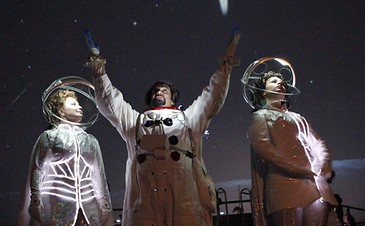 Back here on Earth, space travel has figured in two recent opera projects, The Astronaut’s Tale and The Three Astronauts. Way back in the 20th century The Voyage premiered at the Metropolitan Opera on October 12, 1992, the 500th anniversary of the fateful trip of Columbus. In the first act, a character called the Commander tries to pilot an out-of-control spacecraft. And in 2010 Gotham Chamber Opera performed Il mondo della luna (The World of the Moon), a 1777 opera by Joseph Haydn, at New York’s Hayden Planetarium at the Rose Center for Earth & Space <http://www.gothamchamberopera.org/production/detail/il_mondo_della_luna>.
Back here on Earth, space travel has figured in two recent opera projects, The Astronaut’s Tale and The Three Astronauts. Way back in the 20th century The Voyage premiered at the Metropolitan Opera on October 12, 1992, the 500th anniversary of the fateful trip of Columbus. In the first act, a character called the Commander tries to pilot an out-of-control spacecraft. And in 2010 Gotham Chamber Opera performed Il mondo della luna (The World of the Moon), a 1777 opera by Joseph Haydn, at New York’s Hayden Planetarium at the Rose Center for Earth & Space <http://www.gothamchamberopera.org/production/detail/il_mondo_della_luna>.
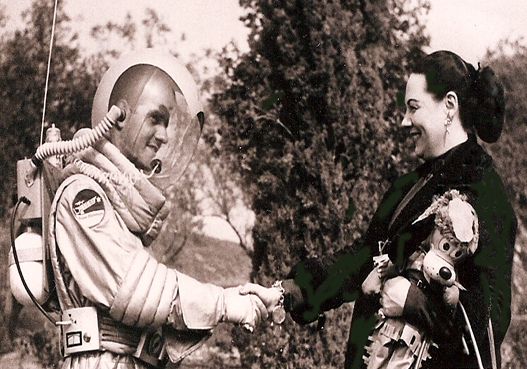 Then there’s opera diva Renata Tebaldi’s handshake, pictured in a web story about the high-definition opera transmissions to cinemas, on which I work. Those transmissions make use of spacecraft orbiting 35,786 kilometers above the equator, the distance that Kepler’s opera-inspired third law of planetary motion said would allow them to appear stationary in the sky. As for that handshake, depicted here <http://operavision.org/2007/09/03/renata-and-the-astronaut/>, well, they’re both smiling.
Then there’s opera diva Renata Tebaldi’s handshake, pictured in a web story about the high-definition opera transmissions to cinemas, on which I work. Those transmissions make use of spacecraft orbiting 35,786 kilometers above the equator, the distance that Kepler’s opera-inspired third law of planetary motion said would allow them to appear stationary in the sky. As for that handshake, depicted here <http://operavision.org/2007/09/03/renata-and-the-astronaut/>, well, they’re both smiling.
63. Opera, the Navy, and Radio (2013 August 16)
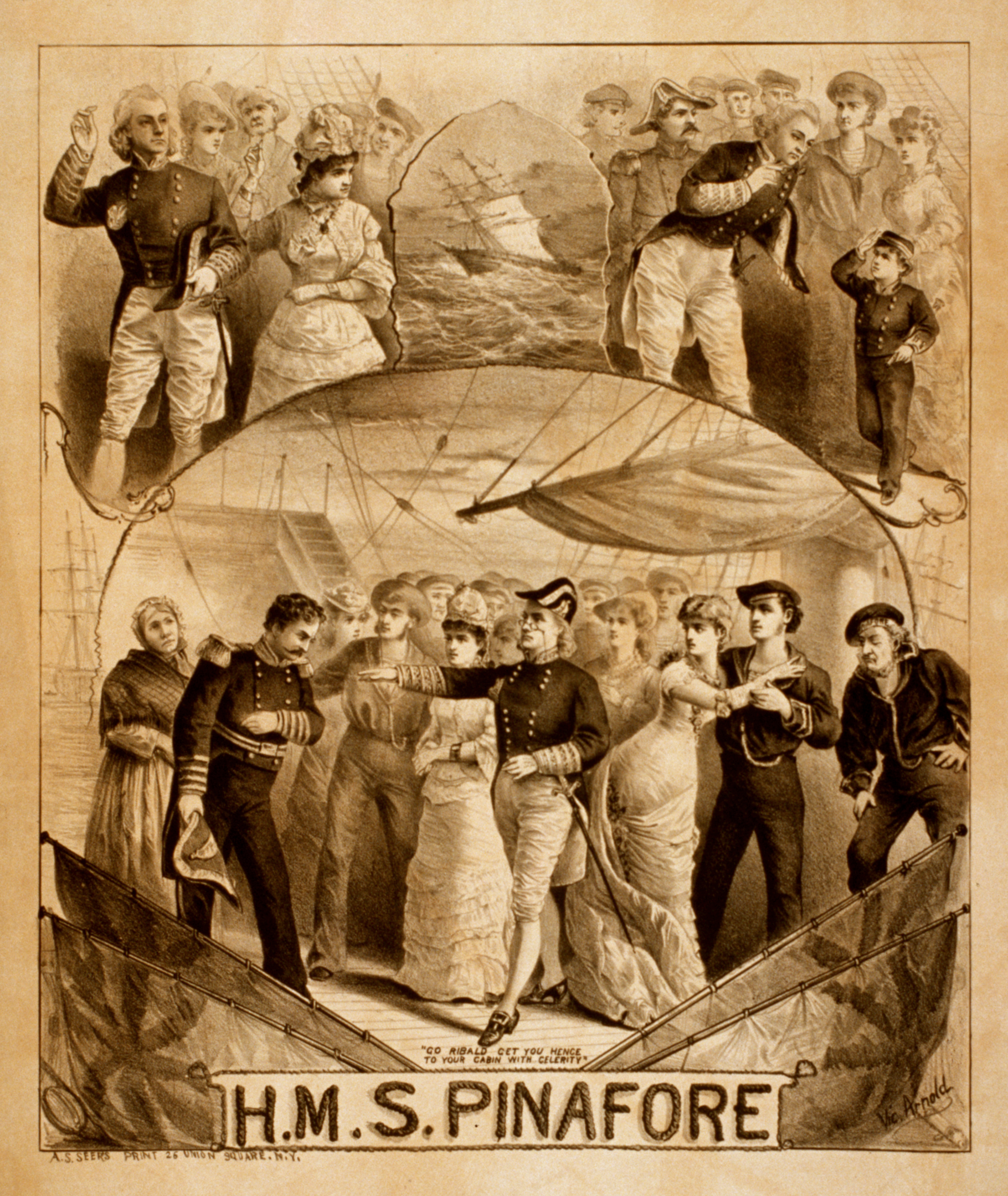 There are many connections between opera and the Navy. A principal character in Madama Butterfly is Lieutenant Benjamin Franklin Pinkerton of the U.S. Navy. The H.M.S. Pinafore is a British naval vessel. In Les Troyens a naval fleet carries the survivors of Troy. Daron Hagen’s opera Amelia incorporates the Navy Hymn (and is about a Navy pilot). Copenhagen’s new opera house is located on a former Danish naval base. The U.S. Naval Academy’s music department often performs what they call “A Night at the Opera” with the Annapolis Symphony. In the movie A Night at the Opera, thanks to the crazed action, a battleship backdrop appears during a performance of Il trovatore. Episode 11 of season 4 of the TV comedy McHale’s Navy is called “The McHale Opera Company.” Those attending “Opera in the Outfield” at Washington’s Nationals Park can take the Metro to the Navy Yard station. The Hai-kuang Peking Opera Troupe was created by Taiwan’s navy. During World War II, Franklin Delano Roosevelt referred to the Italian navy as a “bunch of opera singers” (which seems to me to be high praise).
There are many connections between opera and the Navy. A principal character in Madama Butterfly is Lieutenant Benjamin Franklin Pinkerton of the U.S. Navy. The H.M.S. Pinafore is a British naval vessel. In Les Troyens a naval fleet carries the survivors of Troy. Daron Hagen’s opera Amelia incorporates the Navy Hymn (and is about a Navy pilot). Copenhagen’s new opera house is located on a former Danish naval base. The U.S. Naval Academy’s music department often performs what they call “A Night at the Opera” with the Annapolis Symphony. In the movie A Night at the Opera, thanks to the crazed action, a battleship backdrop appears during a performance of Il trovatore. Episode 11 of season 4 of the TV comedy McHale’s Navy is called “The McHale Opera Company.” Those attending “Opera in the Outfield” at Washington’s Nationals Park can take the Metro to the Navy Yard station. The Hai-kuang Peking Opera Troupe was created by Taiwan’s navy. During World War II, Franklin Delano Roosevelt referred to the Italian navy as a “bunch of opera singers” (which seems to me to be high praise).
I could go on, but none of those connections had much to do with media technology. When it comes to radio, however, there was a much more important relationship between opera and the Navy.
 “Radio” was, for many decades, Wall Street shorthand for RCA, a conglomerate that at one time owned Banquet frozen foods, Coronet carpets, Gibson greeting cards, Hertz rent-a-car, and Random House publishing, among other brands. It also completely absorbed Victor, the recording and player company that had bet its very existence on opera. Through its NBC arm RCA paid for the first (and many other) operas commissioned both for radio and for television and operated both radio and television opera companies. It sponsored a puppet-opera exhibit at the 1939 New York World’s Fair, and it paid for nationwide opera tours of both those puppet operas and the kind with full-sized human performers.
“Radio” was, for many decades, Wall Street shorthand for RCA, a conglomerate that at one time owned Banquet frozen foods, Coronet carpets, Gibson greeting cards, Hertz rent-a-car, and Random House publishing, among other brands. It also completely absorbed Victor, the recording and player company that had bet its very existence on opera. Through its NBC arm RCA paid for the first (and many other) operas commissioned both for radio and for television and operated both radio and television opera companies. It sponsored a puppet-opera exhibit at the 1939 New York World’s Fair, and it paid for nationwide opera tours of both those puppet operas and the kind with full-sized human performers.
RCA stood for Radio Corporation of America, a name seemingly like United States Steel and perhaps more modest than Continental Can, Hemisphere Engineering, Global Security, or Universal Pictures. But there was more to RCA’s “of America” than that. The company was created by the U.S. Navy in the name of national security.
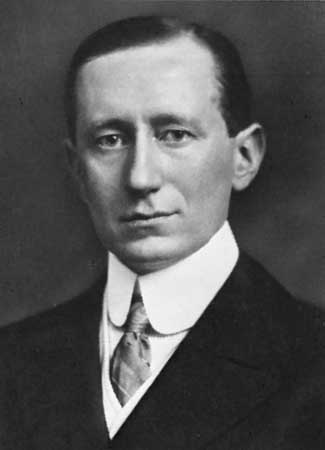 It all began, as do many intersections of the histories of media technology and opera, towards the end of the 19th century. Guglielmo Marconi began experiments in wireless communication with the help of his servant, Mignani, at his home, the Villa Griffone in Pontecchio. Does that seem like the opening line of an opera synopsis? Marconi wasn’t the first to demonstrate some form of wireless electronic telegraphy, but he was the first to commercialize it, in a British-based company.
It all began, as do many intersections of the histories of media technology and opera, towards the end of the 19th century. Guglielmo Marconi began experiments in wireless communication with the help of his servant, Mignani, at his home, the Villa Griffone in Pontecchio. Does that seem like the opening line of an opera synopsis? Marconi wasn’t the first to demonstrate some form of wireless electronic telegraphy, but he was the first to commercialize it, in a British-based company.
Meanwhile, navies were always looking for improved forms of communications. At very close range, a shouted “Ahoy!” might suffice; at somewhat longer distances, it could be amplified by a megaphone. For even longer distances, there were visual communications. Homer’s Iliad reports the use of a flame aboard Agamemnon’s ship to signal the start of the invasion of Troy; Herodotus told of fire signals used by the Greek fleet during the invasion by Xerxes. The Egyptian and Roman navies used mirrors to reflect sunlight for signaling. King James II, when he was Duke of York, introduced signal flags to the British Navy shortly after the first commercial opera house opened. But visual communications are limited, too. The horizon, to someone standing at sea level, is less than 5 km away, and no telescope can increase that range. A tall mast communicating with a tall tower might extend that to a few dozen km. During the U.S. Civil War a Union ship tried projecting signals on a cloud. Before the end of the 19th century, an instructor at the U.S. Naval Academy went to Belgium to study and develop rules for the use of homing pigeons. But, essentially, a ship in mid-ocean was on its own.
 That’s why the U.S. Navy eagerly participated in wireless-telegraphy demonstrations conducted by Marconi beginning October 26, 1899 (some publications say Lieutenant [later Rear Admiral] Bradley A. Fiske began such work more than a decade earlier). The Navy was sufficiently impressed to request a price, but the newly formed Marconi Wireless Telegraph Company of America (American Marconi) was not inclined to sell. Instead, it wanted to own the equipment and offer only long-term leases at rates the Navy found exorbitant. So the Navy looked elsewhere, and, lacking its largest likely customer, American Marconi (incorporated November 22, 1899) didn’t turn a profit until 1914, after it changed its policy.
That’s why the U.S. Navy eagerly participated in wireless-telegraphy demonstrations conducted by Marconi beginning October 26, 1899 (some publications say Lieutenant [later Rear Admiral] Bradley A. Fiske began such work more than a decade earlier). The Navy was sufficiently impressed to request a price, but the newly formed Marconi Wireless Telegraph Company of America (American Marconi) was not inclined to sell. Instead, it wanted to own the equipment and offer only long-term leases at rates the Navy found exorbitant. So the Navy looked elsewhere, and, lacking its largest likely customer, American Marconi (incorporated November 22, 1899) didn’t turn a profit until 1914, after it changed its policy.
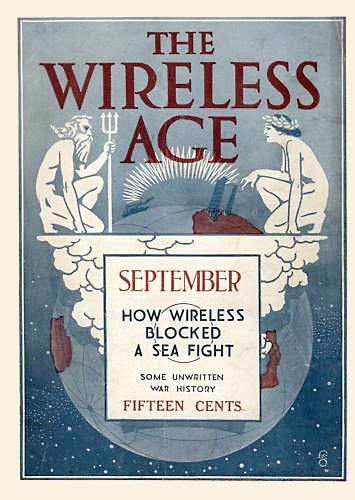 That year, there was a public feud between the Navy and American Marconi, printed in an exchange of letters in The Wireless Age. With the U.S. claiming neutrality in the Great War, President Woodrow Wilson ordered Secretary of the Navy Josephus Daniels to censor wireless communications. Of all the carriers, only American Marconi refused to obey and even delivered a message from a British cruiser at one station. The Navy ordered the station shut down. American Marconi asked “if you are prepared to carry out your order by force” but then thought better of the confrontation and sent the following: “The Marconi Company withdraws the letter previously sent and the station was closed at 1:00 P.M.”
That year, there was a public feud between the Navy and American Marconi, printed in an exchange of letters in The Wireless Age. With the U.S. claiming neutrality in the Great War, President Woodrow Wilson ordered Secretary of the Navy Josephus Daniels to censor wireless communications. Of all the carriers, only American Marconi refused to obey and even delivered a message from a British cruiser at one station. The Navy ordered the station shut down. American Marconi asked “if you are prepared to carry out your order by force” but then thought better of the confrontation and sent the following: “The Marconi Company withdraws the letter previously sent and the station was closed at 1:00 P.M.”
When the U.S. entered the war, it effectively nationalized all radio patents and took over the operation of all wireless communications in the country. After that war, the Navy was concerned about the next one. What if Britain were on the other side? So Navy officers proposed a plan to General Electric that would start with GE’s refusing to sell important parts to Marconi, continue through a takeover of American Marconi, and end up with the formation of RCA, with GE, Westinghouse, AT&T, and United Fruit (which used wireless communications on its banana boats) as the initial stockholders. RCA was thus incorporated on October 17, 1919.
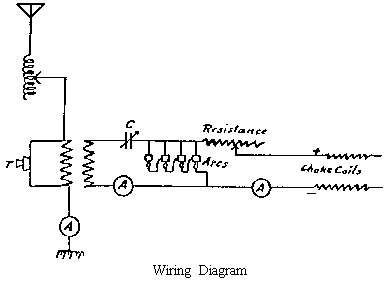 What did the U.S. Navy do with opera before 1919? Consider this report from the April 1912 issue of Electrician and Mechanic, regarding the testing of radio equipment aboard the U.S.S. Ordnance using the Anvil Chorus from Il Trovatore, a selection that “proved to be a very effective record for fluctuating the ammeters, which was a desired feature.” After playing the same record over and over, the ship received a message from a shore station: “For —— sake change the tune.”
What did the U.S. Navy do with opera before 1919? Consider this report from the April 1912 issue of Electrician and Mechanic, regarding the testing of radio equipment aboard the U.S.S. Ordnance using the Anvil Chorus from Il Trovatore, a selection that “proved to be a very effective record for fluctuating the ammeters, which was a desired feature.” After playing the same record over and over, the ship received a message from a shore station: “For —— sake change the tune.”
During the war, a Marconi facility in New Jersey became naval station NFF, which was soon, at 200,000 watts, the world’s most powerful (it transmitted terms of surrender directly to Germany). It was tested by using lines from the New Brunswick Opera House to see how far away performances could be heard. Good opera reception was reported aboard the U.S.S. George Washington at a distance of 2,000 miles (it was also heard in South Dakota). A naval opera transmission in 1919 led the Chicago Tribune to declare, “The high cost of opera has been solved.”
Marconi’s original wireless transmissions were bursts of static representing dots and dashes. How did the Navy get from those to opera’s voice and instrumental music?
It seems likely that speech was transmitted by radio no later than 1900 (there had been earlier inductive wireless transmissions). As for music, the legendary Christmas Eve 1906 broadcast by Reginald Fessenden included portions of Handel’s opera Serse (Italian for the Xerxes of naval communications fame); unfortunately, radio-historian James O’Neal has suggested that broadcast never happened — at least not at that time.
In the January 1955 issue of The American Swedish Monthly, there was an article titled “I Was First to Sing Over the Radio” by soprano Eugenia H. Farrar. It included images of autographed photos. One, signed by radio-pioneer Lee de Forest, is inscribed, “To Mme. Eugenia Farrar who was the first human being to sing over the Radio October 1907.” Another (above), signed by de Forest assistant Frank Butler, shows equipment and is inscribed, “It was this sort of equipment and through these two headphones that the voice of Madame Farrar was heard at Brooklyn Navy Yard in October 1907 — she being the first woman to sing over The Wireless Telephone.”
According to the story, a wireless operator on a Navy ship heard her voice that night, amid the bursts of static, decided it must be the sound of “angels,” and notified the officer on duty, who, in turn, phoned The New York Herald, which carried an item about “angels singing in the air.”
Farrar’s next line in the article is, “Well, that is the story.” Indeed, it is. The veracity of the story, however, despite the inscribed photographs, is somewhat questionable. Farrar was 80 when she wrote it, and the date on which the photos were inscribed is unknown. There was no mention I could find in any issue of the Herald that month about the Navy hearing “angels singing in the air.” Earlier in 1907, however, there were some interesting opera-Navy-radio tidbits in that newspaper.
On March 1, a story headlined “GRAND OPERA BY WIRELESS” described a transmission to take place that night of an opera concert from Telharmonic Hall to be received at the Yale Club. Apparently, it was a success, because several newspapers reported that de Forest continued such transmissions. And three of them, including the Herald, reported an incident that took place on the evening of March 5; the Herald’s sub-headline was “WAKES UP NAVY.”
Apparently, de Forest conducted his experiments as though no one were listening. “This illusion was summarily dispelled last Tuesday evening when a man dashed into Telharmonic Hall.
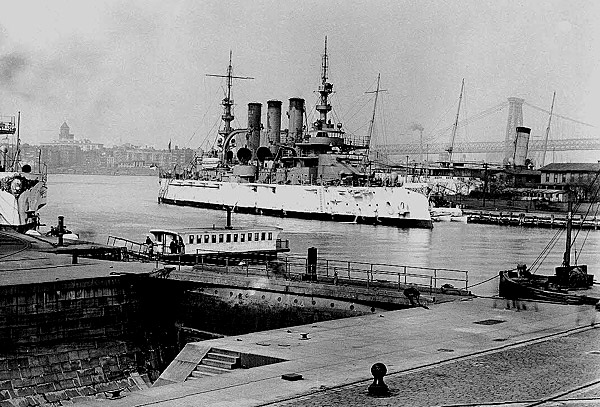 “‘How are you putting this music on the wireless?’ the visitor asked. A diplomatic general denial was forthcoming.
“‘How are you putting this music on the wireless?’ the visitor asked. A diplomatic general denial was forthcoming.
“‘That won’t do,’ was his reply. ‘You can’t fool me. I’m G. S. MacDonald, chief electrician in charge of the wireless station in the Brooklyn Navy Yard, and I know I heard ‘Wilhelm Tell’ and ‘Ave Maria’ over my wireless, and it could not come from anywhere except here.’”
It seems highly unlikely, therefore, that radio operators at the Brooklyn Navy Yard would have been shocked to hear wireless music seven months later. Ah, well.
64. The Tenor, the Impresario, and the Invention of Electronic Home Entertainment (2014 March 11 – updated version of discussion 46)
I recently did a job at the Academy of Music in Philadelphia, where I had previously worked on televising operas with the tenor Luciano Pavarotti. On my way to the opera house, I made a detour to Laurel Hill Cemetery to visit the grave of Edward Plunket Fry.
Electronic home entertainment is surely one of the most significant inventions of the modern age, whether it arrives via smartphone, computer, television, or radio. I can tell you why it was invented: to listen to opera at home. I can also tell you when: 1880. I’m pretty sure it was in November, too. But I can’t tell you who did it or where, because there are two geographically separated but fascinating possibilities.
One was an American, Edward Plunket Fry, born in 1815. With one of his brothers, he took over editing and publishing The National Gazette from his father. It’s still published today, but now it’s called The Philadelphia Inquirer. That explains the “EDITOR” on his headstone [visible in discussion 46 above]. Next to that is “IMPRESARIO.” That’s because he produced operas in both Philadelphia and New York. One was the first English-language version of Bellini’s Norma, one of his brothers having done the translation. The same brother wrote the libretto for Leonora; another brother wrote the music. It’s commonly called the first American grand opera to have been performed; Edward produced it.
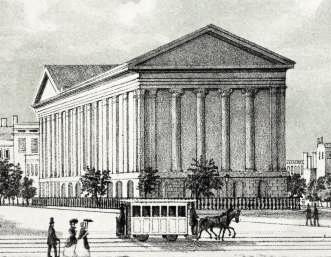 In New York, Fry ran the Astor Opera House. It later became a theater, where, in 1849, the English actor William Macready was performing Macbeth. A few blocks away, the same role was being performed by American Edwin Forrest. Forrest’s fans tried to disrupt Macready’s performances, leading to the deadly Shakespeare riots. Fry saved Macready’s life by spiriting him out an unknown exit. I suppose I should mention that Fry was also a playwright.
In New York, Fry ran the Astor Opera House. It later became a theater, where, in 1849, the English actor William Macready was performing Macbeth. A few blocks away, the same role was being performed by American Edwin Forrest. Forrest’s fans tried to disrupt Macready’s performances, leading to the deadly Shakespeare riots. Fry saved Macready’s life by spiriting him out an unknown exit. I suppose I should mention that Fry was also a playwright.
He successfully sued James Gordon Bennett, founder of The New York Herald. The case was covered in other newspapers as the “Opera Libel Trial.”
Fry is buried between his composer brother and his long-time nurse. In his later years, he was a bed-ridden invalid, unable to attend opera performances. So, in 1880, at his own expense, he had a telephonic connection from New York’s Academy of Music to his bedroom installed, with the permission of Colonel James Henry Mapleson, who ran the opera house and sent Fry libretti.
In his bed, Fry would listen to the opera, read the libretto, and look at photographs of the singers, which he would pat when he thought they sang well and otherwise turn upside down. At the time, there were no loudspeakers, so hearing the opera required pressing a telephone receiver to the ear, which raises a question: Between libretto, photos, and telephone receiver, how many hands did Fry have? If it was the standard two, he probably rigged something to hold the receiver to his ear, inventing not only electronic home entertainment but also the headphone.
 There’s just one problem: William Sleep Hearder of Plymouth, England. Like Fry, Hearder initially followed in his father’s footsteps. Born in 1849, he studied to be a physician, but, according to his obituary in the Illustrated Western Weekly News, the “amateur tenor of no mean repute” “altered his decision, and, when his father died in 1876, he succeeded to the business of scientific apparatus and fishing tackle merchant in Union-street.” He was, among other things, an electrical engineer; a curator of fish, reptiles and amphibians; an author; and a lecturer on such topics as wireless telegraphy (his father had demonstrated an electrical telegraph long before Morse).
There’s just one problem: William Sleep Hearder of Plymouth, England. Like Fry, Hearder initially followed in his father’s footsteps. Born in 1849, he studied to be a physician, but, according to his obituary in the Illustrated Western Weekly News, the “amateur tenor of no mean repute” “altered his decision, and, when his father died in 1876, he succeeded to the business of scientific apparatus and fishing tackle merchant in Union-street.” He was, among other things, an electrical engineer; a curator of fish, reptiles and amphibians; an author; and a lecturer on such topics as wireless telegraphy (his father had demonstrated an electrical telegraph long before Morse).
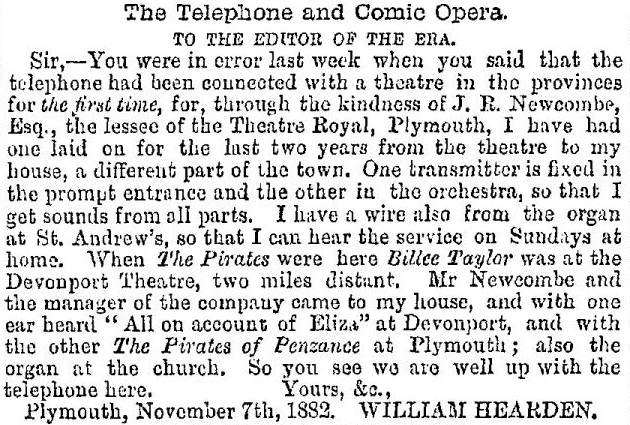 On November 7, 1882, in response to something that had been printed therein regarding the transmission of opera by telephone line, Hearder wrote a letter to the editor of The Era. It was published as coming from William Hearden (the UK census of 1901 had the same error). It said that “through the kindness of J. R. Newcombe, Esq., the lessee of the Theatre Royal, Plymouth, I have had [a telephonic connection] laid on for the last two years from the theatre to my house, a different part of the town. One transmitter is fixed in the prompt entrance and the other in the orchestra, so that I get sounds from all parts.”
On November 7, 1882, in response to something that had been printed therein regarding the transmission of opera by telephone line, Hearder wrote a letter to the editor of The Era. It was published as coming from William Hearden (the UK census of 1901 had the same error). It said that “through the kindness of J. R. Newcombe, Esq., the lessee of the Theatre Royal, Plymouth, I have had [a telephonic connection] laid on for the last two years from the theatre to my house, a different part of the town. One transmitter is fixed in the prompt entrance and the other in the orchestra, so that I get sounds from all parts.”
Does “the last two years” mean November 7, 1880? Fry wrote to Mapleson on November 18 of that year thanking him for allowing Fry to listen to performances (plural). In the letter, Fry summarized his experiences, suggesting they had been going on for some time.
Two people, on opposite sides of the Atlantic Ocean, did roughly the same thing at roughly the same time: listening at home to performances at an opera house. One of them invented electronic home entertainment. I wish I knew which.
65. Inside-Out (2014 April 2)
 People who know me know I wear T-shirts a lot. One of my favorites has an image of a microphone covered by the red slashed-circle “prohibited” symbol. The text says, “Real singers don’t need microphones.”
People who know me know I wear T-shirts a lot. One of my favorites has an image of a microphone covered by the red slashed-circle “prohibited” symbol. The text says, “Real singers don’t need microphones.”
People who know me also know I work at the Metropolitan Opera a lot; I have since 1973. So I am commonly asked whether sound reinforcement is used at the Met. It’s a reasonable question; the large auditorium can accommodate some 4,000 opera goers at once.
My answer is, “mostly no.” Opera composers like Verdi and Wagner didn’t write for microphones, so they aren’t used for what’s heard in the auditorium. The fine acoustics of the opera house bring beautiful sound to each of those opera goers without any amplification.
Still, there are exceptions. A microphone might be used when someone needs to announce a substitution due to illness. There might be a sound effect called for, as in the loudspeaker announcements of the arrival of the hurricane in “The Rise and Fall of the City of Mahagonny.” And composer John Adams actually specified the use of wireless microphones right in the score of “Dr. Atomic.”
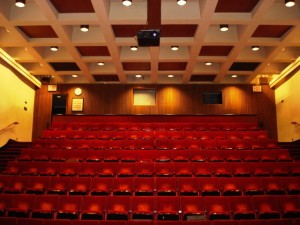 The Met’s sound department deals with those rare occasions of amplification as well as with such everyday uses of sound technology as intercom systems and feeds to latecomer viewing areas. Radio and television use microphones, of course, but those fall under a different Met department, media, which deals with pictures and sounds leaving the house.
The Met’s sound department deals with those rare occasions of amplification as well as with such everyday uses of sound technology as intercom systems and feeds to latecomer viewing areas. Radio and television use microphones, of course, but those fall under a different Met department, media, which deals with pictures and sounds leaving the house.
At the Met, there’s a very clear distinction between inside the opera house and outside it. The same is not true at all of New York City’s 92 opera companies. In 2013, for example, New York Opera Forum performed at nine different venues. And then there are Gotham Chamber Opera and On Site Opera. Both specialize in site-specific opera productions.
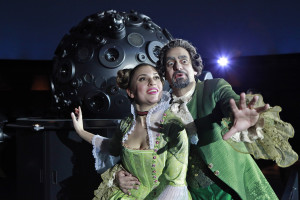 Gotham, for example, performed Haydn’s opera “Il mondo della luna” (“The World of the Moon”) at New York’s Hayden Planetarium, the opera “Eliogabalo,” about the debauched Roman emperor Heliogabalus, in a burlesque club, and “La hija de Rappaccini,” about poisonous plants, outdoors at the BrooklynBotanical Garden. On Site performed Gershwin’s jazz-club opera “Blue Monday” at The Cotton Club. In June, they’ll be doing Rameau’s “Pygmalion.”
Gotham, for example, performed Haydn’s opera “Il mondo della luna” (“The World of the Moon”) at New York’s Hayden Planetarium, the opera “Eliogabalo,” about the debauched Roman emperor Heliogabalus, in a burlesque club, and “La hija de Rappaccini,” about poisonous plants, outdoors at the BrooklynBotanical Garden. On Site performed Gershwin’s jazz-club opera “Blue Monday” at The Cotton Club. In June, they’ll be doing Rameau’s “Pygmalion.”
George Bernard Shaw’s play of that name, the basis of the musical “My Fair Lady,” is about someone turning a street vendor into a refined lady and then falling in love with her; Rameau’s opera is based on the original myth of a sculptor falling in love with his statue, so where better to perform it than in Madame Tussauds Wax Museum? http://osopera.org/productions/pygmalion/
There are challenges to performing operas outside the opera house, especially when literally outside. In 1916, the Metropolitan Opera toured “Siegfried” to ball parks. Thunderstorms cancelled the Chicago performance in what would become known as Wrigley Field. In Forbes Field in Pittsburgh, rain checks were issued after Act II so the fans could attend Act III the next day. At Robison Field in St. Louis, concern about the effect of the stage machinery (which included apparatus for a steam curtain) on the finely groomed grounds led to its location far from the stands. But, in 1916, there were no public-address systems. The conductor gave the downbeat, no one in the audience heard anything, and thousands of fans stormed the field to get closer, dragging chairs and benches with them, creating the very ruin the distant stage position was supposed to eliminate.
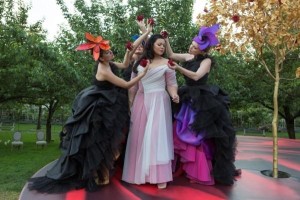 During one of the performances of “Rappaccini,” some generator power problems knocked out both sound amplification and the screens on which translations appeared. This time, the audience didn’t mind. It was relatively quiet in the garden, so the singers could be heard. And a good description in the program of the plot made the action easy to follow. If it were an opera about travel, in a foreign language, being performed in Grand Central Terminal during rush hour, neither hearing nor seeing might have been possible.
During one of the performances of “Rappaccini,” some generator power problems knocked out both sound amplification and the screens on which translations appeared. This time, the audience didn’t mind. It was relatively quiet in the garden, so the singers could be heard. And a good description in the program of the plot made the action easy to follow. If it were an opera about travel, in a foreign language, being performed in Grand Central Terminal during rush hour, neither hearing nor seeing might have been possible.
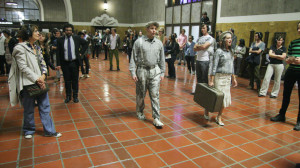 On the other hand, there was an opera performed in Union Station in Los Angeles last year. It was called “Invisible Cities.” It was composed by Christopher Cerrone based on Italo Calvino’s novel about what Marco Polo told Kublai Khan. It was presented by The Industry, Los Angeles Dance Project, and Sennheiser (the audio-equipment company). The opera goers wore wireless headphones through which they could listen to wireless microphones.
On the other hand, there was an opera performed in Union Station in Los Angeles last year. It was called “Invisible Cities.” It was composed by Christopher Cerrone based on Italo Calvino’s novel about what Marco Polo told Kublai Khan. It was presented by The Industry, Los Angeles Dance Project, and Sennheiser (the audio-equipment company). The opera goers wore wireless headphones through which they could listen to wireless microphones.
The libretto (also by Cerrone) was in English, so translated titles weren’t necessary, but there are wireless titles systems, too. Both Figaro Systems in the U.S. and Opera Voice in Italy already have systems to transmit titles to mobile devices like smartphones and tablets. But does that distract the audience from watching the performers?
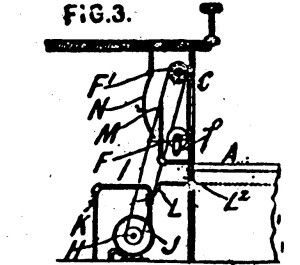 It’s a question that has divided opera goers since the beginning of opera-house titling (subject of a British patent, left, in 1881). The system at the Met uses optical filtering so someone who doesn’t activate the seatback screen will not be distracted by titles appearing on adjacent seatback screens. But, even there, some in the audience have to glance down at a screen and then up at the stage.
It’s a question that has divided opera goers since the beginning of opera-house titling (subject of a British patent, left, in 1881). The system at the Met uses optical filtering so someone who doesn’t activate the seatback screen will not be distracted by titles appearing on adjacent seatback screens. But, even there, some in the audience have to glance down at a screen and then up at the stage.
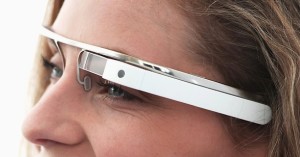 On Site Opera is considering another possibility: Google Glass. Want subtitles? Put them on. Don’t want them? Leave them off. In either case, you can keep your eyes on the performers, whether they’re on an opera stage, in a wax museum, or dodging the rush-hour crowds at Grand Central Terminal.
On Site Opera is considering another possibility: Google Glass. Want subtitles? Put them on. Don’t want them? Leave them off. In either case, you can keep your eyes on the performers, whether they’re on an opera stage, in a wax museum, or dodging the rush-hour crowds at Grand Central Terminal.
66. Opera Streamed in Beyond-HDTV Resolution (2014 May 5)
The first commercial digital sound recording was of an opera. The first live television subtitles were for opera. And, now, live 4k opera streamed over the Internet.
At 7 pm Central European Time on Wednesday, May 7, the Wiener Staatsoper (Vienna State Opera) will transmit Verdi’s opera Nabucco, with Placido Domingo in the title role. Elemental Technologies’ high-efficiency video coding (HEVC) will be used to stream the event over the Internet in 4k resolution, using MPEG-DASH, for viewing around the world. It will also be sent to a 65” Samsung UHD TV at the opera house. A Wiener Staatsoper app with built-in time shifting will allow users to view it live or at 7 pm in their local time zone.
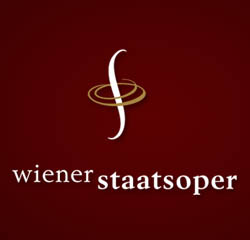 Wiener Staatsoper produces more than 40 live broadcasts annually and is making almost all of its 2014/2015 season productions accessible to viewers via the Internet on smart TVs and mobile devices. “Our multicreen offer, VOD [video-on-demand] services, and user-selectable two-channel live program provide new and exciting ways for fans to experience the arts with the highest levels of accessibility and artistry,” said Christopher Widauer, the opera company’s director of digital development. Elemental provides the technology for Wiener Staatsoper’s live and VOD streaming services and supports another of the opera company’s apps, which provides synchronized subtitles and even a synchronized music score. The 4k Nabucco workflow was designed by Elemental partner ETAS High Tech Hardware Systems GmbH, and the streams will be managed by Ooyalah via Samsung applications.
Wiener Staatsoper produces more than 40 live broadcasts annually and is making almost all of its 2014/2015 season productions accessible to viewers via the Internet on smart TVs and mobile devices. “Our multicreen offer, VOD [video-on-demand] services, and user-selectable two-channel live program provide new and exciting ways for fans to experience the arts with the highest levels of accessibility and artistry,” said Christopher Widauer, the opera company’s director of digital development. Elemental provides the technology for Wiener Staatsoper’s live and VOD streaming services and supports another of the opera company’s apps, which provides synchronized subtitles and even a synchronized music score. The 4k Nabucco workflow was designed by Elemental partner ETAS High Tech Hardware Systems GmbH, and the streams will be managed by Ooyalah via Samsung applications.
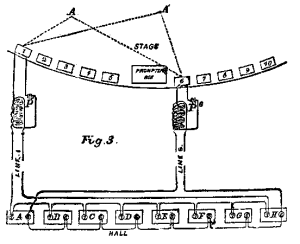 Opera companies have a long history of technological development. Before Avatar, Opéra de Rennes transmitted Mozart’s Don Giovanni live to movie theaters in high-definition stereoscopic 3D. Believe it or not, opera was responsible for the invention of electronic home entertainment (1880), stereo sound transmission (1881), pay cable (1885), consumer headphones (no later than 1888), newscasts (1893), sound movies (1894), stereo broadcasting (1925), stereo networking (1973), and alternative content for stadium displays (2007). Almost no matter whom you pick as the inventor of movies (Edison, Jenkins, Le Prince), their purpose was opera (1886-88). And an opera house was responsible for the development of the techniques of sportscasting (1886). Really!
Opera companies have a long history of technological development. Before Avatar, Opéra de Rennes transmitted Mozart’s Don Giovanni live to movie theaters in high-definition stereoscopic 3D. Believe it or not, opera was responsible for the invention of electronic home entertainment (1880), stereo sound transmission (1881), pay cable (1885), consumer headphones (no later than 1888), newscasts (1893), sound movies (1894), stereo broadcasting (1925), stereo networking (1973), and alternative content for stadium displays (2007). Almost no matter whom you pick as the inventor of movies (Edison, Jenkins, Le Prince), their purpose was opera (1886-88). And an opera house was responsible for the development of the techniques of sportscasting (1886). Really!
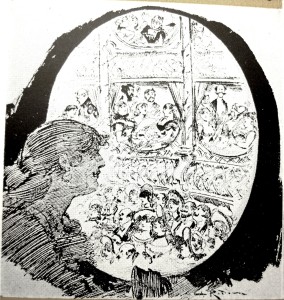 Opera was also present at the inception of electrical robotics (1894), broadcasting (1900), music synthesis (1906), entertainment radio (1906-7), television (1928-1934, proposed in 1882), live alternative content for cinema (1952, proposed in 1877 — before there was such a thing as cinema), widescreen movies (1952), and international satellite broadcasting (1967). In the 17th century, opera stage technology allowed complete scene changes to take place in full view of the audience in a matter of seconds; in the 21st century, opera companies are using live, interactive digital projection with edge stitching, image warping, and even real-time depth-plane selection.
Opera was also present at the inception of electrical robotics (1894), broadcasting (1900), music synthesis (1906), entertainment radio (1906-7), television (1928-1934, proposed in 1882), live alternative content for cinema (1952, proposed in 1877 — before there was such a thing as cinema), widescreen movies (1952), and international satellite broadcasting (1967). In the 17th century, opera stage technology allowed complete scene changes to take place in full view of the audience in a matter of seconds; in the 21st century, opera companies are using live, interactive digital projection with edge stitching, image warping, and even real-time depth-plane selection.
Wiener Staatsoper is part of that tradition of technological innovation. Some of the first buildings lit by electricity were opera houses, and, because there were no power companies at the time, they had their own generators and shared their output. The first X-ray machine at Boston Children’s Hospital was powered from a local opera house. Before that, flame-based lighting could be dangerous, so Wiener Staatoper had its own 21-person fire department and helped pioneer fire extinguishers, so they “could assure patrons of artistic performances  that were both stunning and safe,” according John Nemeth, VP of sales EMEA for Elemental. “Elemental is honored to support Vienna State Opera in its on-going technology innovation to increase access to the arts.”
that were both stunning and safe,” according John Nemeth, VP of sales EMEA for Elemental. “Elemental is honored to support Vienna State Opera in its on-going technology innovation to increase access to the arts.”
67. The First Parabolic Mic (2015 August 28)
You see them all the time in sports video production, but where did the first parabolic mics come from? According to Louis Figuier’s Scientific and Industrial Annual of 1887 (published in 1888), it was invented by engineer Giulio Marini, director of the Telephone Company of Rome. He first tried it during a production of the opera “I puritani” at Rome’s National Theatre. The design allowed the mics to be moved from the stage to the back of the house. According to Figuier, “They completely succeeded: music and song were reproduced with complete sharpness and accuracy.”
Here’s a link to Figuier’s report (page 112): https://books.google.com/books?id=h_w0AAAAMAAJ&pg=PA112
Many thanks to Michael Kaye for calling this to my attention.
68. Sports, Opera, and Pay-Cable (2015 October 9)
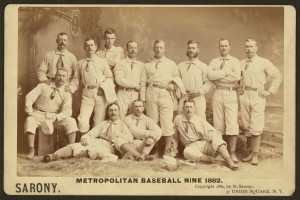 As this is being written, the New York Mets are still contenders for the 2015 baseball championship. They won in 1969 and 1986 after having the worst record in 162-game major-league-season history when they first took the field.
As this is being written, the New York Mets are still contenders for the 2015 baseball championship. They won in 1969 and 1986 after having the worst record in 162-game major-league-season history when they first took the field.
When the team was founded, it was the Metropolitan Baseball Club of New York, a name that originally belonged to a team that, in 1882, accepted offers to join both the National League and the American Association. The owners got around that problem by buying another team and calling them the New York Gothams. The Gothams became the Giants, and it was their move to San Francisco that led to the formation of the current Mets. In between the 19th-century Mets and the current team, the Metropolitan Opera’s baseball team was also known as the Metropolitans or Mets.
 Although not often in first place, the Mets have the distinction of having baseball’s first official live human mascot, Mr. Met, who appeared at their first game at their home at Shea Stadium in 1964. The English word was coined when Edmond Audran’s opera La mascotte, which had opened successfully in Paris at the Théâtre des Bouffes-Parisiens on December 29, 1880, was imported to Boston’s Gaiety Theatre, where it opened in 1881 on April 12 as The Mascot. The root of the French word referred to a witch, but the opera was about a woman who brought luck to a farmer.
Although not often in first place, the Mets have the distinction of having baseball’s first official live human mascot, Mr. Met, who appeared at their first game at their home at Shea Stadium in 1964. The English word was coined when Edmond Audran’s opera La mascotte, which had opened successfully in Paris at the Théâtre des Bouffes-Parisiens on December 29, 1880, was imported to Boston’s Gaiety Theatre, where it opened in 1881 on April 12 as The Mascot. The root of the French word referred to a witch, but the opera was about a woman who brought luck to a farmer.
The original Mets accepting offers from two major leagues at the same time was an echo of what happened when the opera moved to New York at two opera houses, the Bijou on May 5 and the Park on May 9. At the end of the overture on May 5, a man announced from the stage that at 6 pm an injunction had been served on the tenor, preventing his appearance, and named his replacement. The audience “was good-natured and sympathized with the management,” according to the next day’s positive review in The New York Times, and gave the substitute “favor, it being generally understood that he had never even rehearsed the opera and had thrown himself into the breach to save the piece.”
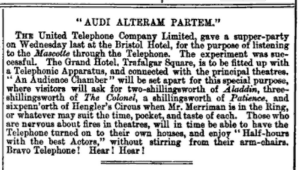 The very successful opera continued to open in more cities — two different opera houses in Chicago, too. In London, it opened at the New Comedy Theatre on October 15. On December 21, the United Telephone Company Limited threw a dinner party at London’s Bristol Hotel for the purpose of listening to The Mascotte via telephone, an introduction to pay cable. By 1882, the year the first Mets joined major-league baseball, the opera was being transmitted from the Theatre Royal in Preston, England, to Manchester, a distance of some 30 miles.
The very successful opera continued to open in more cities — two different opera houses in Chicago, too. In London, it opened at the New Comedy Theatre on October 15. On December 21, the United Telephone Company Limited threw a dinner party at London’s Bristol Hotel for the purpose of listening to The Mascotte via telephone, an introduction to pay cable. By 1882, the year the first Mets joined major-league baseball, the opera was being transmitted from the Theatre Royal in Preston, England, to Manchester, a distance of some 30 miles.
Let’s go, Mets!
69. The First Bootleg Recording (2016 February 24)
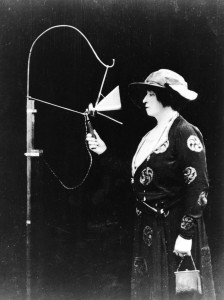 Opera has a long history of bootleg recording. The “Golden Age of Opera” label, begun in the 1950s, used unauthorized off-air recordings from Metropolitan Opera (Met) radio broadcasts. Before that, Wagner-Nichols promoted recorders and recordings of those broadcasts. And Classic Editions issued an opera recording supposedly made in Italy that was, in fact, an off-air recording of a 1947 Met broadcast. The first off-air recording ever was made of opera singer Nellie Melba in 1920 (click to enlarge the images).
Opera has a long history of bootleg recording. The “Golden Age of Opera” label, begun in the 1950s, used unauthorized off-air recordings from Metropolitan Opera (Met) radio broadcasts. Before that, Wagner-Nichols promoted recorders and recordings of those broadcasts. And Classic Editions issued an opera recording supposedly made in Italy that was, in fact, an off-air recording of a 1947 Met broadcast. The first off-air recording ever was made of opera singer Nellie Melba in 1920 (click to enlarge the images).
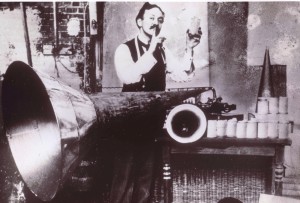 Met librarian Lionel Mapleson has been called “The Father of Bootlegging” for the recordings he made there beginning in 1901, though they were fully known and authorized. But bootleg opera recordings began even earlier.
Met librarian Lionel Mapleson has been called “The Father of Bootlegging” for the recordings he made there beginning in 1901, though they were fully known and authorized. But bootleg opera recordings began even earlier.
The following appeared in The Sun in New York on November 1, 1888. The images here are added. The event was also covered in many other newspapers, from the New-York Daily Tribune to the Oakland Tribune as well as Electrical Review. The Casino, incidentally, is where the opera Cavalleria Rusticana had its New York premiere.
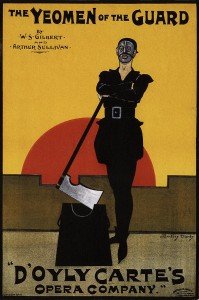 As soon as an opera is produced with any degree of success, especially one by Gilbert and Sullivan, the horseshoe-scarf-pin managers of the never-pay-royalty companies fly to New York and by some trick or device steal the work, and in less than a week astonish our rural cousins with the New York and London success. It is customary for some music publishing firm to arrange with the authors or controllers of successful operas for the publication of a libretto and piano score, and by doing they make it comparatively easy for any one to perform the opera, but in the case of “The Yeomen of the Guard” the libretto only was published, consequently the piratical companies could do nothing with the opera.
As soon as an opera is produced with any degree of success, especially one by Gilbert and Sullivan, the horseshoe-scarf-pin managers of the never-pay-royalty companies fly to New York and by some trick or device steal the work, and in less than a week astonish our rural cousins with the New York and London success. It is customary for some music publishing firm to arrange with the authors or controllers of successful operas for the publication of a libretto and piano score, and by doing they make it comparatively easy for any one to perform the opera, but in the case of “The Yeomen of the Guard” the libretto only was published, consequently the piratical companies could do nothing with the opera.
The average small opera manager is as full of expedients as an egg is of meat and generally finds some way out of a dilemma, especially if a sheriff is the dilemma; but the latest trick, as performed at the Casino last night, is both unique and interesting. Yesterday afternoon Mr. Pollock, the treasurer of the Casino, received a telegram asking that a box be reserved for a Mr. Frank Wilber. One of the lower boxes was reserved, and at eight o’ clock last evening a commercial looking man entered the lobby, hurriedly called for the box, paid the necessary amount and was ushered in.
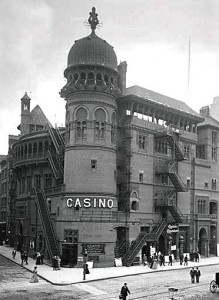 Noticing that the gentleman had a large telescope valise, Mr. Daly, the usher, asked if he should take it to the check room for him, but the gentleman declined to have it checked giving as an excuse that the case contained jewelry, and he preferred to have it remain with him. Very little attention was given to the lone man in the box, and had it not been for the watchfulness of Mr. Daly it is probable that the man and his trickery would have escaped detection. The house was packed to suffocation, and when the finale of the first act was begun Mr. Daly opened some windows in the lobby to give the audience a little fresh air.
Noticing that the gentleman had a large telescope valise, Mr. Daly, the usher, asked if he should take it to the check room for him, but the gentleman declined to have it checked giving as an excuse that the case contained jewelry, and he preferred to have it remain with him. Very little attention was given to the lone man in the box, and had it not been for the watchfulness of Mr. Daly it is probable that the man and his trickery would have escaped detection. The house was packed to suffocation, and when the finale of the first act was begun Mr. Daly opened some windows in the lobby to give the audience a little fresh air.
As he turned from the windows his eye lighted upon a queer-looking machine lying on a chair near the lone man. Daly’s first thought was of dynamite and anarchy, his next of how to remove the disciple of Herr Most and his death dealing machine, his next thought–but before he thought again he had planted the man and his machine in a chair in Mr. Rudolph Aronson’s office and was standing at a respectful distance from him waiting for either the machine to explode or the man to begin a harangue.
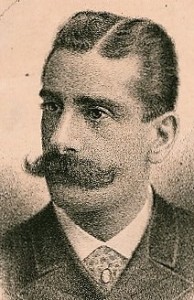 In the office at the time were quite a party of gentlemen chatting with Mr. Aronson, among them being Col. Stark, Dr. Nesbit and Albert Aronson, but they very quickly sought other quarters when Mr. Daly and his charge entered so hurriedly. Mr. Aronson, with his usual coolness and presence of mind, remained seated and awaited developments. The mysterious stranger opened the conversation by saying:
In the office at the time were quite a party of gentlemen chatting with Mr. Aronson, among them being Col. Stark, Dr. Nesbit and Albert Aronson, but they very quickly sought other quarters when Mr. Daly and his charge entered so hurriedly. Mr. Aronson, with his usual coolness and presence of mind, remained seated and awaited developments. The mysterious stranger opened the conversation by saying:
“Well, I guess I’m done for. I suppose you want to know who I am and what I’m doing here. I manage a small opera company, and I desired to include ‘The Yeomen of the Guard’ in my repertoire. I could not obtain the music so I concluded to come here to-night and take it down by the aid of a phonograph. If your precious usher had not been so inquisitive I’d have had the whole blooming opera, but I only got the first act.”
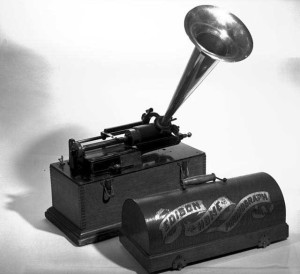 He turned the crank of the mysterious box and it emitted the music of the opera as clearly and distinctly as though the artists and an orchestra were performing it. Mr. Aronson confiscated all the cylinders and told Wilber to go, which he did very quickly.
He turned the crank of the mysterious box and it emitted the music of the opera as clearly and distinctly as though the artists and an orchestra were performing it. Mr. Aronson confiscated all the cylinders and told Wilber to go, which he did very quickly.
70. Happy 54th Birthday, Rossini, Fax Pioneer (2016 February 29)
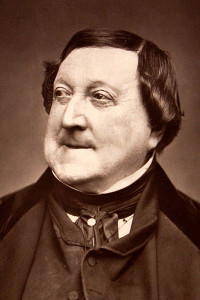 Gioachino Rossini, composer of such operas as Il barbiere di Siviglia (The Barber of Seville) and Guglielmo Tell (William Tell), was born on February 29, 1792, which means today is his 54th birthday (there was no February 29 in 1800 or 1900). Besides being a brilliant opera composer, he was also a pioneer of image transmission technology.
Gioachino Rossini, composer of such operas as Il barbiere di Siviglia (The Barber of Seville) and Guglielmo Tell (William Tell), was born on February 29, 1792, which means today is his 54th birthday (there was no February 29 in 1800 or 1900). Besides being a brilliant opera composer, he was also a pioneer of image transmission technology.
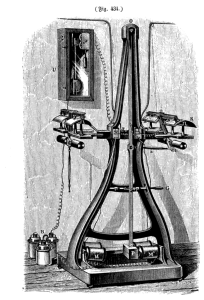 On January 22, 1860, Rossini transmitted a sheet of music he composed for his friend Giovanni Caselli from Paris to Amiens via the latter’s pantelegraph (fax machine), shown at left. It was probably the first fax transmission of sheet music, which had to be drawn — staff lines and all — in insulating ink on a sheet of metal.
On January 22, 1860, Rossini transmitted a sheet of music he composed for his friend Giovanni Caselli from Paris to Amiens via the latter’s pantelegraph (fax machine), shown at left. It was probably the first fax transmission of sheet music, which had to be drawn — staff lines and all — in insulating ink on a sheet of metal.
Rossini died in France in 1868 and was buried in Paris. In 1887, at the request of the Italian government, his remains were moved to Florence. In association with his homecoming, the Philological Club exhibited artifacts associated with his life, from manuscripts and photographs to a lock of his hair and his comb. Among the exhibits were the original and faxed copy of the 1860 music.
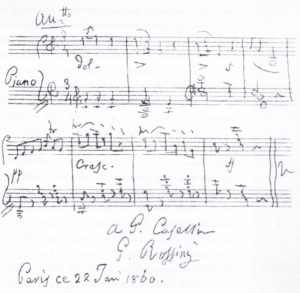 At right is an image of Rossini’s fax (click to enlarge). And here is a link to the music being played.
At right is an image of Rossini’s fax (click to enlarge). And here is a link to the music being played.
The first fax patent, incidentally, was issued in Britain in 1843, and, because it introduced image scanning, it won an Emmy award for its inventor, Alexander Bain, last month. Here’s the BBC report on the arrival of the award in Kirkintilloch, Scotland.
71. The Impresario Who Invented the Movie Theatre
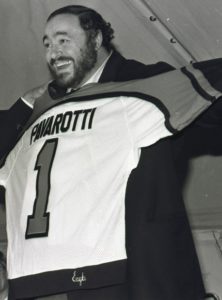 A long time ago, I worked on a television show featuring opera star Luciano Pavarotti singing at the Spectrum arena, home of the Philadelphia Flyers hockey team. The concert was performed between games, so flooring was laid over the ice, and the stage and seats over that. It wasn’t the first time opera had been performed in a hockey arena.
A long time ago, I worked on a television show featuring opera star Luciano Pavarotti singing at the Spectrum arena, home of the Philadelphia Flyers hockey team. The concert was performed between games, so flooring was laid over the ice, and the stage and seats over that. It wasn’t the first time opera had been performed in a hockey arena.
Manru, a relatively obscure opera written by the famous Polish pianist Ignacy Jan Paderewski, had its world premiere in Germany in May of 1901. Less than a year later, it was performed by the Metropolitan Opera at Pittsburg’s Duquesne Garden hockey arena, one of only eight performances in the company’s history [officially, Pittsburgh had no h 1890-1911]. The Met performed five different operas at the Garden that year and another four the next. But that wasn’t Pittsburgh’s first opera at an indoor hockey arena.
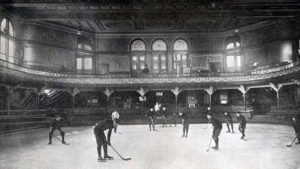 The first indoor ice rink in Pittsburgh was at the Schenley Park Casino, where the Casino Comic Opera Company performed. The company was created by Harry Davis, who had previously hosted the Met at his Grand Opera House in Pittsburg, one of several theatres he ran in the city.
The first indoor ice rink in Pittsburgh was at the Schenley Park Casino, where the Casino Comic Opera Company performed. The company was created by Harry Davis, who had previously hosted the Met at his Grand Opera House in Pittsburg, one of several theatres he ran in the city.
In 1896, Davis presented the first projected movies in Pittsburg at his Avenue Theatre, using the Lumières’ Cinematographe (the same day movies were projected at the nearby Bijou Theatre using the Edison-promoted Vitagraph). By the end of the year, Davis had created his own Zinematographe movie system and used it to shoot a reentactment in Pittsburg of the boxing match between Peter Maher and Joe Choynski in New York (the fact that the same contenders were only acting got around questions of legality of fights).
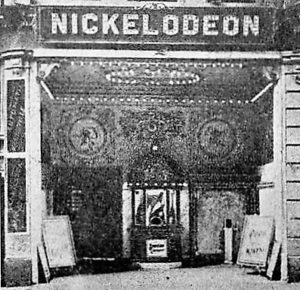 One of Davis’s employees, Richard A. Rowland, who started as an assistant spotlight operator at age 12, suggested showing movies at the Grand Opera House, too. Davis eventually dedicated a room to projected movies at an arcade he ran next to one of his theatres. After the arcade burned down, he, and his partner and brother-in-law John Harris, opened a storefront theatre in 1905, with 96 “opera seats,” dedicated to nothing but projected movies. It was open almost 16 hours a day, but employees (in nice uniforms) worked eight-hour shifts. The admission fee was five cents, so it was called the Nickelodeon.
One of Davis’s employees, Richard A. Rowland, who started as an assistant spotlight operator at age 12, suggested showing movies at the Grand Opera House, too. Davis eventually dedicated a room to projected movies at an arcade he ran next to one of his theatres. After the arcade burned down, he, and his partner and brother-in-law John Harris, opened a storefront theatre in 1905, with 96 “opera seats,” dedicated to nothing but projected movies. It was open almost 16 hours a day, but employees (in nice uniforms) worked eight-hour shifts. The admission fee was five cents, so it was called the Nickelodeon.
It was neither the first dedicated movie theatre nor the first place called a nickelodeon, but it was the first long-lasting one, and it was amazingly successful and influential. A Polish visitor who saw it brought the dedicated movie-theatre concept to Europe. Carl Laemmle, co-founder of Universal Studios, opened his White Front Theatre in Chicago based on the Pittsburgh Nickelodeon. A Pittsburg suit salesperson, Harry Warner, opened a movie theatre in nearby New Castle with his brothers. A jeweler across the street, Lewis Seleznick, went into movie production; his son, David O. Selznick, is probably best known as the producer of Gone with the Wind.
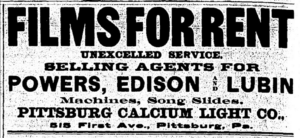 Rowland took over his father’s theatrical supply company and added a film exchange. In 1910, he sold it for “more money than I thought existed” and went on to found companies that became important parts of MGM, Paramount, and Warner Bros. and to run Fox and have executive positions at such other studios as Republic and RKO. Inspired by Rowland’s success, the Warner brothers opened their own Pittsburg film exchange before moving to Hollywood.
Rowland took over his father’s theatrical supply company and added a film exchange. In 1910, he sold it for “more money than I thought existed” and went on to found companies that became important parts of MGM, Paramount, and Warner Bros. and to run Fox and have executive positions at such other studios as Republic and RKO. Inspired by Rowland’s success, the Warner brothers opened their own Pittsburg film exchange before moving to Hollywood.
As for Davis, Musical America called him the “impresario of the hour” in 1918 and recommended him for a national “hero medal” for bringing opera to the masses outside New York, Chicago, and Boston and for ticket prices starting at 25 cents. “I believe in opera,” he said. “Its medium is a great education for the people.”
72. The Polish Polymath Who Came Up with Opera for Television — in 1878 (2017 February 10)
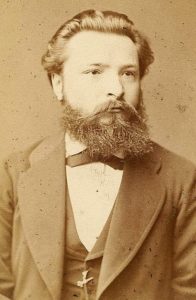 His name was Julijan Ochorowicz (though his first name was also spelled Julian or even Julien), and he was, among other things, a scientist, engineer, mathematician, inventor (credited with the first hands-free telephone), economist, linguist, Egyptologist, philosopher, poet, teacher, paranormal-phenomena investigator, and pioneer of experimental and clinical psychology. His first thesis was on the history of human brain sizes; his second, earning him a doctorate from Leipzig University, was on conditions of consciousness. In 1877, he published a paper on respiration in the journal Kosmos. On February 10, 1878, in the same journal, he submitted a very different paper, which was soon published. It was called (translated, with assistance from Google and native speakers, from the original 19th-century Polish), “On the possible construction of a device for transmitting optical images at any distance.” The rationale for the device? Delivering the visual element of opera.
His name was Julijan Ochorowicz (though his first name was also spelled Julian or even Julien), and he was, among other things, a scientist, engineer, mathematician, inventor (credited with the first hands-free telephone), economist, linguist, Egyptologist, philosopher, poet, teacher, paranormal-phenomena investigator, and pioneer of experimental and clinical psychology. His first thesis was on the history of human brain sizes; his second, earning him a doctorate from Leipzig University, was on conditions of consciousness. In 1877, he published a paper on respiration in the journal Kosmos. On February 10, 1878, in the same journal, he submitted a very different paper, which was soon published. It was called (translated, with assistance from Google and native speakers, from the original 19th-century Polish), “On the possible construction of a device for transmitting optical images at any distance.” The rationale for the device? Delivering the visual element of opera.
Ochorowicz’s paper was not the first published about what we today call television and not even the first invoking television for opera. Even Ochorowicz reportedly worked on television in 1877; I’m awaiting the availability of some research material about that.
As for the earliest publication on what we today call television (and its use for opera), on March 30, 1877, the newspaper The Sun in New York City carried a letter from someone using the pen name “Electrician” about the wonders of a television-like device called the “electroscope.” Part of the letter had this: “Both telephone and electroscope applied on a large scale would render it possible to represent at one time on a hundred stages in various parts of the world the opera… sung… in any given theatre.” That’s a reasonable description of today’s global transmissions of live opera to cinemas and other auditoriums.
“Electrician” cited opera, however, as just one possible application of the “electroscope” and never claimed to be its inventor; he or she attributed it to “an eminent scientist of this city” who was “on the point of publishing….” The letter nevertheless gave an explanation of the technology involved, comprising argle-bargle about the cameras being “boxes, or rooms, according to the size required” with “quasi electric wires of a peculiar make and consistency” and the displays “being constantly kept filled with a newly discovered gas, a sort of magnetic-electric ether, in which the currents of light or color become resplendent again….”
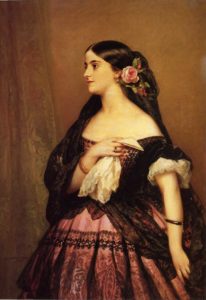 In contrast, Ochorowicz, who was clearly aware of the latest technological developments, presented only opera as the reason to invent what he called a “telephotoscope” (“telefotoskop” in the original Polish). The same year that Thomas Edison indicated that the main purpose of the phonograph was dictation, Ochorowicz wrote that both the telephone and the phonograph offered the delightful possibility of hearing performances by opera diva Adelina Patti at home.
In contrast, Ochorowicz, who was clearly aware of the latest technological developments, presented only opera as the reason to invent what he called a “telephotoscope” (“telefotoskop” in the original Polish). The same year that Thomas Edison indicated that the main purpose of the phonograph was dictation, Ochorowicz wrote that both the telephone and the phonograph offered the delightful possibility of hearing performances by opera diva Adelina Patti at home.
Here’s my attempted (assisted by Google and native Polish speakers) translation of what Ochorowicz wrote next. “What a pleasure to me that sitting in Lwów I could listen to Italian opera in Paris, but I would see neither performers nor sets nor impressions on the faces of the audience nor costumes — in a word, nothing!
“That cannot be. After telephony and recording, we need to invent the telephotoscope.”
![]() Ochorowicz went on to analyze the technology needed (click images to enlarge). First, “Find a way to convert variations in light intensity into an electrical signal.” He reported on the latest work in this area, including the selenium-based “artificial eye” recently demonstrated by William Siemens.
Ochorowicz went on to analyze the technology needed (click images to enlarge). First, “Find a way to convert variations in light intensity into an electrical signal.” He reported on the latest work in this area, including the selenium-based “artificial eye” recently demonstrated by William Siemens.
 Second, find a way to get the signal into a single wire. “Electrician” proposed only twisting “many thousands of wires” into a cable; “On entering the receiver the cable is untwisted….” Ochorowicz instead turned to the image scanning already in use in “Caselli’s Pantelegraph,” a still-image fax-like transmission system that went into commercial service in France in 1865 and that opera-composer Gioachino Rossini had used to transmit sheet music over long distances starting on January 22, 1860.
Second, find a way to get the signal into a single wire. “Electrician” proposed only twisting “many thousands of wires” into a cable; “On entering the receiver the cable is untwisted….” Ochorowicz instead turned to the image scanning already in use in “Caselli’s Pantelegraph,” a still-image fax-like transmission system that went into commercial service in France in 1865 and that opera-composer Gioachino Rossini had used to transmit sheet music over long distances starting on January 22, 1860.
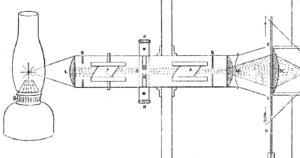 Last, Ochorowicz tackled the problem of converting the electrical signal back to light. It’s a little difficult for me to tell from the 19th-century Polish (Google Translate has a hard time, too), but it appears that Ochorowicz might have been referring to a polarization-rotation light valve based on the recently discovered Kerr effect. “And here at once the eyes of the viewer will be released within the Paris Opera House,” and, with the addition of appropriate projection lenses, the image “can be enlarged for the whole audience in a theater.”
Last, Ochorowicz tackled the problem of converting the electrical signal back to light. It’s a little difficult for me to tell from the 19th-century Polish (Google Translate has a hard time, too), but it appears that Ochorowicz might have been referring to a polarization-rotation light valve based on the recently discovered Kerr effect. “And here at once the eyes of the viewer will be released within the Paris Opera House,” and, with the addition of appropriate projection lenses, the image “can be enlarged for the whole audience in a theater.”
73. Virtual Reality Opera (2017 June 27)
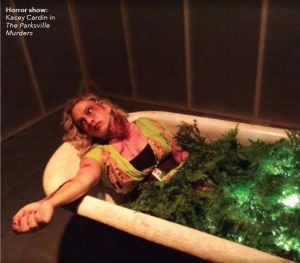 The current (Summer 2017) issue of Opera America has a brief story about the first virtual-reality opera, The Parksville Murders, by Kamala Sankaram and Jerre Dye, produced by Brooklyn’s Opera on Tap with Light Sail VR. It is said to have won best virtual reality video at the NYC Independent Film Festival. Here’s the opera’s website.
The current (Summer 2017) issue of Opera America has a brief story about the first virtual-reality opera, The Parksville Murders, by Kamala Sankaram and Jerre Dye, produced by Brooklyn’s Opera on Tap with Light Sail VR. It is said to have won best virtual reality video at the NYC Independent Film Festival. Here’s the opera’s website.
The article notes that Chicago Opera Theater had come up with the idea of using VR to promote Stewart Copeland’s The Invention of Morel and that Boston Lyric Opera used a 360-degree camera for a rehearsal of “The Rake’s Progress.”
Resources:
Illustrated Media-Technology and Opera Chronology
Metropolitan Opera Live in HD tech info
Tags: Ansonia, Antoine Claudet, Cinerama, Clement Ader, digital audio history, Edward P. Fry, Enrico Caruso, Fandom of the Opera, film sound history, first broadcast rights, first electronic home entertainment, first film score, first laryngoscope, first musical synthesizer, Guinness collection, HDTV opera history, Horace Short, John Goberman, Jules Duboscq, Kirk Browning, lip-synching, Louis Daguerre, matchbooks, media opera history, media technology history, Media-Technology and Opera History, Millerfilm, million-selling record, opera baseball, opera history, opera lighting history, opera media history, recording history, Rosabel Morrison, subtitling, telephone opera, Thomas Stockham, Tivadar Puskas, Tom Swift,

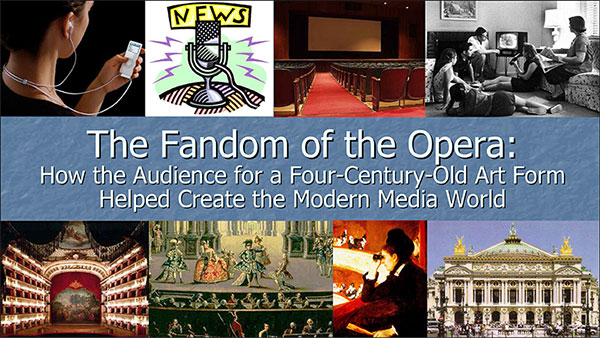
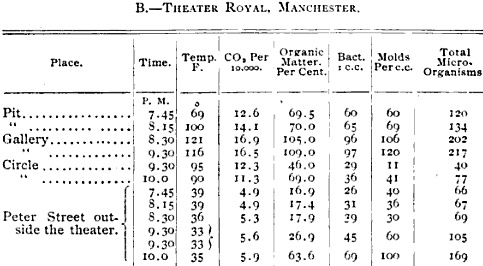


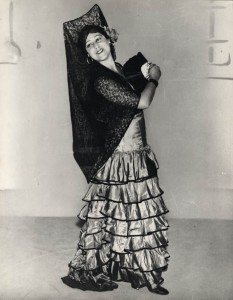

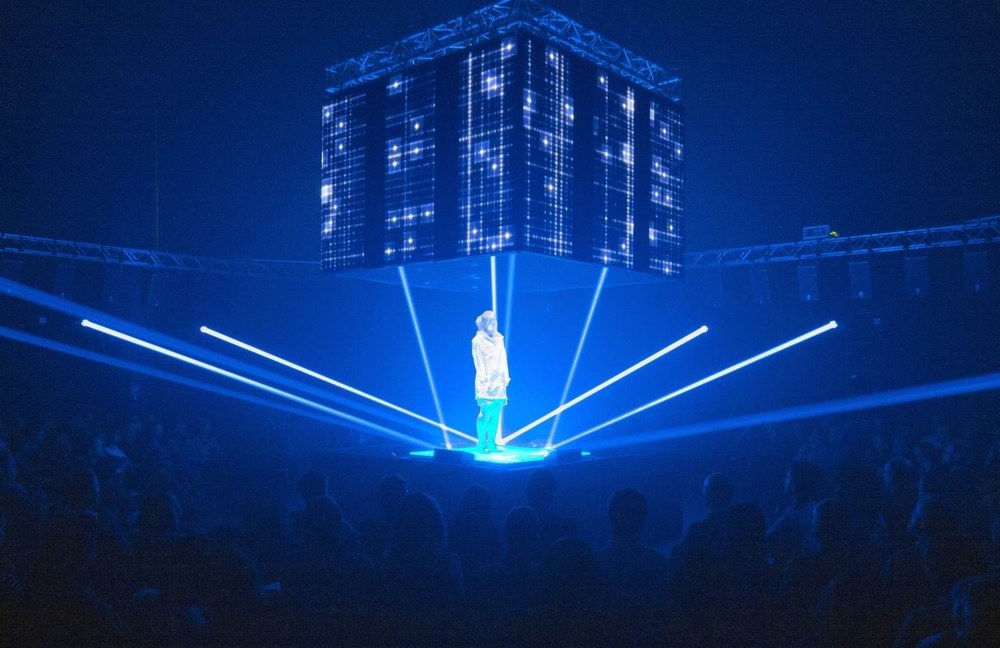
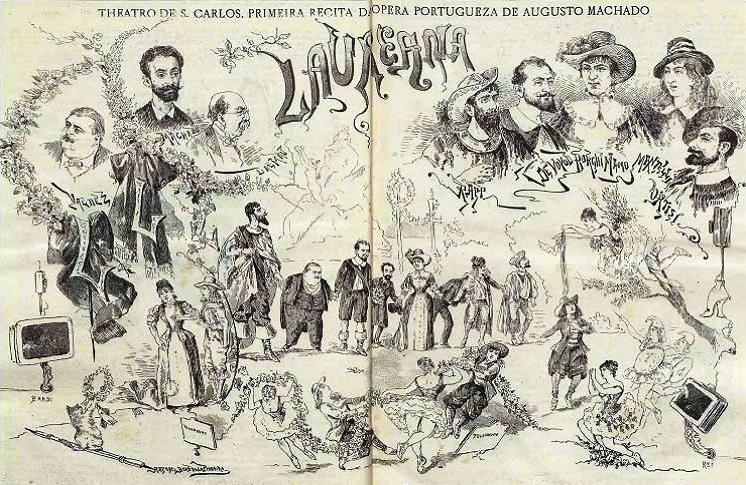
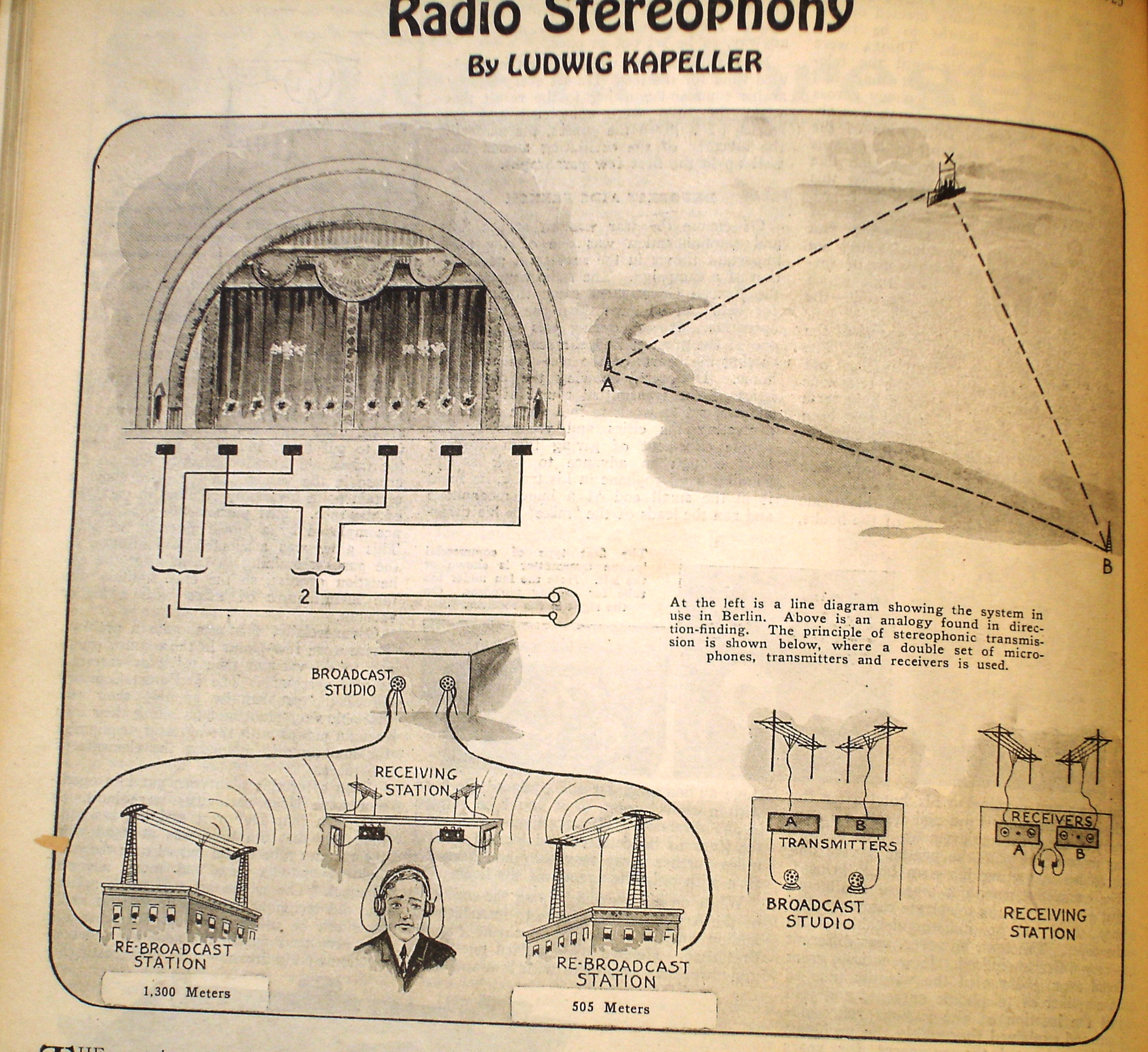
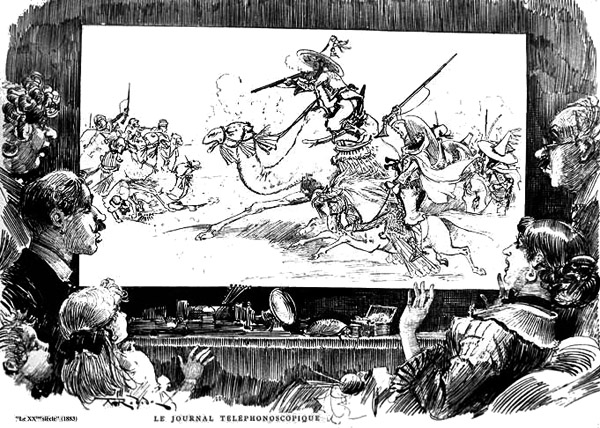
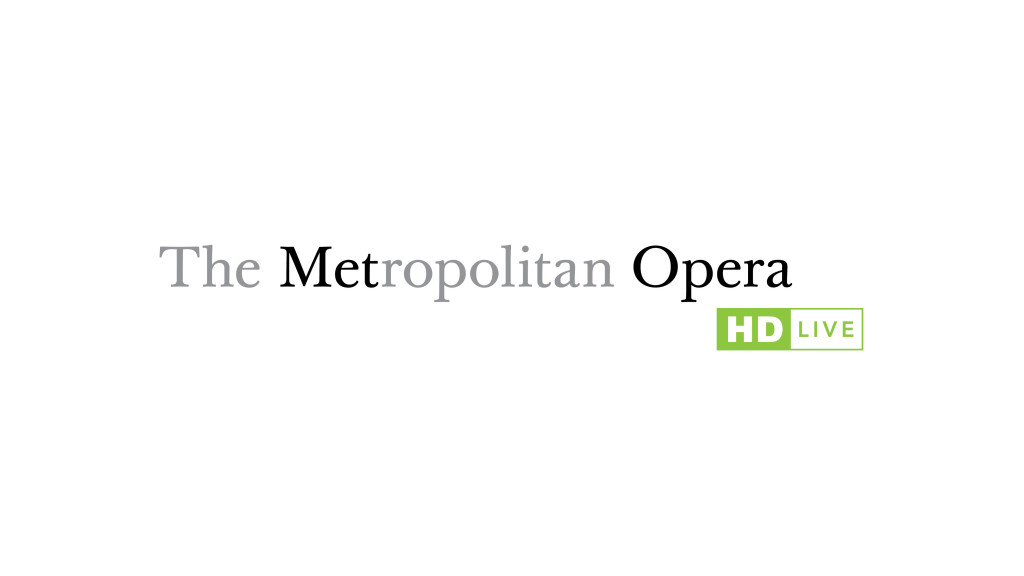
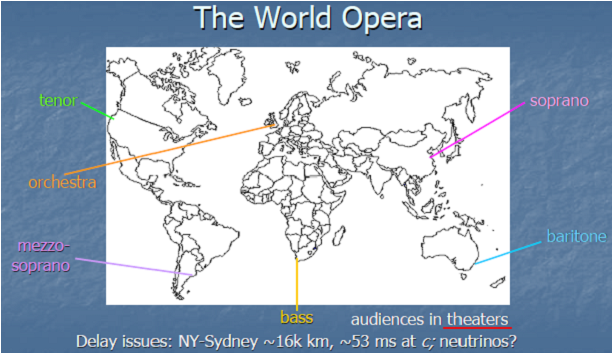
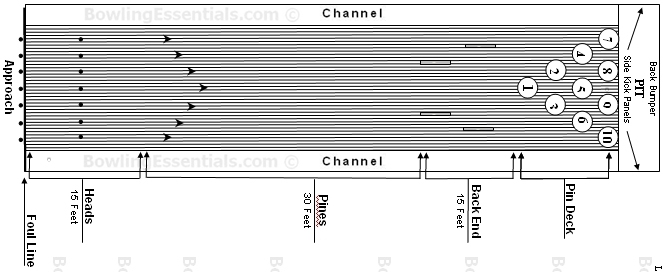
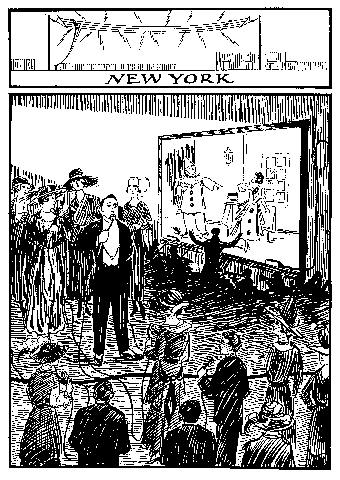
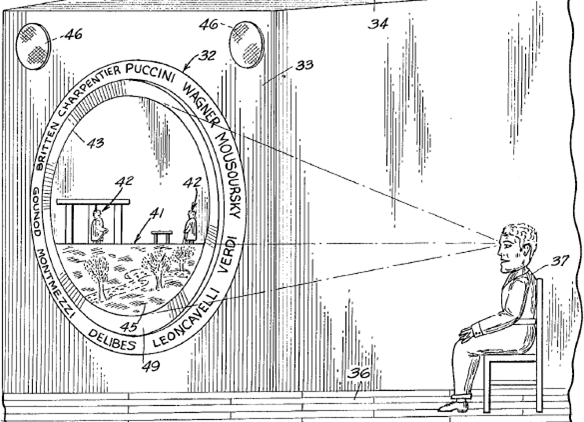


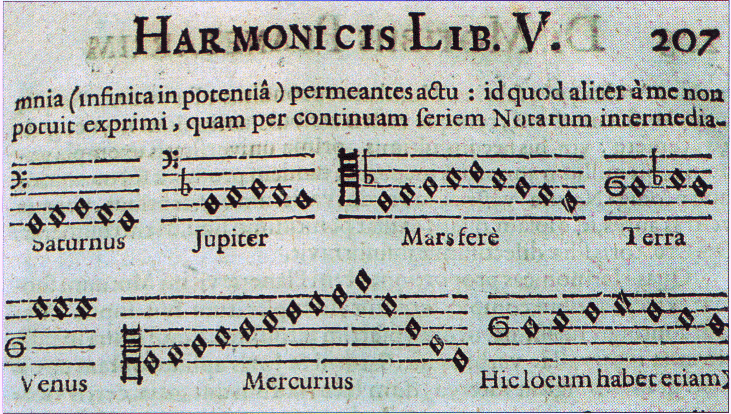
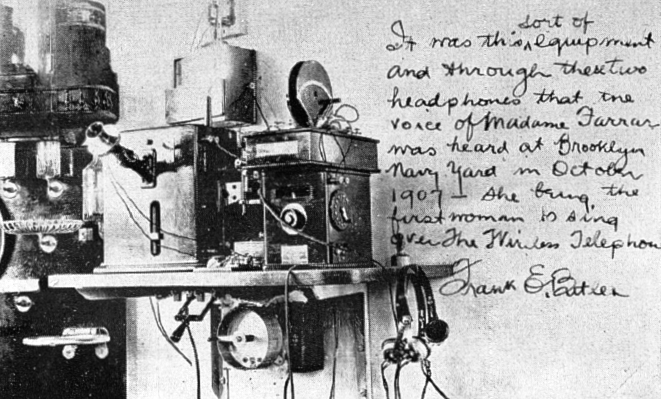
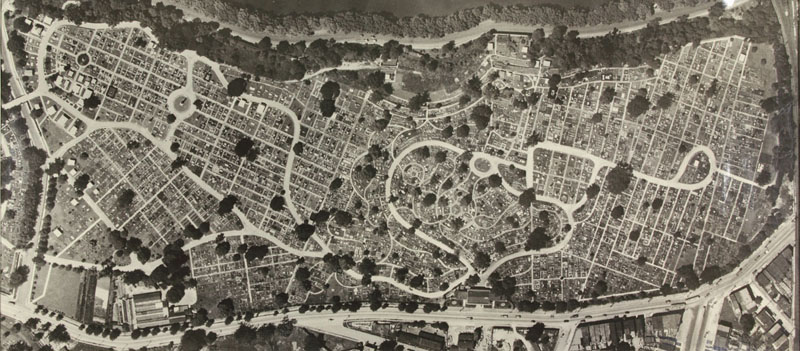

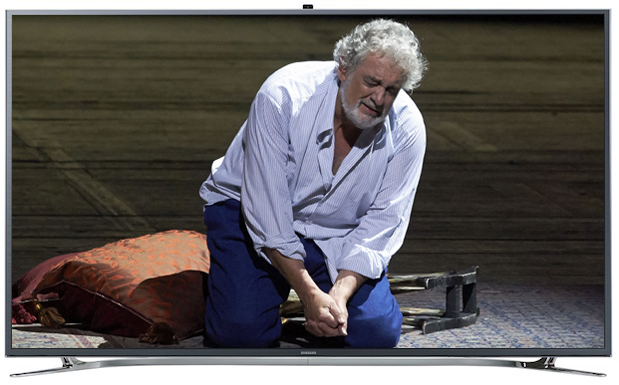
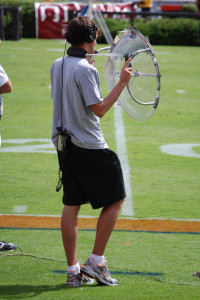
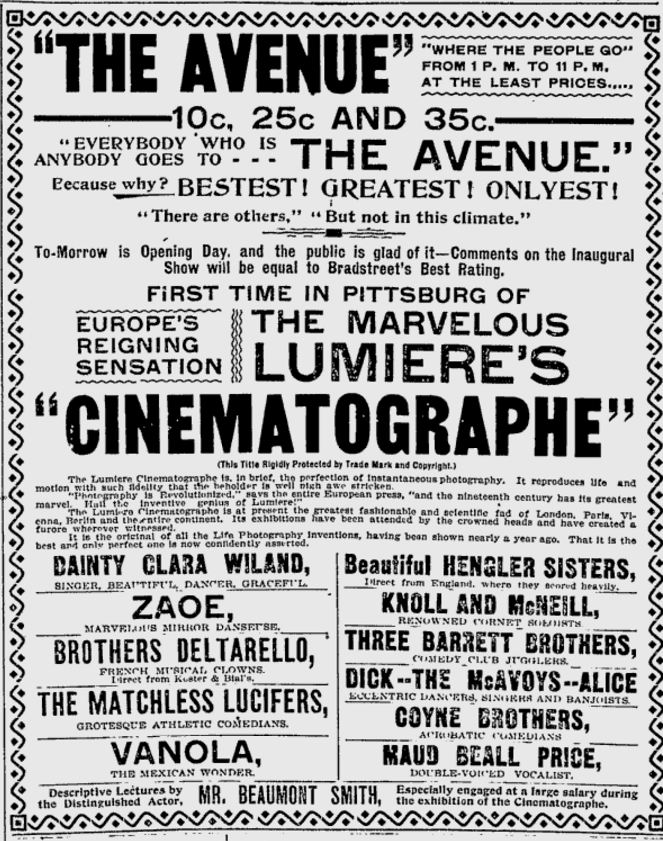
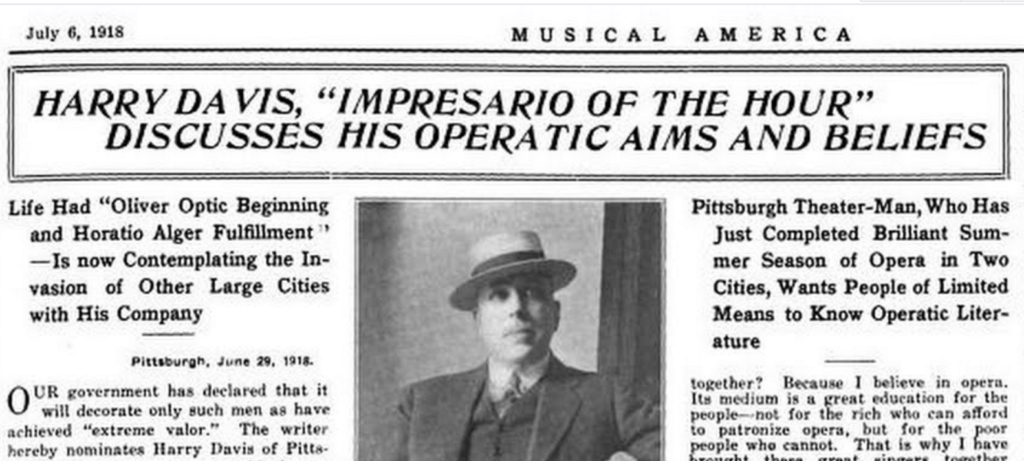
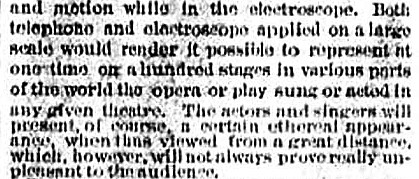
No comments yet. You should be kind and add one!
The comments are closed.